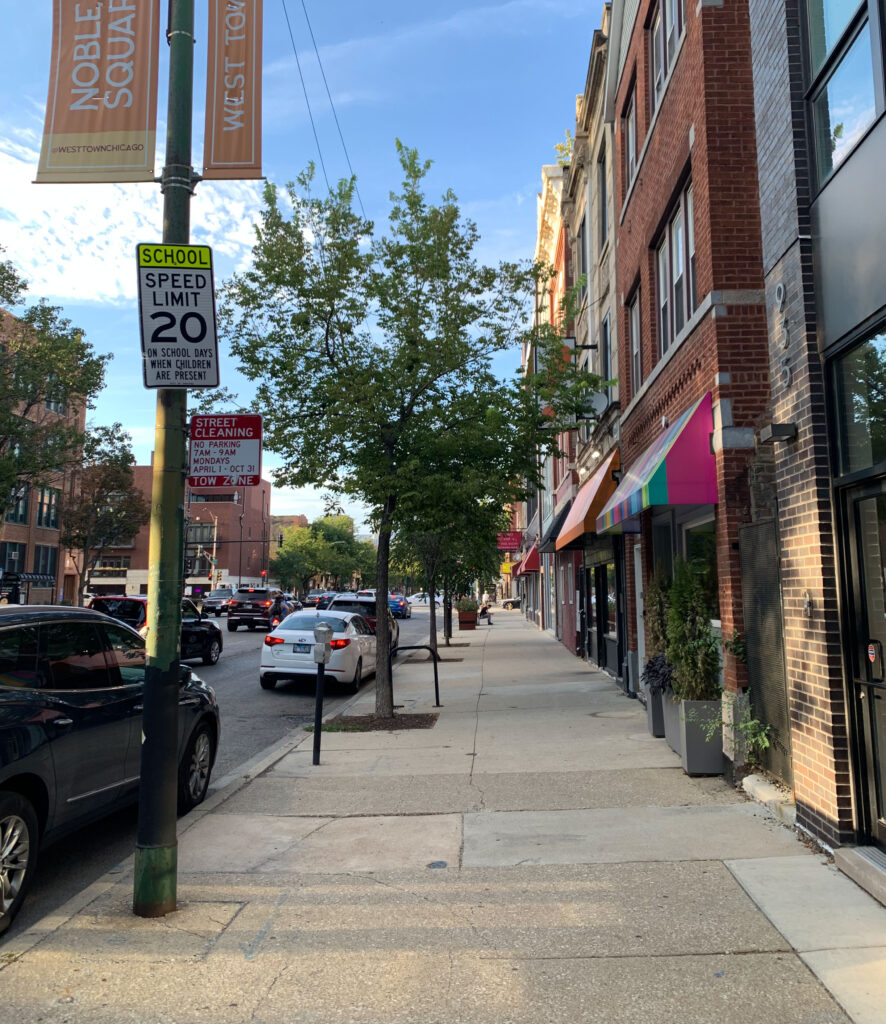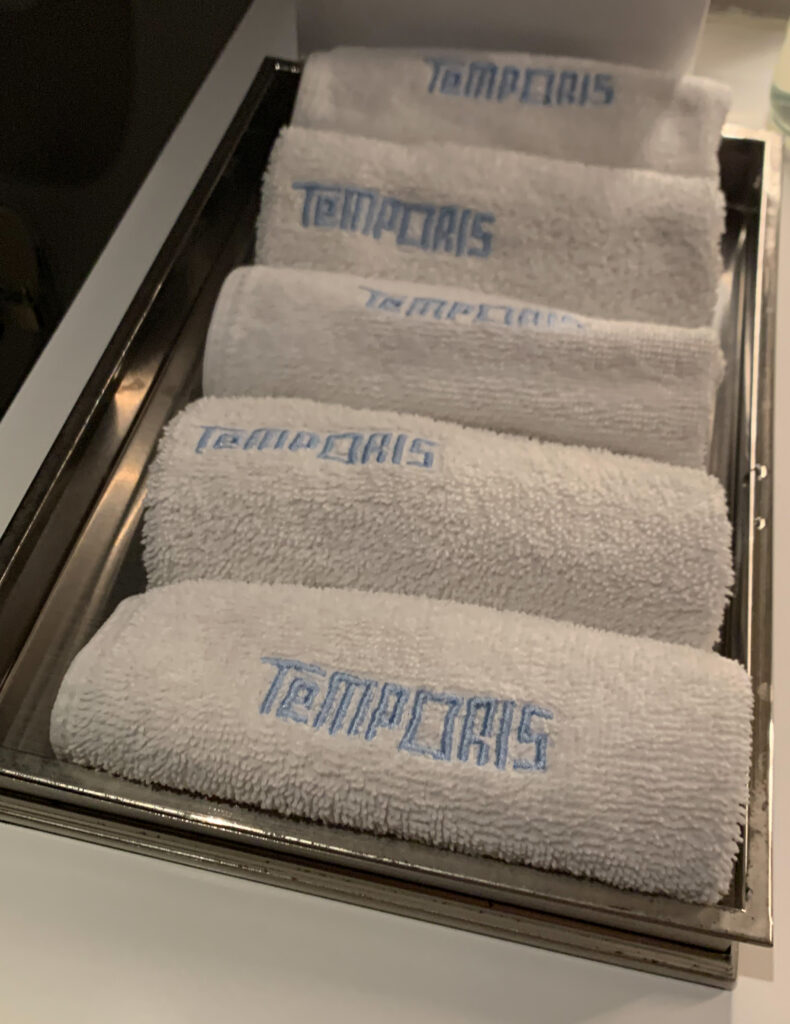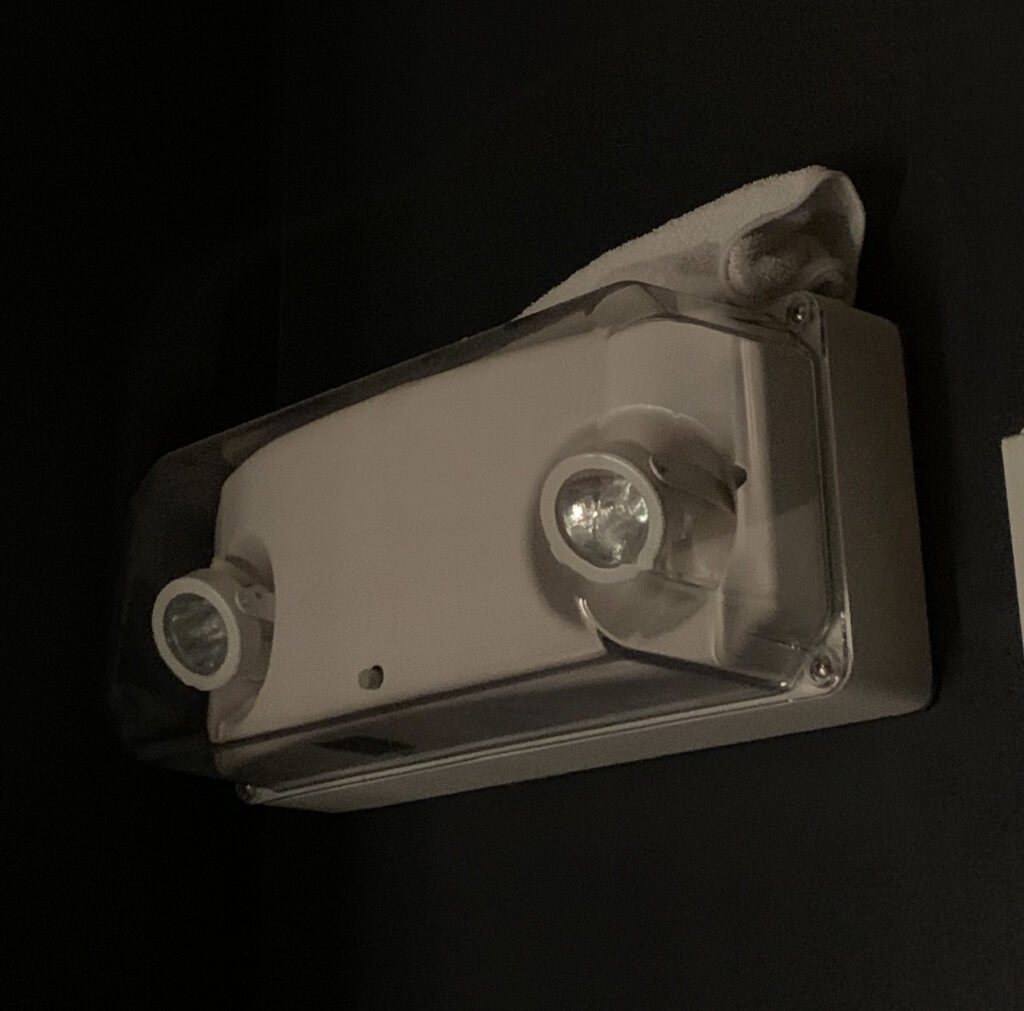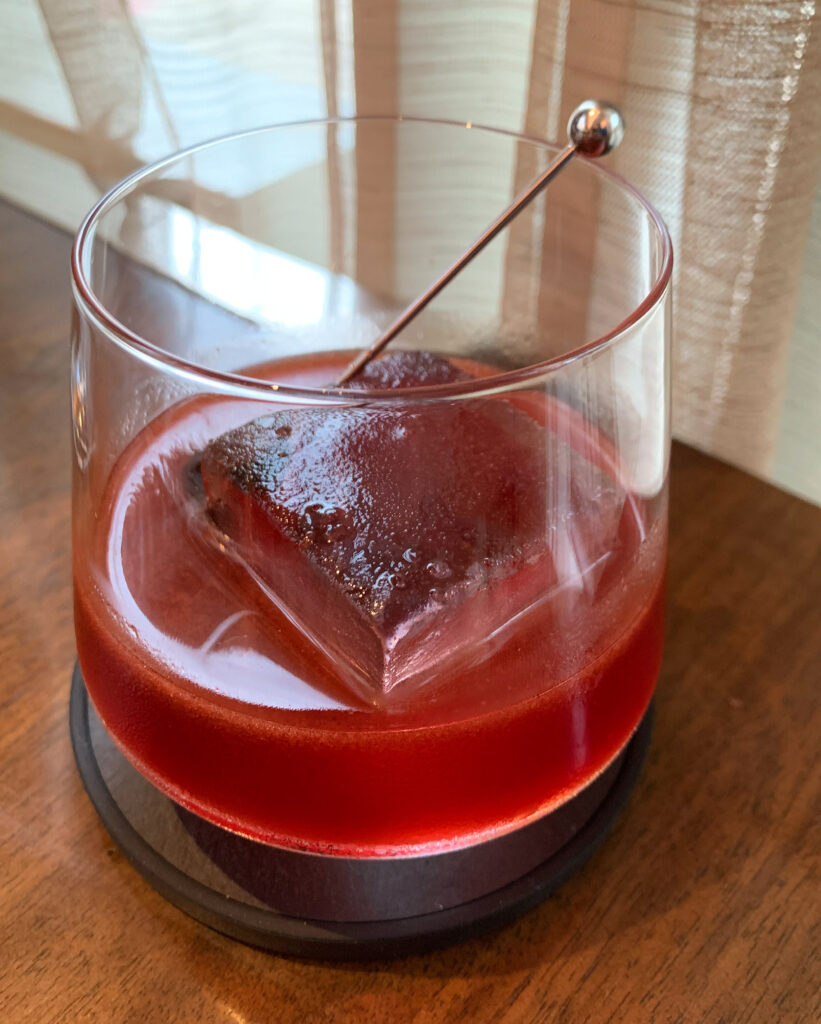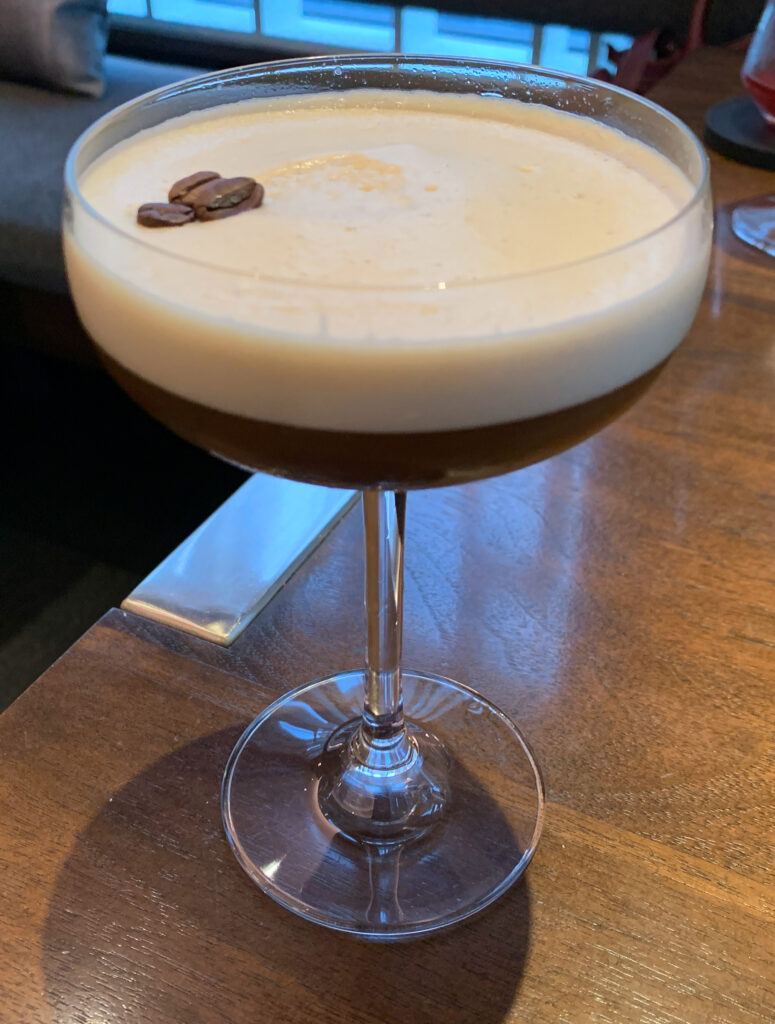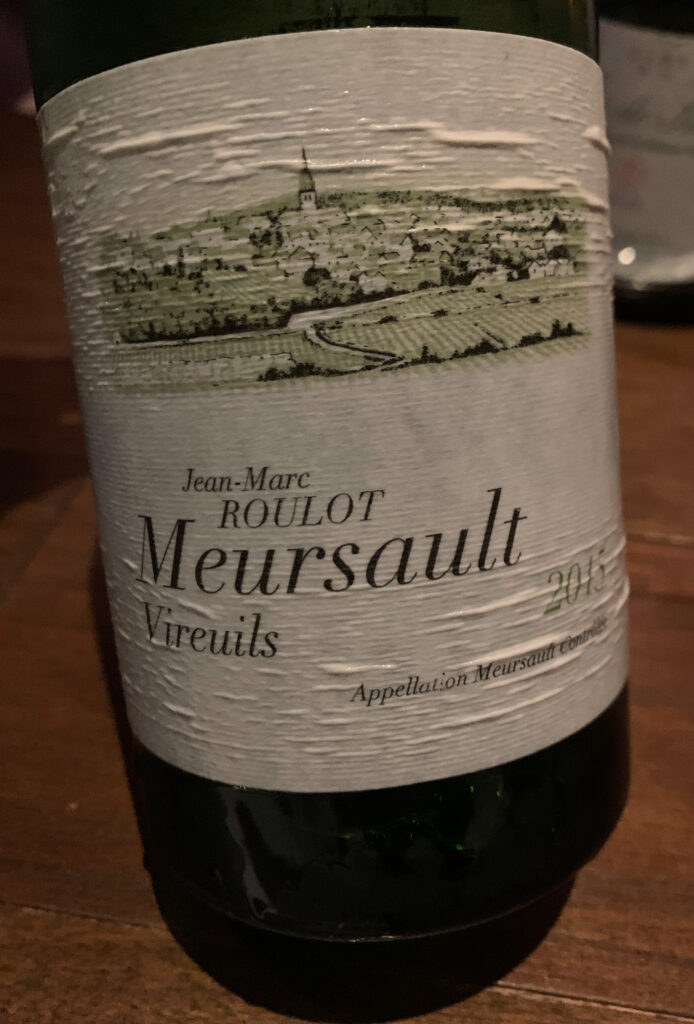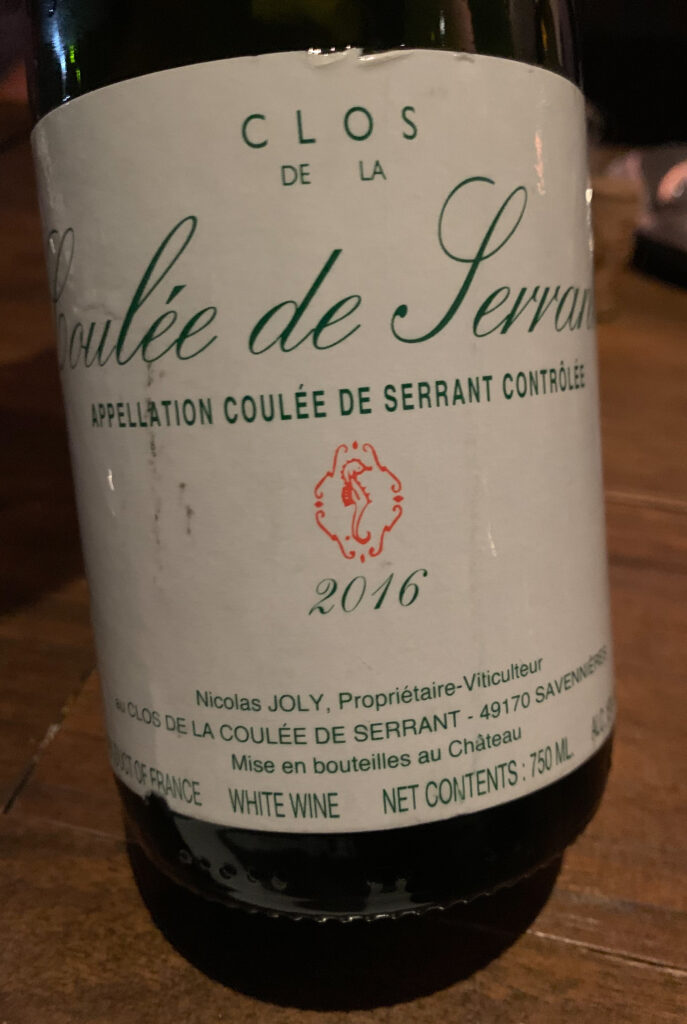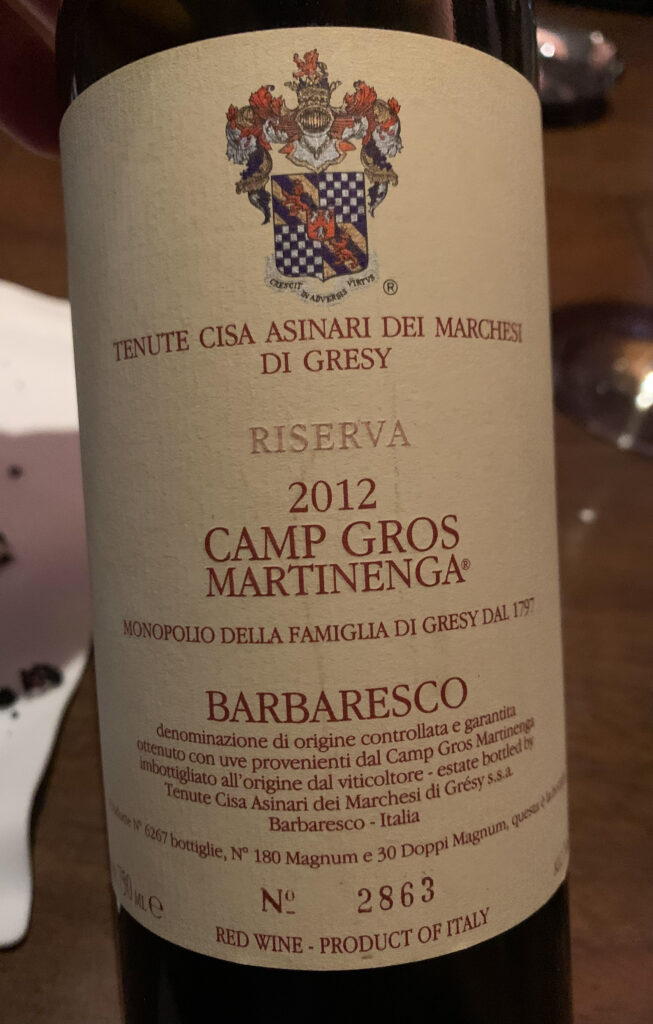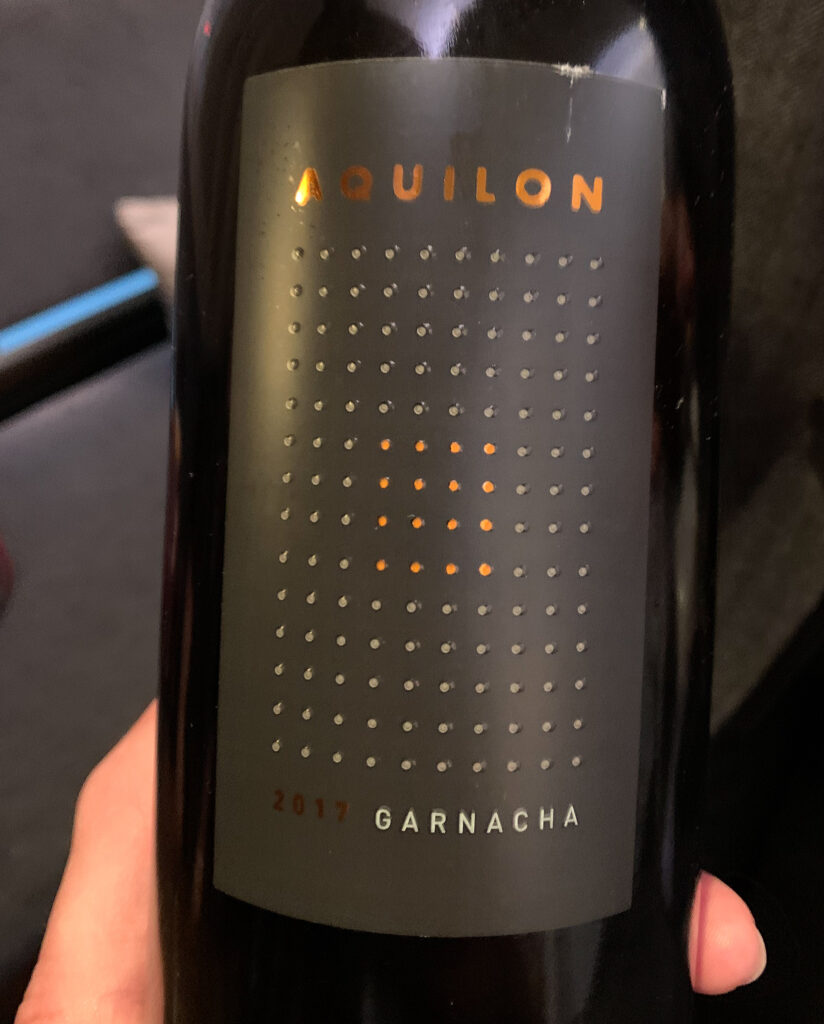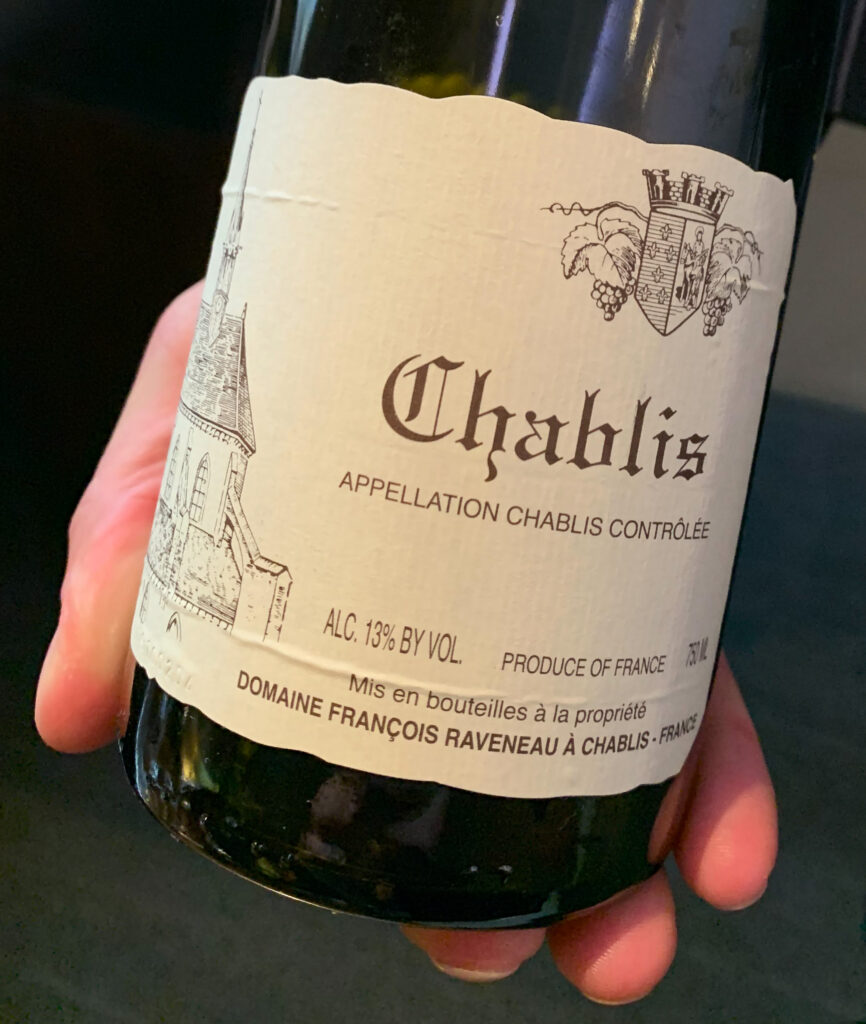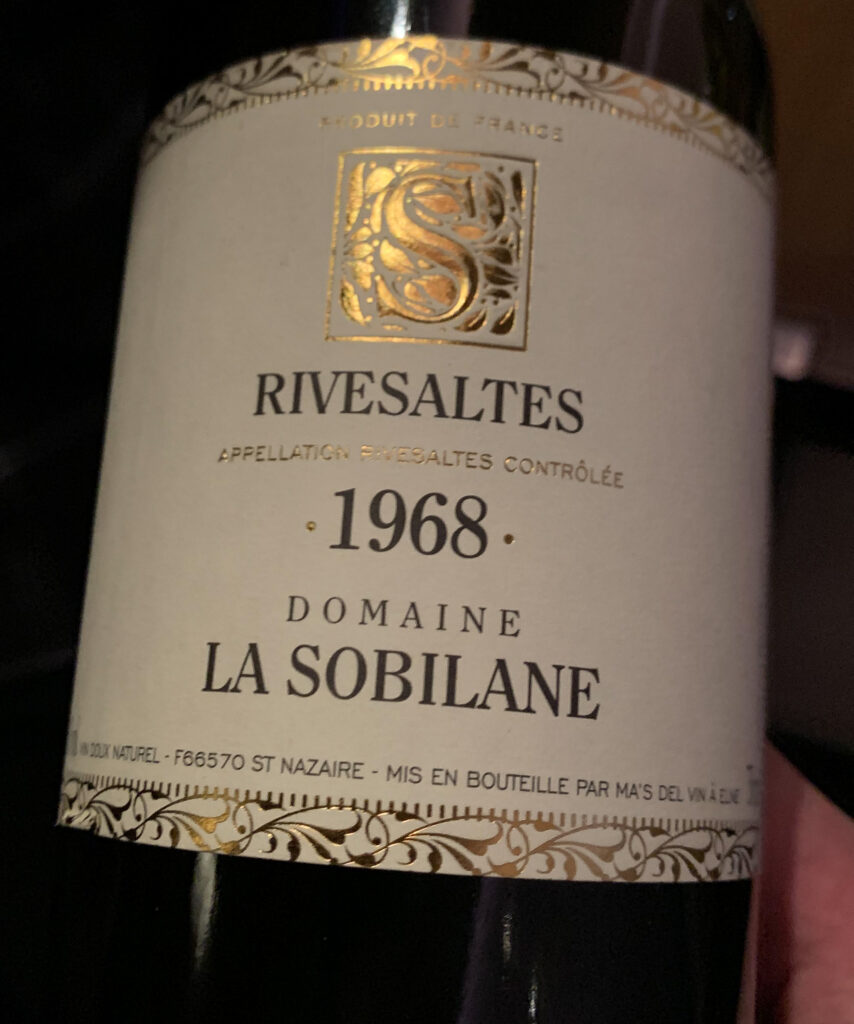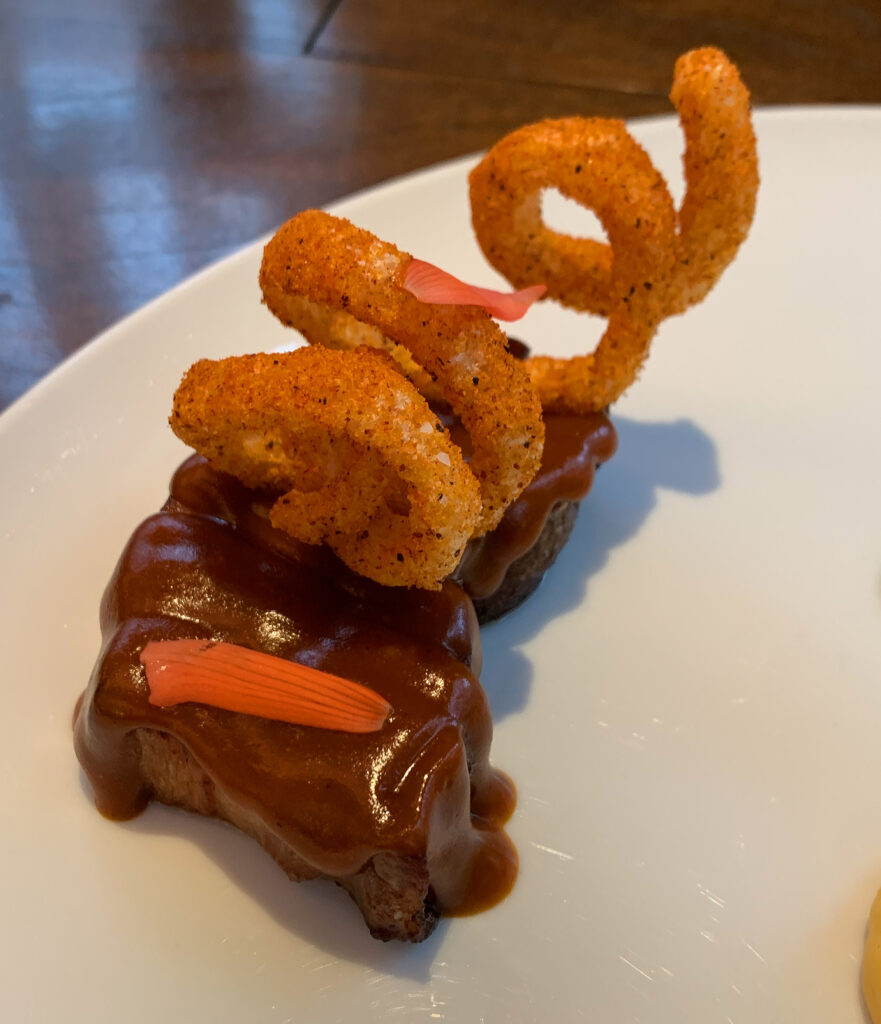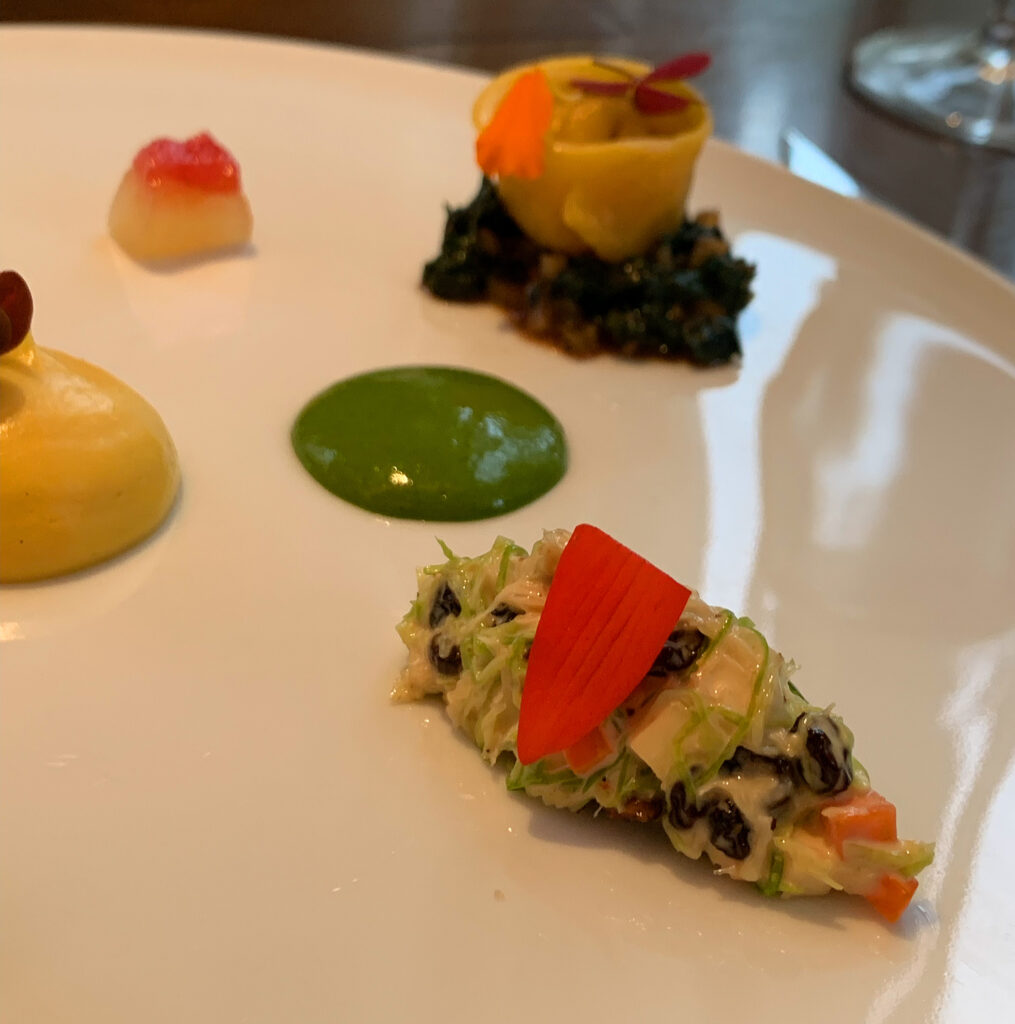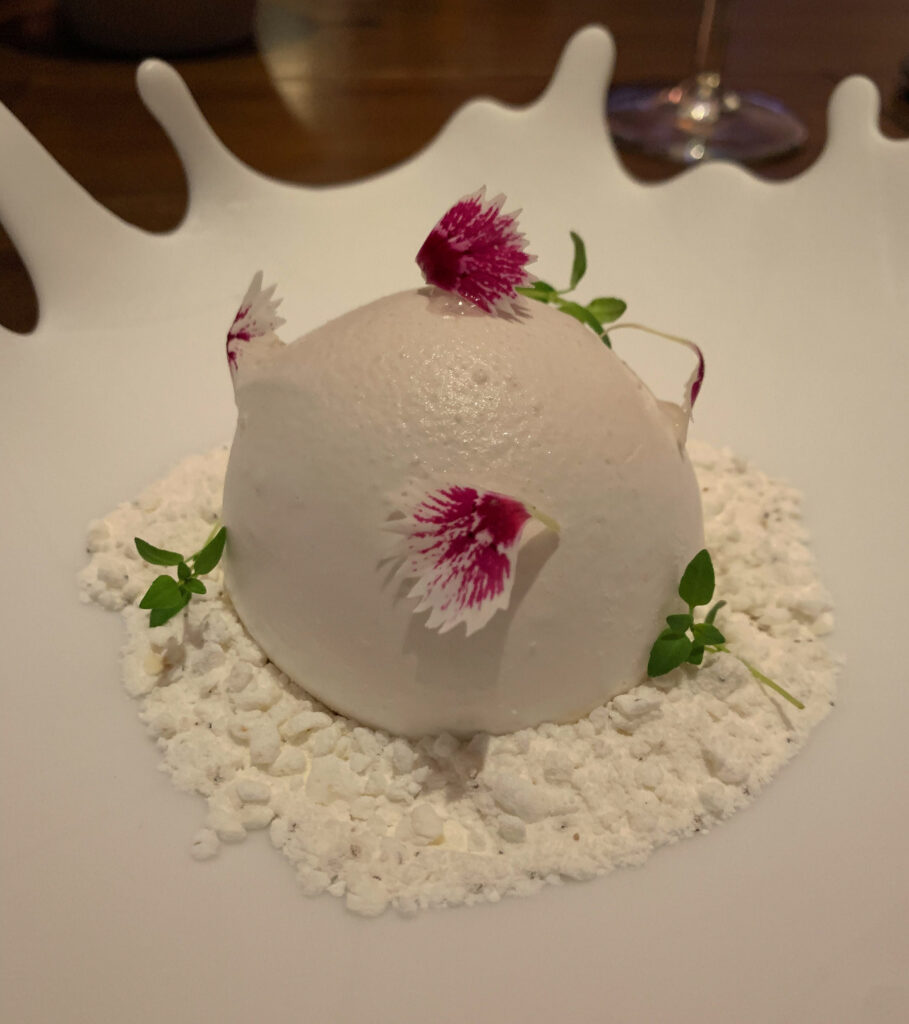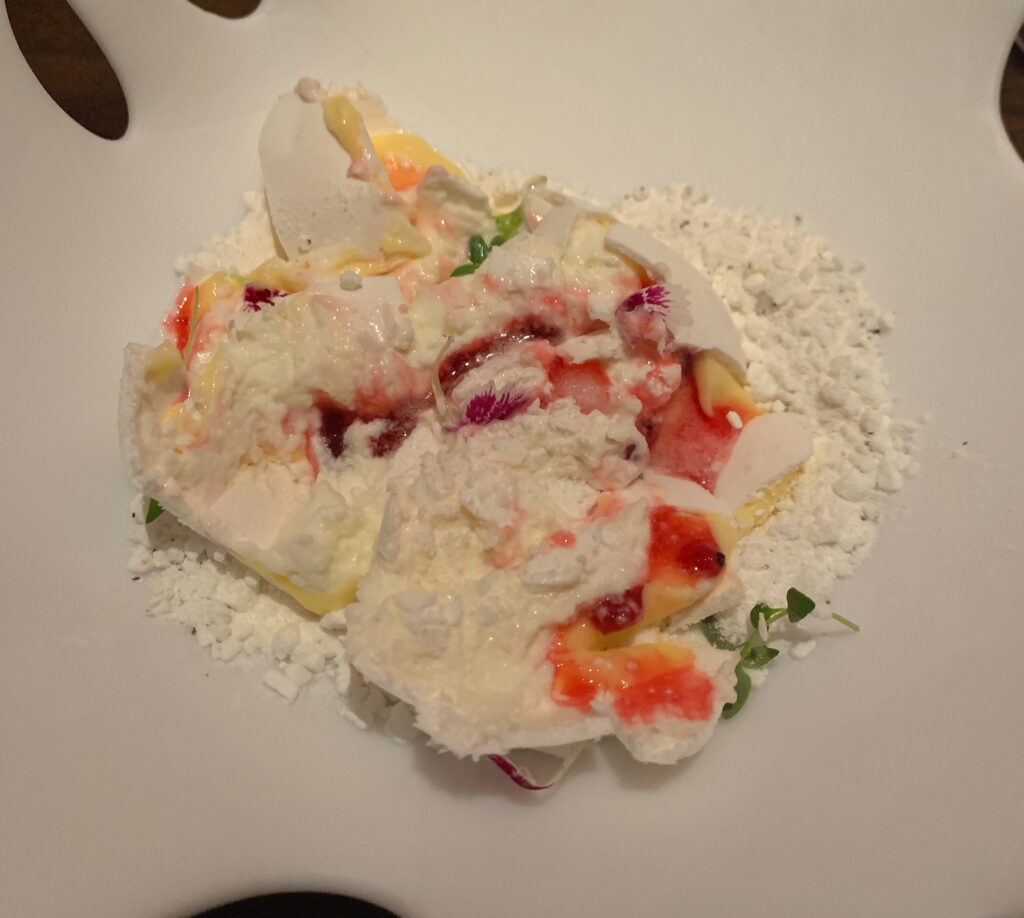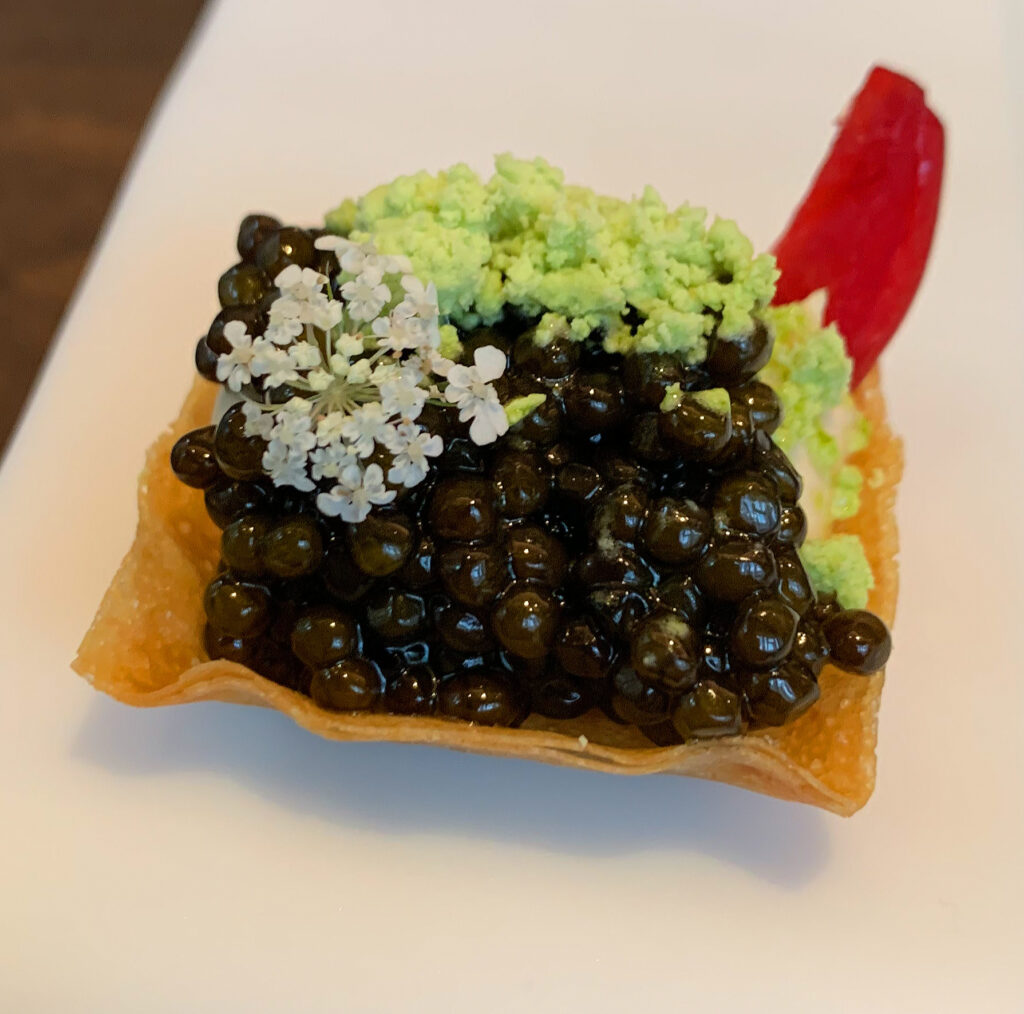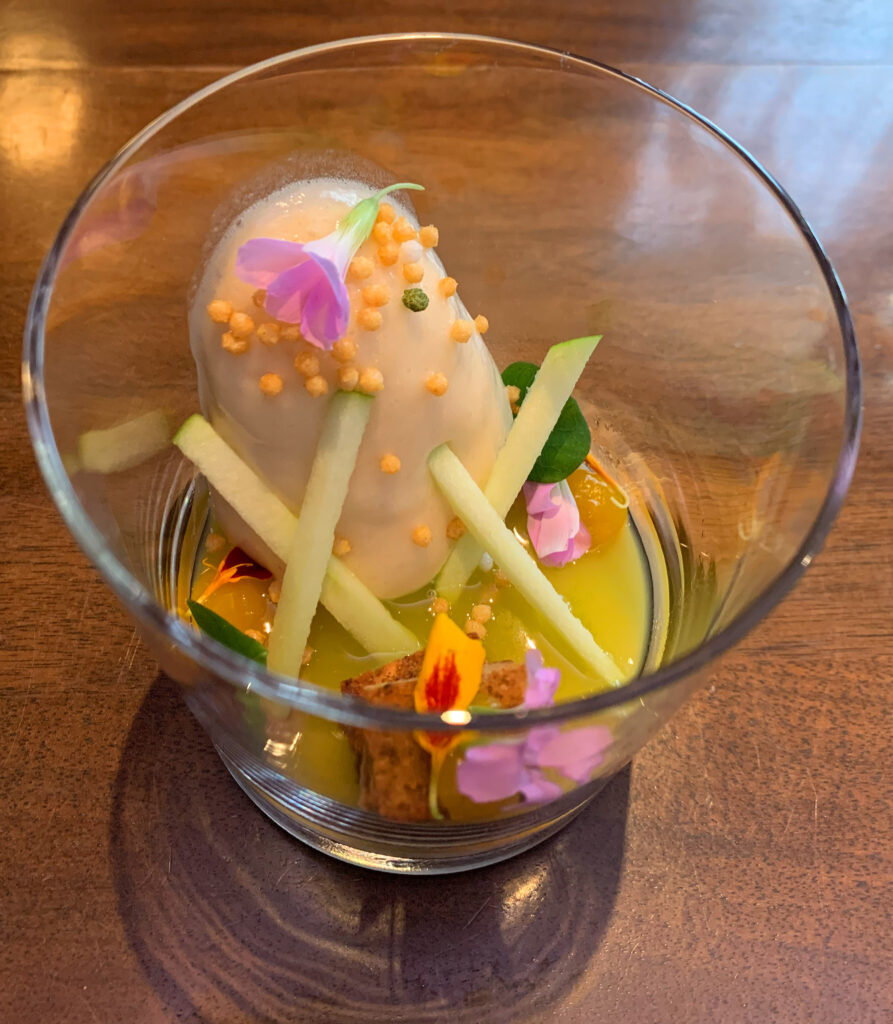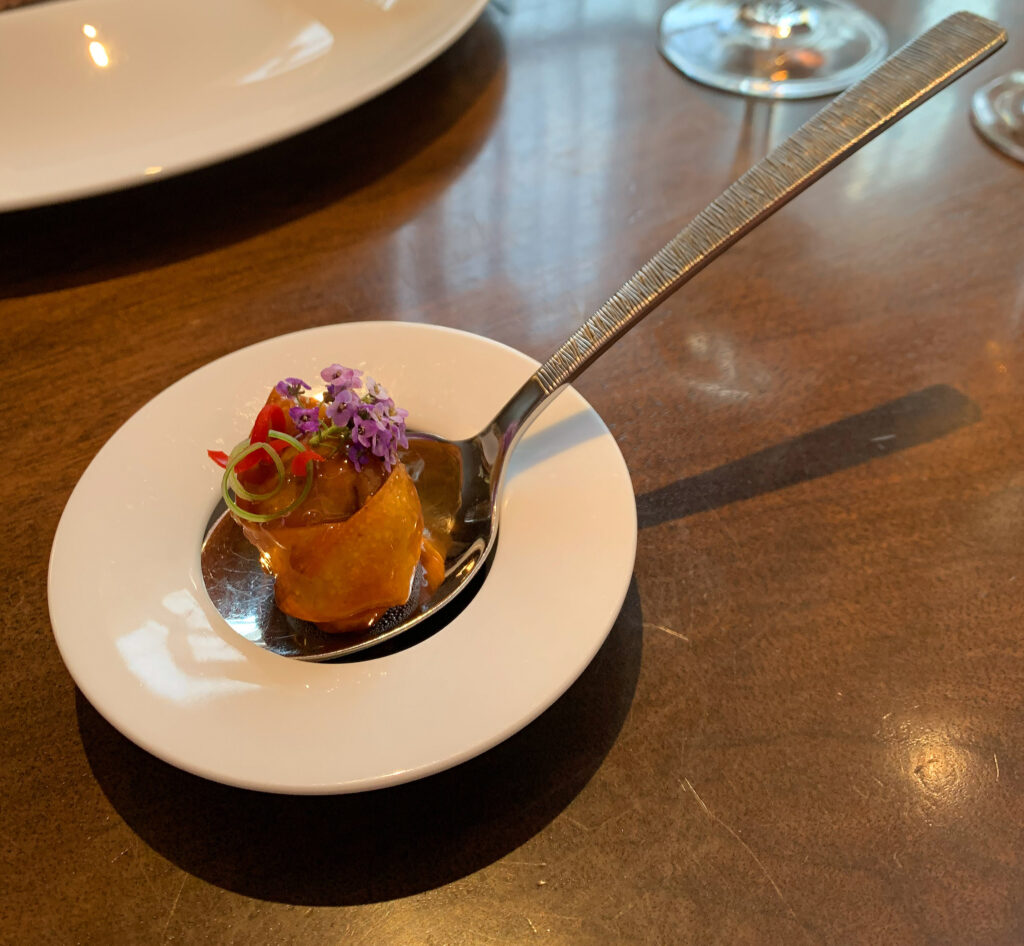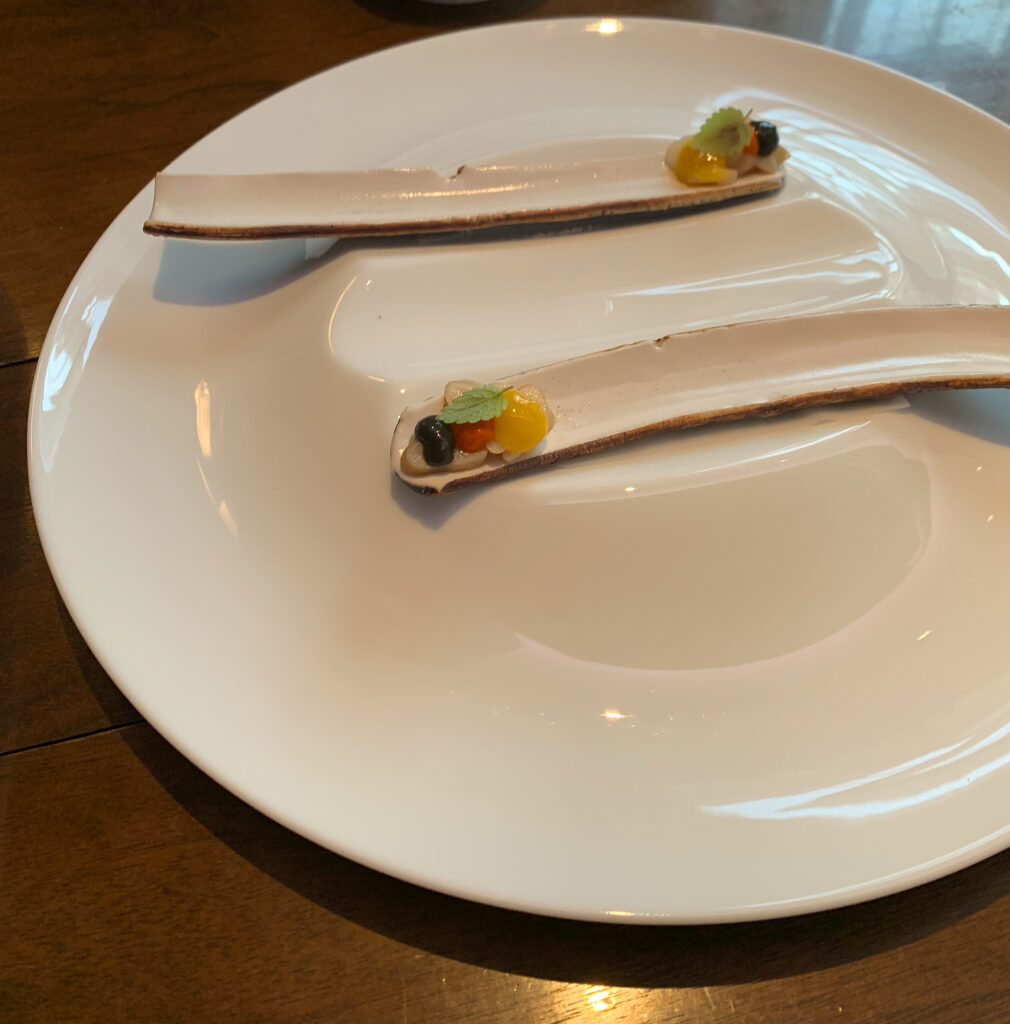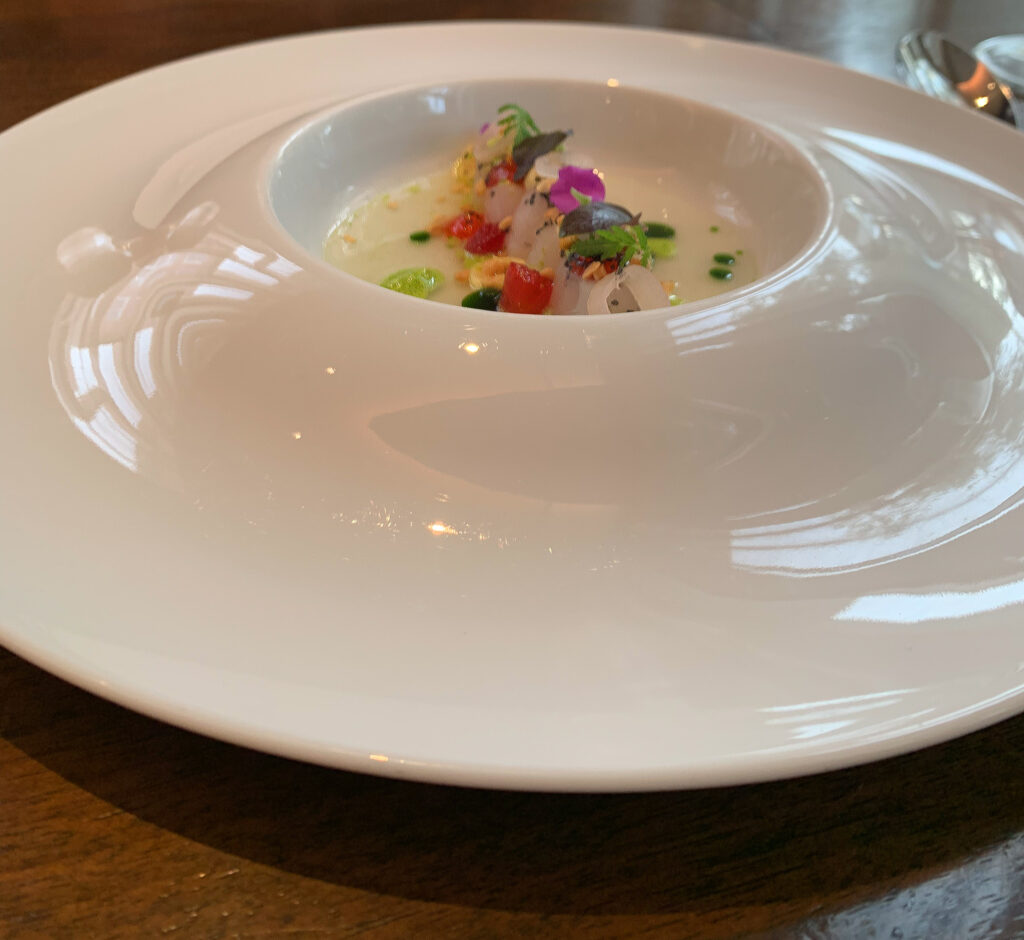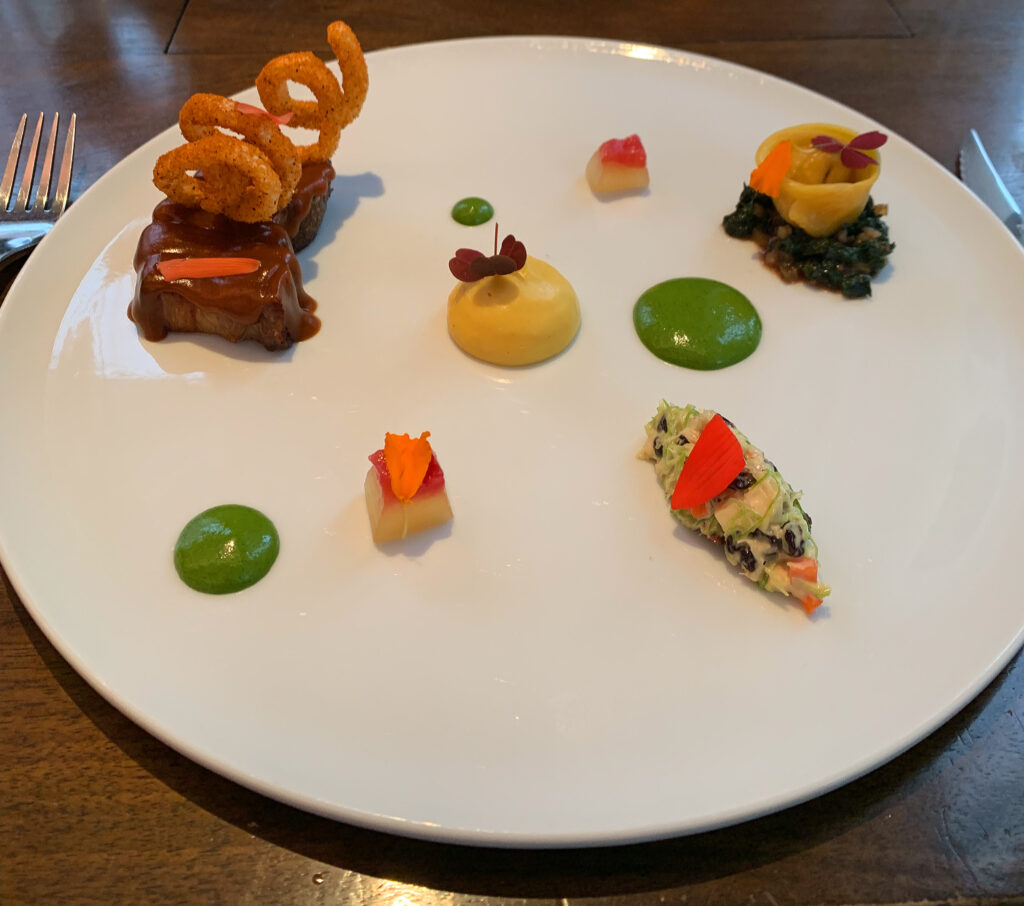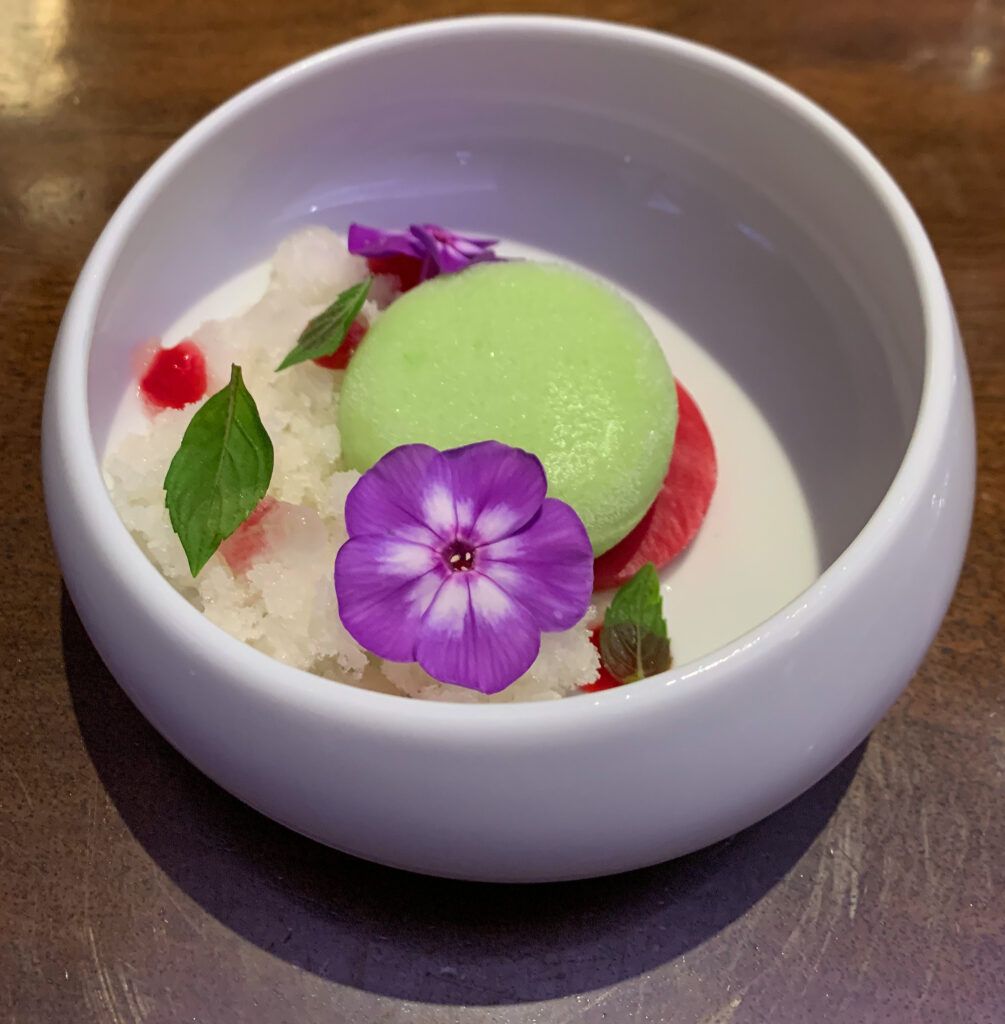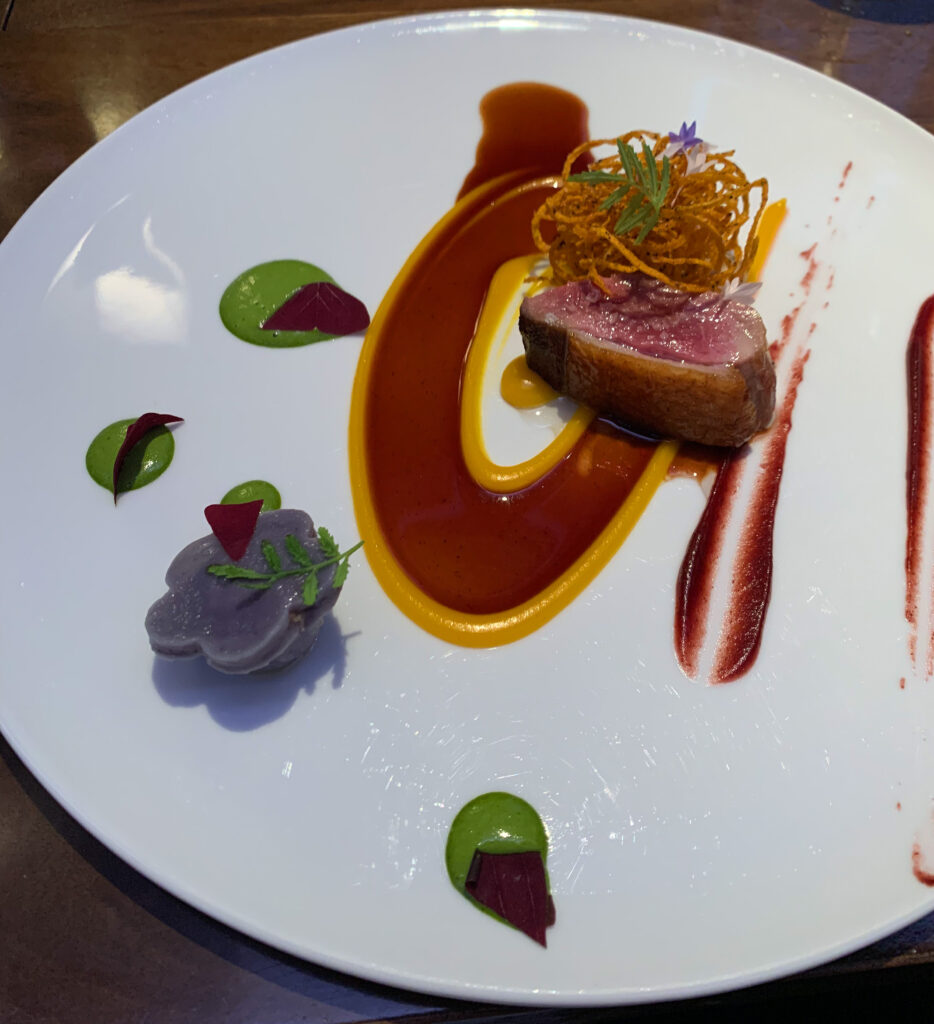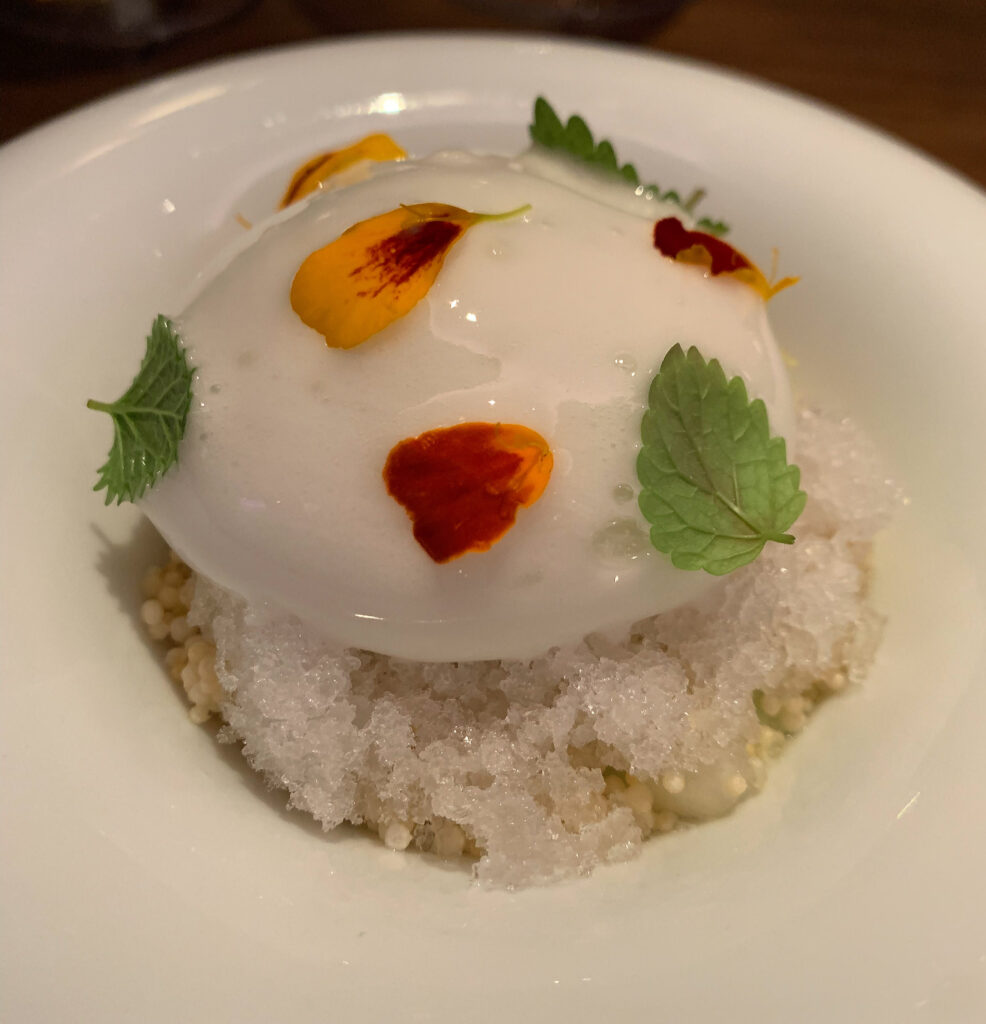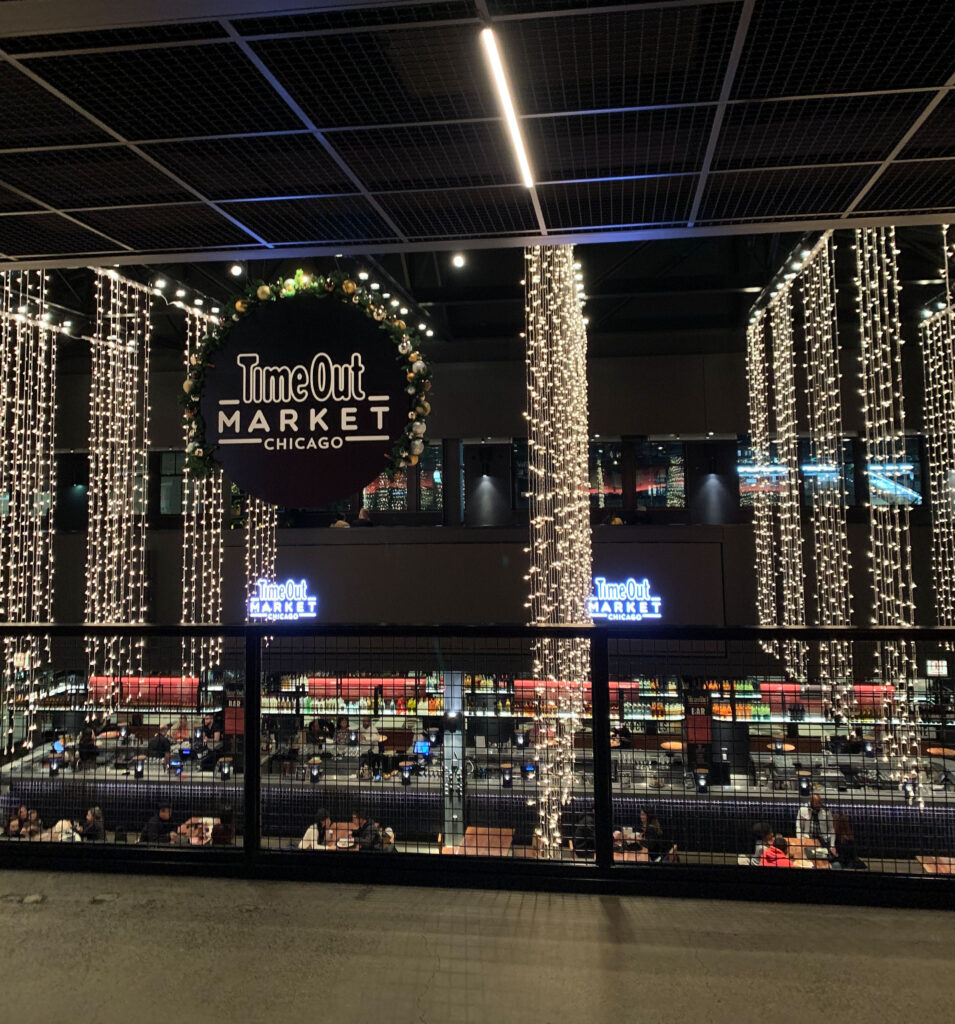After spending a bit of time exploring two of Chicago’s more longstanding fine dining concepts, you now shift your focus to a restaurant that has successfully reached middle age. That, at least, is how you might conceive of a place that will soon be approaching its seventh birthday, under the command of its third executive chef, after weathering a pandemic and never deviating from the tasting menu form.
Yes, while Boka and North Pond made their names (at least in part) slinging à la carte fare for their communities, Temporis has always been a gastronomic outpost. The restaurant, then and now, sits quietly off of one of West Town’s main conduits in what is technically Noble Square. Its neighboring Pappanino’s, with those extra-large stadium pies, is now gone, but cult confectioner SUGOi Sweets has made a home for itself just one door down. Otherwise, the block is defined by a high school, a dentist, some salons, and a vintage musical instrument store.
No doubt, it’s a busy street (medians and all)—albeit as more of a thoroughfare. From a dining perspective, Temporis stands totally removed from the sprawl of taquerías, bars, and Thai spots that line Chicago Avenue. Just the same, you won’t see customers lined up around the block as they do at Kasama, located just a few blocks away and similarly isolated along its stretch of Augusta Boulevard.

Of course, not many tasting menus can count on that kind of daytime operation to act as a solid foundation while perpetually provoking interest from passersby. They, like Temporis, must hide in plain sight: a Bibendum-recommended destination that nobody would notice unless they had checked the Guide (followed by the recent Yelp reviews) and decided to take the plunge. The restaurant, flying that impenetrable “progressive American cuisine” banner, does not benefit from being pigeonholed as the Michelin-starred exemplar of this or that ethnic cuisine. Nor does itidentify itself explicitly—like Esmé or Ever or Schwa—with that much-derided (but thematically illustrative) “molecular gastronomy” moniker.
Temporis does not boast the kind of palatial (or natural) setting one might wish to show off on a special occasion. And, while the plates are pretty and both chef and restaurant are active on social media, the concept cannot claim much viral traction. You do not mean to imply that is a bad thing, for no kitchen—at this level—should cook in accordance with what conspicuous consumptive “foodies” and terminal scrollers wish to see. But, with only 20 seats to speak of and bookings spread over five nights a week, any positive impressions (should a guest be inclined to share them) are necessarily diluted by the great mass of online food content.
“Middle age,” to you, means that the concept has been the “hot new opening,” pleased the local critics, earned Bibendum’s endorsement, and done everything to get over the initial hump of being judged a success. In changing chefs, the restaurant even earned a second positive review from the Tribune while retaining that Michelin star all the while. However, as new openings continue to churn and the dining scene is defined by emerging trends and outside forces, Temporis finds itself in a fight for relevancy.
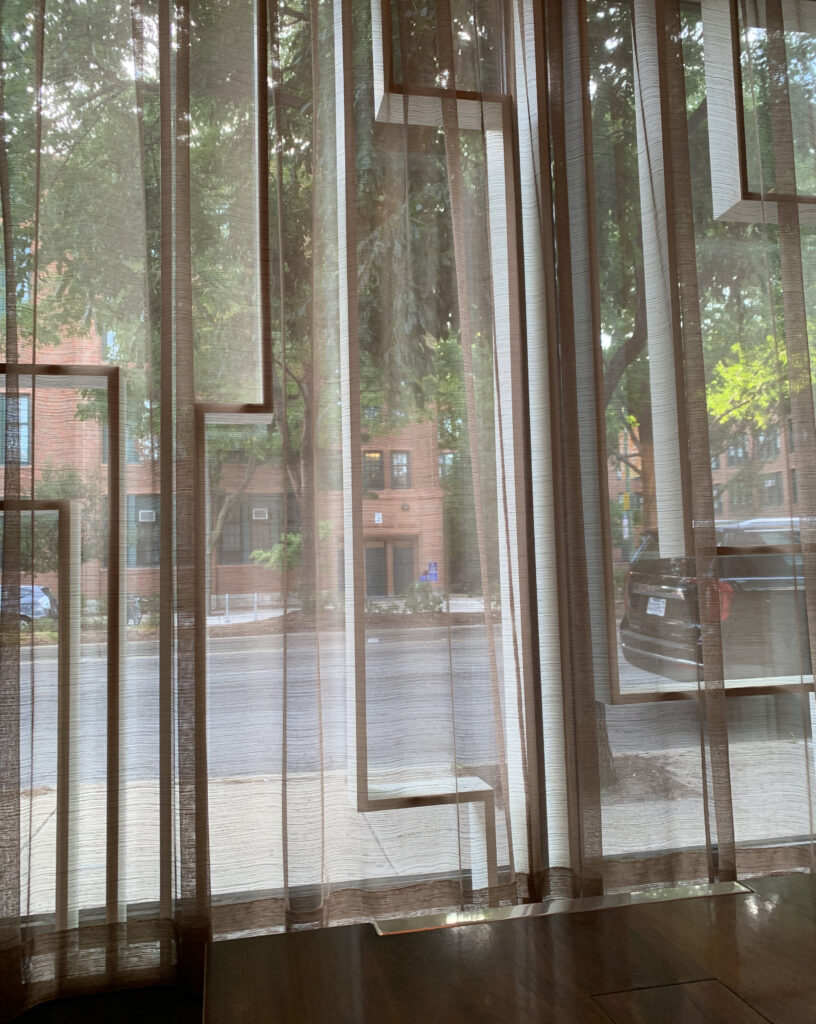
Where exactly does the place—that’s neither old nor new, that falls within an opaque genre, that may be cutting edge but has nobody to champion it for being so—fit? Once the local “critics” have had their say, they cannot very well afford to keep dining there even if the quality of food merits it. Duty calls them to talk about what’s new and colorful even (or especially) when it does not seem destined to last. So, somewhere like Temporis may occasionally pop up on an end-of-year “best of” list or be branded as some self-important contributor’s hidden fine dining gem. But it tends to escape attention, or even knowledge of its very existence, beyond those innocently scanning the Michelin Guide in search of a good time.
The restaurant sees the exact nature of its growth, over a period of months and years and countless dishes, obscured. Never mind that it has already established itself as one of the city’s finest establishments. Lacking the right audience, who communicates their experiences in the most far-reaching way, Temporis gets lumped in with every other tasting menu in town. It becomes wholly defined by its star rating and entered into a series of comparisons—driven by value, aesthetics, branding, and biases of all stripes—that deny all that makes the concept unique. For the most intricate, flavorful cuisine often has no means of announcing itself as such while the loudest voices in the room, more often than not, rely on panache to make up for creative bankruptcy.
In truth, you may be getting ahead of yourself a bit. Experienced diners come to learn that, once a restaurant earns its Michelin star(s), Bibendum is generally inclined to let them hold onto the rating. Enterprising establishments may endeavor to nab that second or third coveted symbol, renovating and investing in lowering their staff-to-guest ratio to do so, but concepts that have carved out a niche need only really maintain it. Thus, the tasting menu spot with wine pairings and suited, deferential service will continue to look and feel the part so long as standards do not drop precipitously. Cuisine matters, but it need not grow or improve beyond what first earned the star(s). The food can even regress a bit—with any claim it has done so shrouded by the essential subjectivity of taste—so long as the kitchen is not putting out demonstrably flawed plates.
In changing chefs, Temporis has already granted Bibendum a golden opportunity to sanctify or condemn any major changes to the style of the tasting menu. The restaurant has seemingly passed the test, but how much of this still might be inertia? Does substituting one chef’s vision of a $150-$200 meal, with all the same totemic luxury bells and whistles, for another’s amount to that much of a change when the overall “experience” has been preserved? First-time customers who are new to fine dining will find themselves charmed by the novelty and trappings of luxury all the same. Only patrons who are equipped to compare the restaurant’s value proposition to its competitors, who may even have eaten at Temporis in its previous era, can get at the truth: is this a “Michelin-starred restaurant” in its prime or one that merely continues to wear that skin?
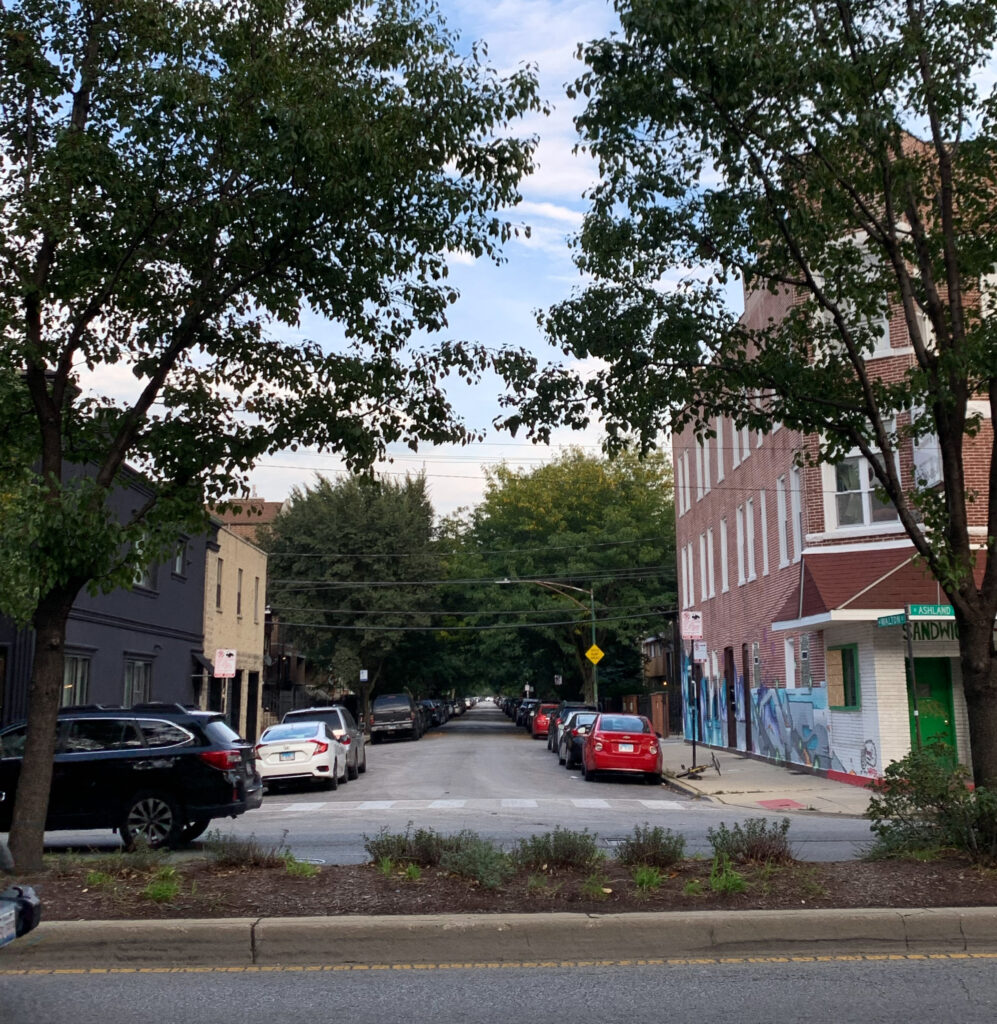
With every major closure (particularly ones like Blackbird, Brass Heart, and CLAUDIA), Chicago reveals just how much it struggles to sustain the “contemporary American” genre. This seems to hold true whether a restaurant is a member of the old guard, primely positioned in a fashionable neighborhood, or a young runt, bringing some higher expression of gastronomy to a more isolated community. Temporis, in its middle age, occupies a key liminal place between these poles that is ripe for analysis. Such a review will not only cast light on where the restaurant, nearly seven years on, stands. It may help to reveal how a “progressive American” concept successfully expresses an identity that is not obvious or even salient from afar. At the very least, it will aid in a greater understanding of how chefs can sustain themselves within this permissive but amorphous genre without needing to utilize smoke and mirrors or moonlight as a social media provocateur.
Nonetheless, before putting Temporis through it paces and grappling with these more overarching questions, it may be instructive to take a look at how the restaurant has gotten where it is today.
The story starts back in 2015, when chef-partner Sam Plotnick hosted a series of “pop-up dinners in his apartment” with “another chef friend.” Plotnick had cultivated a love of cooking while studying economics at SUNY (via “a single electric crock-pot in his college dorm room” and a “hydroponic herb garden growing in his closet”) and, following graduation, began a summer internship at Les Nomades. There, he would help open Goosefoot with Chris Nugent before rising to the rank of chef de tournant in Roland Liccioni’s kitchen. In that role, Plotnick worked under sous chef Evan Fullerton (who cut his teeth at Roland Passot’s La Folie in San Francisco) while at Les Nomades before the latter moved on to become the executive chef of 1913 Restaurant + Bar in Roselle.
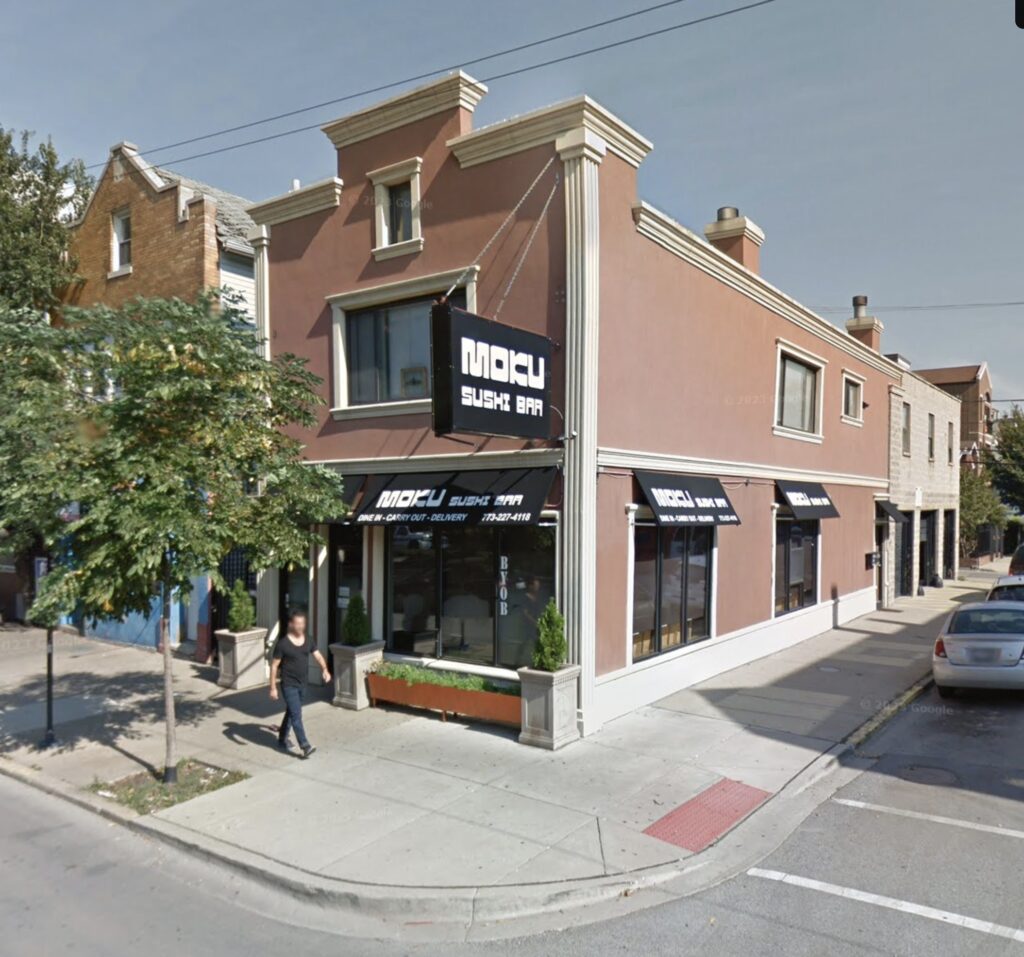
The pair stayed in touch as Plotnick began hosting those pop-ups and wondering wonder how he could recreate the “personal feel of going into someone’s own dining room” he so enjoyed in a restaurant setting. The chef-partner mulled over “the simplest business model and operation” he could use to capture that feeling and cook the same sort of food, settling on the idea of opening a 20-seat—rather than an “80-seat”—concept. Soon after, Plotnick found the former Moku Sushi Bar space (at 933 N Ashland) and called up his former boss Fullerton to come aboard as co-chef.
The two men had been “writing down ideas” for their “own food” over the years, and Plotnick hoped to foster an open creative dialogue at the forthcoming restaurant he likened to “the feel of a writer’s room,” where “you can say whatever you want and you don’t leave the room until you’ve created something exciting.” The chef-partner, despite initially forming the vision for the project, characterized himself as “not nearly experienced enough to want to be yelling at everyone else” in the kitchen. Fullerton, in turn, had “a lot of great experience,” and his ideas would be embraced so that they “could make the best food that…[they] could make.”
Stylistically, the cuisine was “not going to be French” like Les Nomades but “contemporary American,” using “local ingredients” and “any techniques” the chefs wanted. Plotnick would characterize his and Fullerton’s approach as liking “to focus on balancing flavors and textures” while “exploring” their “favorite ingredients in-season.” He would also classify that “contemporary American” label as being “about breaking from the traditional pairings of ingredients and being extremely local.” The two chefs, likewise, “have a bunch of heritages” and wanted “to let go of a single heritage and blend them all with an open mind.”
Elsewhere, Plotnick would describe the restaurant’s “model” as a “hyperlocal menu” focused to “the beginning, middle and end of a season” in order to create “a full ten-course tasting.” The chefs would not “change all the courses over at the beginning of a season” (because it would represent “a huge undertaking for the kitchen”) but, rather, “as things slowly come into season, and things slowly go out,” they would replace individual dishes. To that point, the restaurant would be “buying from Local Foods and from the farmers markets” without “an overly strong thing” where they’d “have to support local farmers over, say, California farmers.”

Instead, Plotnick would contend that “there’s nothing more local than growing all of your herbs and much of your greens in your own restaurant” and reveal the concept would make use of “a hydroponic garden in the basement.” Through this, the chefs could “somewhat challenge the idea of what a seasonal restaurant is” by cultivating ingredients “twenty feet from the diner” and combining them “with things in season that would never go together.” Plotnick gave the example of pairing “a perfect summer strawberry with a perfect winter parsnip” and decried those who might resist this bending of nature’s rhythms as wanting “to stick with the traditions and the social norms.”
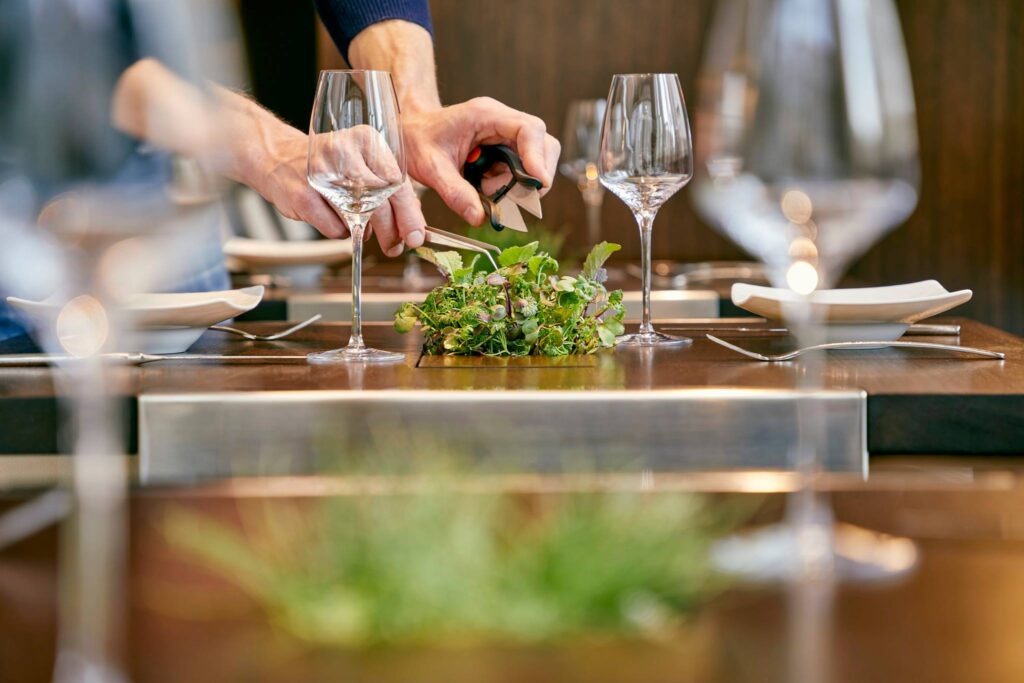
This sensibility—of hydroponic gardening and the manipulation of conventional “seasonality”—would find its expression in the restaurant’s chosen name: Temporis, which means “time” or, in the chefs’ own words, “the passage of time.” It would also come to define the concept’s design too. Plotnick would admit “there’s not much nature around” the restaurant. However, the dining room’s lighting would be “all LED, completely color controlled and temperature controlled” individually “for each table.” This would allow for “more subtle changes, more gradual changes” to the mood of the space during the course of the meal (that might end, for example, “with a warm amber color”). The tables would also feature wooden panels at their center that could be lifted out “to reveal a small well,” which would allow the chefs to showcase “the herbs that are used in a dish” growing right before guests’ eyes. Alternatively, the indentation might be used to house “a little zen garden with hot rocks” used to sear “pieces of meat or raw fish.”
Plotnick and Fullerton, speaking during the summer of 2016, aimed to open Temporis that same fall. In the meantime, the chefs hosted a series of pop-up previews at Local Foods throughout August. These meals, along with all the media coverage, offered them the chance to give some sense of what might be on the opening menu.
Dishes included “mini cones made from fennel tuile…stuff[ed] with king crab, parsnip-smoked trout roe and fennel;” “fermented sunchoke puree with salsify, dandelion greens, frisée and a chamomile gelée;” “tandoori-spiced rabbit loin, a tiny roasted rack of rabbit, and braised rabbit leg with carrot purée, rattlesnake beans, and mustard greens;” and “foie gras ice cream with pork-poached cherries.”
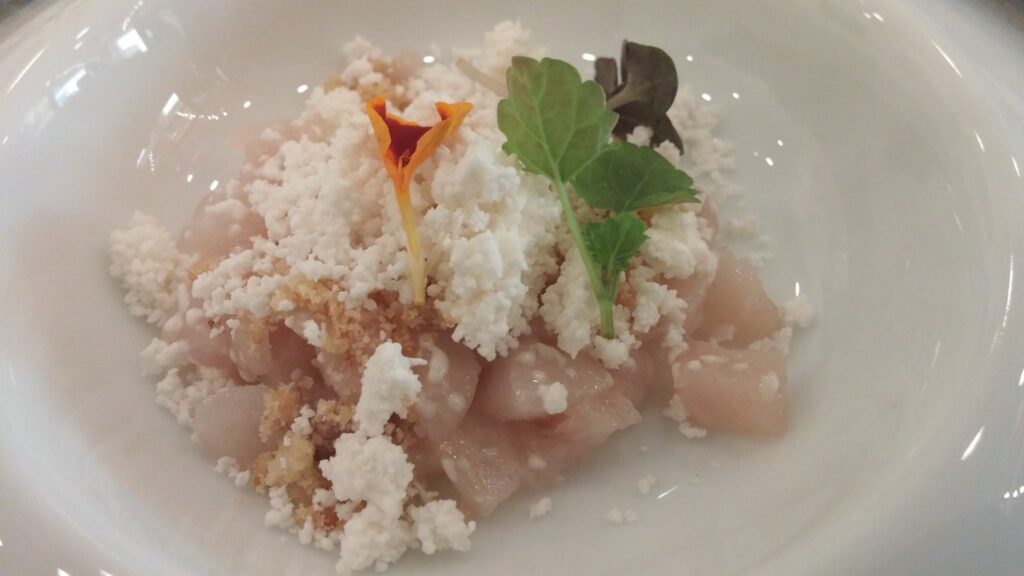
One dish in particular, a hamachi tartare, would be particularly instructive as to how the chefs think. In Fullerton’s words, it would combine the “traditionally French” tartare form with “yuzu juice” and “a little bit of the molecular gastronomy” without making the latter “the focus of the dish.” The preparation, which was also said to include “dehydrated hazelnut oil and an ‘almost puréed’ ginger sugar cookie,” ultimately combined “Asian ingredients” with “French technique and a little bit of New Age science.”
Plotnick, discussing the state of fine dining more broadly, would note that “it seems like every dish on a tasting menu has to have one thing you’ve never heard of.” In contrast, Temporis would look to offer food that is “a touch more precise, and familiar, and comforting” with the goal of ensuring each preparation has an element that is “going to make someone crave it” and “want to come back.” Whether that demands the chefs “think out of the box” or lean on “something classic,” they would do whatever they can to make each dish “delicious.”
Otherwise, Plotnick expected that he and Fullerton “can run the kitchen by ourselves with the help of just a part-time dishwasher.” Rent would not be “incredibly high in Noble Square” and they wouldn’t “have much food waste.” The chef-partner, nonetheless, hoped to “make some wine sales” via optional wine pairings and an à la carte list. To do so, he brought on Donald Coen (who worked on the wine team at Alinea before becoming a captain “within the wine program” at Les Nomades) as beverage director. Coen would retain his position at the latter restaurant while crafting a list filled with both “classics” and “esoteric varietals that don’t receive as much attention as they should.” He highlighted, in particular, “wines from the Savoie and Jura regions” as being among the “rare” selections that would set Temporis apart.
Despite having a team and a location in place, Temporis’s fall opening would—as so often happens—be delayed. The restaurant did not welcome diners in 2016 (a year that saw juggernauts like Elske, Oriole, and Smyth enter the fray) but began serving guests the first week of 2017.
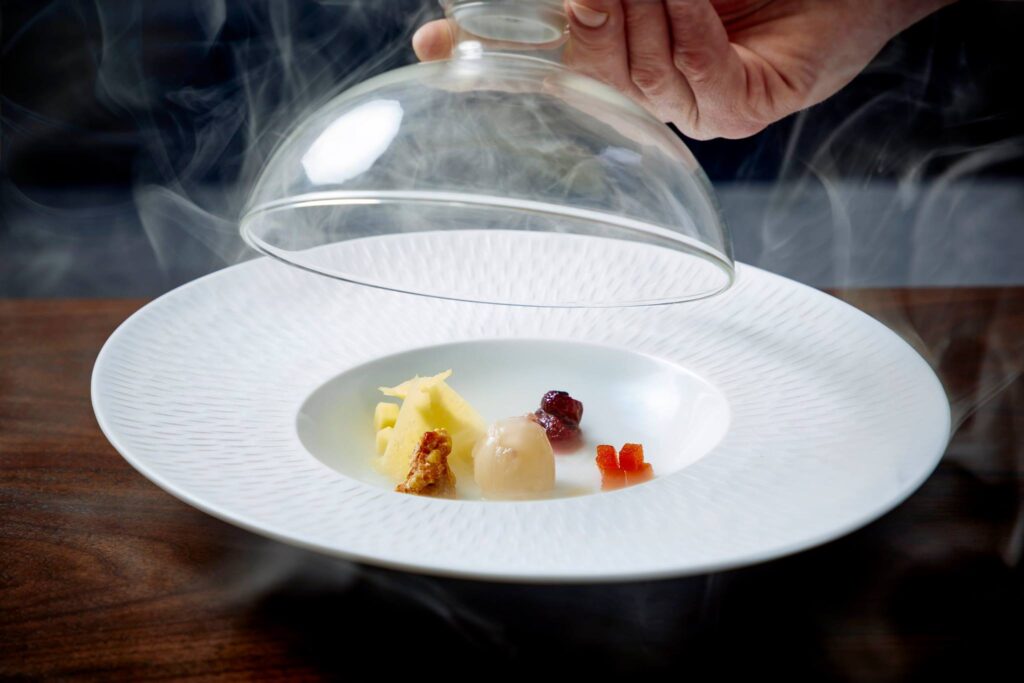
The opening menu ($110), accessible thanks to internet archiving, featured dishes like “King Crab” (with parsnip, salmon roe, and dill pollen), “Wild Mushroom Consommé” (with pickled cipollini and scallion), “Socca Chip” (with rabbit rillette and pear), “Venison Shank” (with coffee stout, granola, and pomegranate), and “Aged Cheddar” (with an ibérico gougère and quince) alongside aforementioned ideas like the “Hamachi,” “Sunflower in Five Forms,” and “Rabbit” (three ways). Wine pairings (five pours spread across the 11 courses for $95) included producers like René Geoffroy, Château de Puligny-Montrachet, Jean-Louis Chave, and Domaine des Baumard.
Time Out would be the first to offer a review of Temporis in March of 2017, describing it as “a textbook fine dining choice for romantic dinners” with “some culinary curveballs in store.” The restaurant, earning three out of five stars, would be criticized for “inconsistent” portion sizing “from plate to plate” but earn praise for the “hidden cubbyhole” of microgreens used to garnish a cast iron skillet filled with “meaty hunks of [rabbit] loin, a tender leg and a flavorful little rack of ribs.” Ultimately, the concept was judged “a surprising and intriguing option in an intimate setting—perfect for a fancy and fascinating night out.”
The Chicago Reader would chime in at the end of March, describing the restaurant as “nothing if not restrained” with a “museumlike quality” to both the food and ambiance. The “King Crab” and “Sunflower in Five Forms” drew praise while the “Hamachi’s” ginger sugar cookie element seemed like an “odd addition” that “didn’t leave” the critic “wanting more.” The “umami bomb” serving of “Wild Mushroom Consommé” was also noteworthy, and both the “Rabbit” (despite “a somewhat dry boneless leg”) and “Venison Shank” were termed “well prepared.” The “last three [dessert] courses were, as a whole, the best of the evening.” However, despite finding that “almost all the food had been memorably excellent” and “the service was impeccable,” the author left “still hungry.”
All in all, this does not seem like a bad start for a restaurant—just two to three months old—from a couple of young chefs. Yelp reviews from the same period are generally positive too, with the lowest ratings (three out of five stars) again citing small portion sizes as their main issue.
Despite (or is it because of?) that, Temporis would undergo a major change in May of 2017. Fullerton departed from his position as co-chef and returned to 1913 Restaurant + Bar as executive chef. Don Young would be his replacement, admitting that “it kind of came push to shove, the last chef wasn’t working out, and it made sense for me to jump on board.” Young himself was a graduate of Kendall College who interned at Simon Scott’s Michelin-starred Bistrot Saveurs in Southern France before rising to the role of chef de cuisine at Les Nomades. He was also, as luck would have it, that “other chef friend” Plotnick had been doing his pop-ups with in 2015.
Young, who was “couch-surfing” at Plotnick’s apartment during that time, thus formed a key part of Temporis’s genesis. Joining the restaurant only a handful of months into its opening (though, before then, he would “stop by…when possible to help in any way he could”), the former would eventually become the concept’s lone executive chef as the latter transitioned to a front-of-house role. However, more immediately, Young and Plotnick would bring a fresh perspective to the cuisine. By all accounts, the partnership was successful.
In June of 2017, the Chicago Tribune would award Temporis three stars (“excellent”) out of four and praise the “considerable rewards” that lie in wait for those who visit the “tiny fine-dining room in Noble Square.” The price of the menu, by then, had risen from $110 to $125. But the article praised dishes like a “sweet sashimi scallop” with “nettle puree, sea beans and a coriander tuile” and a “robata-grilled octopus tentacle” with “miso-glazed eggplant, marinated shiitakes and strawberry,” That being said, the “heavier dishes” are said to be the “most impressive.” This included both the “Rabbit” from before and a new “painterly presentation” of lamb loin with “red-wine lamb sauce and herbes de provence pudding.” Desserts (including a new “deconstructed peach pie”) were termed “nifty”—and service “smooth and unobtrusive”—in a glowing review that hoped “more people will come to appreciate this restaurant.”
Despite the praise, Temporis would not catch Bibendum’s eye when Michelin released its 2018 Guide in the fall(a year that saw Smyth earn its second star and Elske and Entente clinch their first). Nevertheless, Plotnick and Young would be nominated for “Rising Chef of the Year” at the 2018 Jean Banchet Awards (alongside Diana Dávila and Brian Fisher), eventually losing to Nick Dostal.
Still, all things considered, the restaurant had handled its launch and a difficult chef transition with aplomb (even if its 20 seats were only “about a third full” when the Tribune made its two visits). The end of 2017 and dawn of a new year would offer Plotnick and Young the chance to articulate an even fuller vision as Temporis passed its first birthday.
2018 would see the concept introduce a $165 reserve pairing but maintain its $125 menu price. Representative dishes from this year include:
- “Escargot” (with brioche, kombu, and dill)
- “Donut” (with Mangalica ham, kombu, and dill)
- “Salmon” (with uni, cordyceps, and turnip)
- “Langoustine” (with anchovy, avocado, and radish)
- “Turbot” (with uni, eggplant, and vermouth)
- “Capellini” (with beech mushrooms and gooseberries)
- “White Asparagus” (with morels, Mangalica ham, and sheep’s milk)
- “Blue Corn Grits” (with Mangalica ham, hoja santa, and coca nibs)
- “Scallop” (with soy, XO sauce, and pineapple)
- “Portobello” (with rye, sunchoke, and fines herbes)
- “Squab” (with chanterelle, Swiss chard, and corn)
- “Rabbit” (with corn, potato, and sauce chasseur)
- “Iberico” (with guajillo, peach, and various greens)
- “Comté” (with tomato, balsamic, and Thai basil)
- “Wagyu” (with celery root, apple, and red wine)
- “Elysian Fields Lamb” (with ramp, squash, and curry)
- “Sofia Goat Cheese” (with strawberry, beet, balsamic)
- “Blueberry” (with maple, pancake, and tangerine lace)
- “Meyer Lemon” (with poppy, gin, and buckwheat)
- “Foie” (in the style of “PB&J”)
- “Foie Gras” (with cherry, black sesame, and madeleine)
- “Peach” (with Marcona almond, granola, and flowers)
- “Chocolate” (with passion fruit, coconut, and lemon basil)
Served with wines from producers like Paolo Bea, Bond, Calon-Ségur, Bruno Clair, Bruno Colin, Ulysse Collin, La Conseillante, Dagueneau, Dönnhoff, Eisele Vineyard, Bruno Giacosa, Kongsgaard, Krug, Labet (Jura), Littorai, R. López de Heredia, Benjamin Leroux, Lynch-Bages, Massolino, Mongeard-Mugneret, Bernard Moreau, Pol Roger, Joh. Jos. Prüm, Giuseppe Quintarelli, Jean-Michel Stéphan, and Taittinger.
For this work, Young—who cemented his position as lone executive chef during the course of the year—would, in the fall of 2018, catch Bibendum’s attention. Awarding Temporis a star in the tire company’s 2019 Guide, Michelin’s chief inspector would praise the experience as “consistently impressive” with a “really distinct personality” and “a mastery of technique.” He would even classify it “as a restaurant that was setting a global standard.”
In truth, Plotnick and Young had been “anticipating” the award (because “Michelin sent the restaurant an email to confirm the correct phone number”) even though the latter admitted Temporis was “barely making it by” before then. The restaurant would close “most Tuesdays” due to a lack of reservations and, on other weekdays, “would be lucky to serve eight to 12 dinners” (though, admittedly, it benefitted from “a supportive investor”).
Earning the honor, nonetheless, led to “a huge influx in business” in the months that immediately followed (from “a total of zero reservations booked for the next day” to “362 reservations in 12 hours”), allowing the team to begin hiring “more staff and more experienced staff in the kitchen” while “overhauling the menu” and “shooting” for a second star.
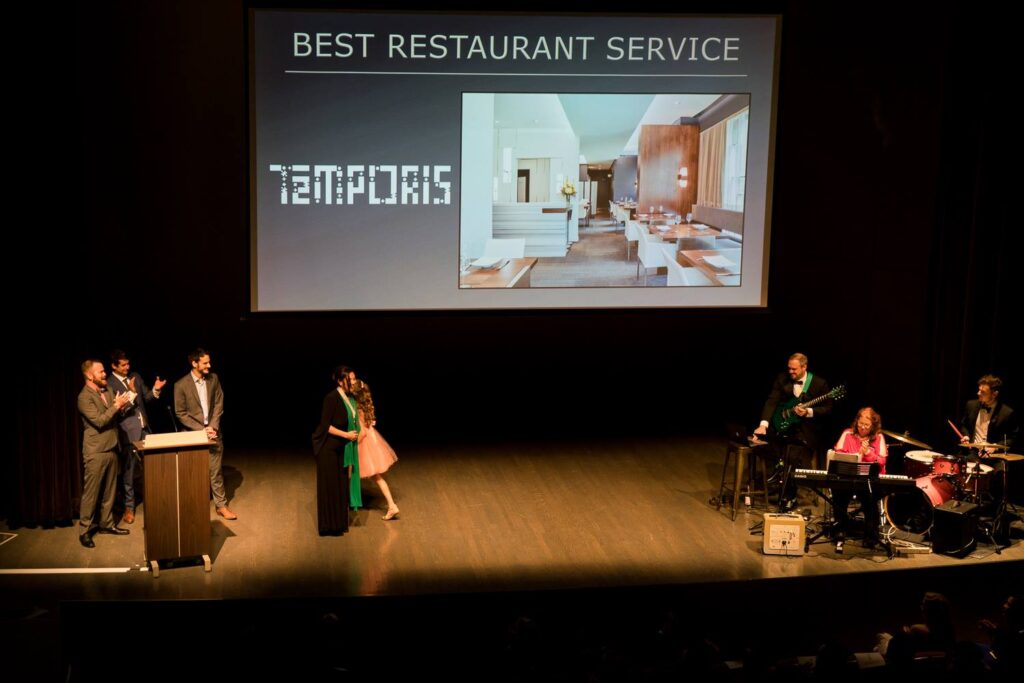
As an added bonus, Temporis would be nominated that same fall for “Best Service” at the 2019 Jean Banchet Awards and, on this occasion, beat out Daisies, NoMI, and Shanghai Terrace to take home the prize just after its second birthday in January.
Entering the new year, Plotnick and Young could count on some exciting developments. Don Coen, who had been “overseeing the beverage program while still full-time at Les Nomades,” came aboard as the full-time “beverage director and sommelier.” In addition to “building out a larger kitchen,” the team would also “double the size of the hydroponic garden, allowing for more experimentation with microgreens and other produce they’re growing.” This would allow each diner to be given “a tiny ‘living salad’ of microgreens, served straight from soil to table” with the dream of eventually cultivating “individual strawberry plants, complete with fresh strawberries, in the middle of winter.”
Young would also, at the time, note his “deep interest in fermentation, preservation, [and] pushing the traditions of classical French cuisine.” This would be articulated through a new dish he teased to the press: a “seared scallop mille-feuille” layered with “cranberry, pickled pineapple, black walnuts and red kuri squash,” topped with “candied pumpkin seeds, crispy Brussels sprouts and crispy chicken skin” then finished with “a tableside pour of Young’s take on XO sauce” (“newly fermented soy sauce” enriched with “duck and scallops”). The restaurant would also, looking ahead, promise “more interactive elements incorporated into the experience” through the “custom-designed tables and serving vessels.”
In truth, many of the dishes (like the “Donut,” “Capellini,” “Portobello,” “Rabbit,” “Comté,” and “Meyer Lemon”) served at the end of 2018 would remain on Temporis’s menu through May of 2019. However, there were indeed a handful of new preparations like:
- “Salmon” (with uni, eggplant, and vermouth)
- “Scallop” (with carrot, raisin, and cumin)
- “A5 Miyazaki Wagyu” (with white asparagus, red wine, and nasturtium)
- “Foie Gras” (with rhubarb, maple, and lemon balm)
- “Birthday Cake” (“tropical,” with “blown out candle”)
Of course, it is worth mentioning that just because certain dish titles (and their constituent ingredients) did not change during this period does not mean they were not refined. The presentation and garnishing of these recipes, especially as it relates to the hydroponic garden, could easily have changed. Likewise, a growing kitchen may have allowed for greater intricacy in how certain central components (like the rabbit) were expressed.
That being said, a much bigger change was afoot. Citing “managerial and creative differences,” Young would leave Temporis in June of 2019. No other details on the split with Plotnick were offered, with the executive chef simply stating he “put a lot of heart into the restaurant” and wanted it “to prosper.” In response to the news that Troy Jorge would take over the kitchen, Young would also say “Temporis is in good hands now.” He went on to become the executive chef of WoodWind and, later, Venteux (where he prepared the best French toast you have ever tasted). Currently, Young conducts seven- and 15-course pop-up experiences under his brand Duck Sel.
Back at Temporis, Troy Jorge, stepping into the executive chef position, would represent a clear break from the Les Nomades lineage that had thus far characterized the concept. He, a “self-proclaimed former punk kid” was born and raised in New Bedford, Massachusetts and originally “wanted to be a fashion designer” but “got kicked out of…sewing class freshman year of high school.” Nevertheless, a home economics class during junior year helped him discover a passion for cooking, which led him to enroll in culinary school.
From there, Jorge went to Boston, working at The Ritz-Carlton and Ken Oringer’s Clio (now UNI) before joining Jamie Mammano’s Columbus Hospitality Group. There, he rose to become sous chef of Ostra, a “contemporary Mediterranean seafood restaurant,” and chef de cuisine of Mooo…., a “modern steakhouse.”
After five years in Boston, Jorge “felt he had gained enough knowledge and experience to understand where he truly wanted to be.” That meant chasing the “dream” of working with Curtis Duffy at Grace, where he held the position of chef de partie from May of 2016 until the restaurant’s closure. Jorge would describe his time there as “incredibly intense,” “the most amazing and efficient kitchen…[he] had ever worked in,” “the cleanest kitchen” he had “ever seen,” and “everything…[he] had hoped it would be and more.”
After Grace, he worked at two-Michelin-star Acadia for a short period as sous chef then, later, consulted “for a restaurant and art gallery in the West Loop” before taking the Temporis job. Jorge described his new home as “a special place” with “an incredible level of talent and passion” he was “excited to be part of.” Wyl Lima, a colleague from Grace and Acadia, would come aboard as sous chef while, stylistically, he would describe his approach to the tasting menu as “driven by colors, contrasts and layers of flavor.” Elsewhere, more specifically, Jorge would note “abstract art” as “a big source of inspiration” in making “ingredient driven,” “playful” cuisine that seeks to be “as delicious” and “as beautiful” as possible. Still, the executive chef would prize a “natural look” that does not seem “intentionally placed” or “forced” but, rather, seems more like ingredients such as “herbs or flowers…fell from the sky.”
Taking the reins in July, Jorge would immediately put his stamp on Temporis’s tasting menu by debuting an entirely new range of dishes:
- “Squash Blossom” (mushroom, foie gras, Sauternes)
- “Fluke” (strawberry, lime, tangerine lace)
- “Crab” (avocado, grapefruit, pumpernickel)
- “Artichoke” (barigoule, parsley, lemon)
- “Tomato” (cucumber, basil, cantaloupe)
- “Lobster” (vanilla pasta, truffle, tarragon)
- “Sunchoke” (parmesan, gooseberry, sunflower)
- “A5 Miyazaki Wagyu” (broccoli, orange, cashew)
- “Mojito” (Key lime, pineapple, boba)
- “Watermelon” (feta, mint, BLiS Elixer)
- “Pistachio” (white chocolate, cherry, lemon balm)
Only one component (“tangerine lace”) from one of the preparations (“Fluke”) seems to offer a clear connection to the kind of work Young was doing. However, certain elements—like that trusty A5 Miyazaki wagyu and a range of herbs from the hydroponic garden—speak to a more overarching “contemporary American” Temporis identity that has remained consistent.
By the end of September, Jorge had begun to introduce other new dishes with the help of Jacquelyn Paternico, a pastry chef (the restaurant’s first) who joined from Michelin-starred Band of Bohemia:
- “Dumpling” (wagyu, scallion, ginger)
- “Kampachi” (fennel, macadamia, blood orange)
- “Corn” (summer truffle, espelette, coriander)
- “Pork Belly” (tamarind, quince, red cabbage)
- “Tosaka” (cranberry, coconut, burnet)
- “Lemongrass” (masago arare, yuzu, shiso)
- “Chocolate” (apple, miso, caramel)
These preparations do not only reflect a greater emphasis on Asian and Southeast Asian ingredients and forms. More importantly, they demonstrate a degree of dynamism that was missing from the restaurant during the earlier half of 2019. (Remember, only five additions were made from the end of 2018 through May while Jorge and Paternico were able to make seven in the span of just a couple months.)
When Michelin announced its 2020 awards at the end of September, Temporis—despite the change in chef—retained its star. Bibendum would term the restaurant “the epitome of serenity, sophistication and subtlety” with a kitchen of “supreme talent and collaboration” displaying “passion, vision, and a…highly intellectualized approach to cooking.” The Guide would also highlight dishes like “escargot with a fermented sour cherry tomato,” “salmon in an uni broth,” “capellini with lobster morsels,” “a paper-thin biscuit with cured Mangalitsa pork,” “decadent foie gras ice cream,” and a “chocolate tart” solidified around a “passion fruit-filled globe.”
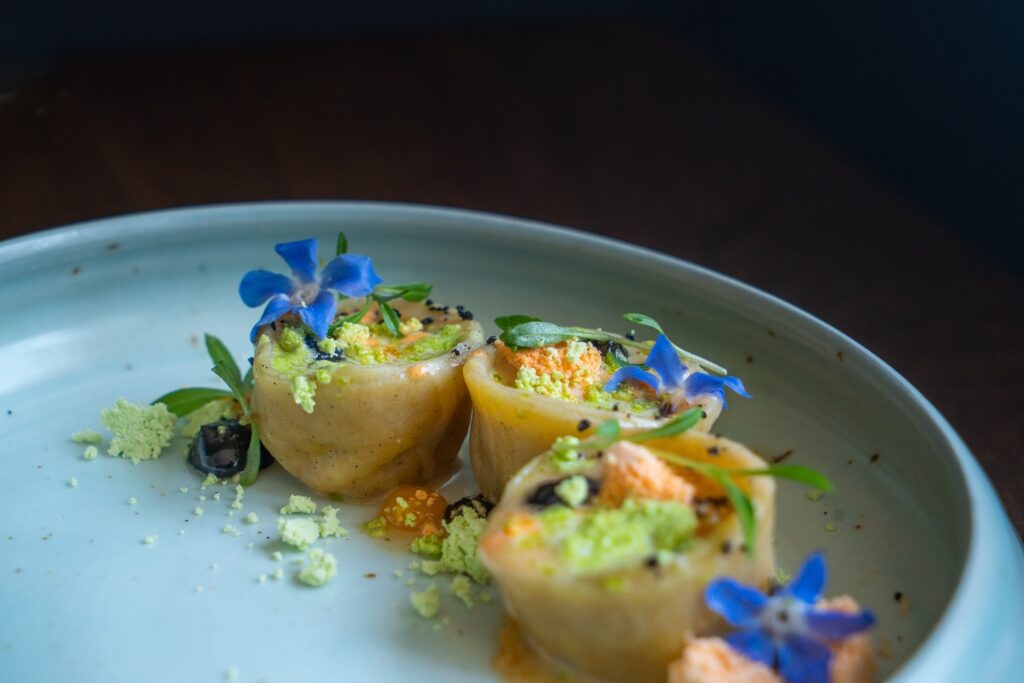
These all appear to be dishes that Young added to the menu, and it is worth questioning if Michelin actually bothered to visit Temporis after Jorge (and Paternico) took over before bestowing its star. Just the same, it may be that the honor intended to celebrate the work that was being done at the restaurant for the majority of 2019 (up until that point) while placing trust in the continuity that the same ownership, despite the change in chef, would provide. Whatever the reasoning, Bibendum would eventually update its listing in order to praise preparations like “dark butter-brushed corn, dotted with an espelette pepper-corn purée and finished tableside with summer truffle” and “vanilla pasta with lobster, tarragon, black truffle sauce, and Satsuma powder” that more clearly reflect Jorge’s actual work.
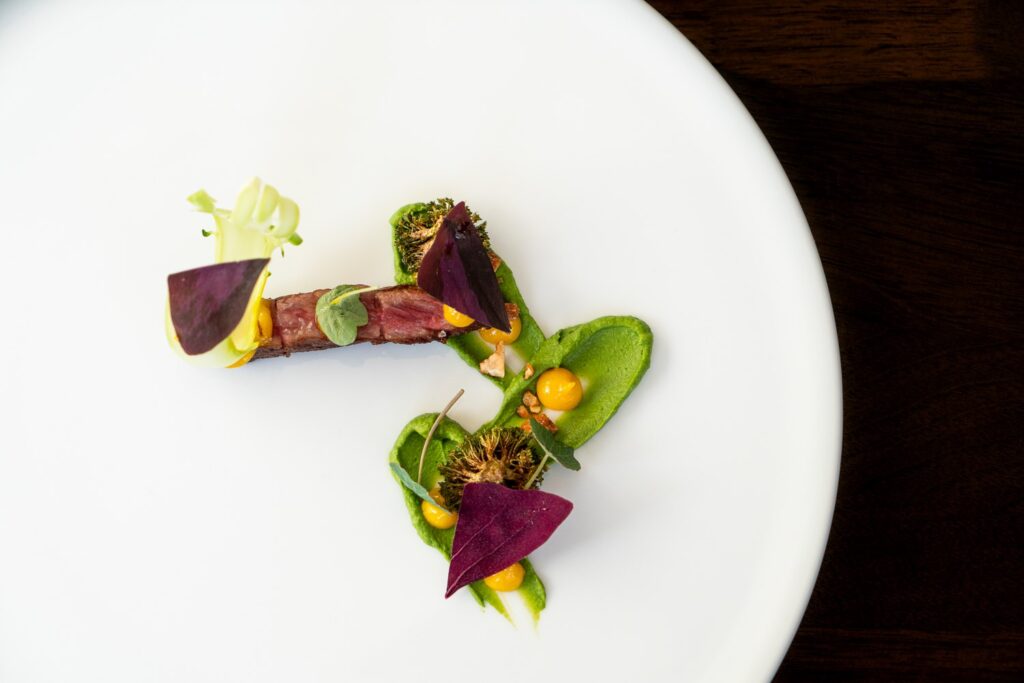
Nonetheless, Jorge and Paternico would indeed merit a closer investigation of their creative efforts when the Tribune rereviewed both Temporis and George Trois in October of 2019. Therein, the critic noted that the restaurant’s new executive chef was “not the fermentation devotee that Young was,” serving dishes that “have more restraint in their use of sour and acidic flavors.” However, Jorge was said to be “doing outstanding work” with highlights including the “extraordinarily balance[d]” “Tomato” and “Crab,” the “umami-focused” “Corn,” the “spectacular” “Lobster,” and the “playful” “A5 Miyazaki Wagyu” styled after beef and broccoli. Paternico’s work, in turn, was said to “match” her counterpart’s “in complexity and artistry.” Temporis would ultimately be rated three stars (“excellent”) as it had been in June of 2017—something of an affirmation that standards had not fallen despite the chef shuffle—but was said to be “awfully close” to that fourth star (“outstanding”).
Jorge and Paternico would craft an array of new dishes (many designed for a special black and white truffle dinner at the end of December) to see out the rest of the year:
- “Pot de Crème” (cherry, tarragon, black truffle)
- “Okinawa Sweet Potato” (bourbon, lime, anise hyssop)
- “Bay Scallop” (Meyer lemon, black sesame, passion fruit)
- “Anson Mills White Grits” (duck egg yolk jam, red wine purée, chicken skin, white truffle)
- “Yukon Gold Tortelloni” (lemon marmalade, parmesan velouté, parsley jam, black truffle)
- “Pheasant” (Humboldt Fog, soubise, watercress)
- “Short Rib Rossini” (celeriac dauphinois, Sauce Périgueux, white truffle)
- “Crépe Cake” (chocolate, sudachi, hazelnut, black truffle)
And Jorge’s “A5 Miyazaki Wagyu,” the aforementioned “whimsical, upscale take on a Chinese-menu staple,” would feature on the Tribune’s list of “The 24 Best Things We Ate and Drank in Chicago Restaurants in 2019.”
With all of this momentum, 2020 promised to be a banner year for Temporis under the command of its new chefs. The restaurant celebrated its third birthday but, not long after, had to contend with the COVID-19 pandemic. Michelin would feature the team’s efforts as part of a May 2020 article on three Chicago concepts, revealing that Temporis was “operating with nine people, including Jorge, which is a close approximation to the original staff size.” The chef “had to come up with a totally different menu that was still the highest quality and something that people are going to want to eat every night,” so the restaurant served items like Faroe Island salmon (with truffled lobster mac and cheese), braised short ribs (with cheddar grits), an A5 wagyu burger, an A5 wagyu footlong hot dog, waffle fries (with black truffle aioli), and brownies over two periods of closure.
Plotnick was able to keep his team together, and Jorge and Paternico could yet again flex their creative muscles as Temporis once more offered its tasting menu (now priced at $155) during the summer and through the early stages of fall:
- “Parsnip” (fennel, pink lemon, licorice)
- “Peas & Carrots” (custard, chips, cocoa nibs)
- “Octopus” (‘nduja, celery root, Vidalia)
- “Pistachio” (peach, gorgonzola, nutmeg)
- “A5 Wagyu Ribeye” (tamarind, jackfruit, Thai basil)
- “Lamb” (ratatouille, buddha’s hand, mint)
- “Veal Cheek” (chocolate, white pumpkin, yuzu)
- “Verjus” (buttermilk, strawberry)
- “Prickly Pear” (lime, shiso)
- “Apricot” (sunflower, lemon, olive oil)
- “Cherry Blossom” (cherry, tonka, white chocolate)
- “Chocolate” (golden beet, hibiscus)
While the dawn of 2021—and the passing of Temporis’s fourth birthday—would not yet offer a fresh start, the year would still be fruitful. In April, the restaurant once again retained its Michelin star in what must have represented a particular distinction for Jorge and Paternico, recognizing work imprinting their own style on the kitchen while stewarding the concept through such a difficult period.
2021 would also allow the chefs to further develop their cuisine through dishes like:
- “Canapés” (wagyu, hibiscus, osetra)
- “Wagyu” (soy, ginger, fresno)
- “Foie Gras” (strawberry, elderflower, mint)
- “Tomato” (cucumber, brioche, basil)
- “Holland White Asparagus” (rhubarb, brioche, oxalis)
- “Cauliflower” (truffle, curry, parsley)
- “Uni” (lobster, parmesan, lemon)
- “Red Mullet” (lobster, leek, lemon)
- “Duck” (cherry, green bamboo rice, tarragon)
- “Squab” (blueberry, polenta, fennel)
- “Venison” (fiddlehead, blackberry, cocoa)
- “A5 Wagyu Ribeye” (coffee, orange, bacon)
- “Yuzu” (ginger, black cardamom)
- “Huckleberry” (lemon verbena, goat’s milk, earl grey)
- “Chocolate” (tahini, red wine)
- “Mignardises” (black currant & lavender pâte de fruit, pineapple doenjang bonbon)
2022—and the passage of the restaurant’s fifth birthday—would tell a similar story: Temporis retained its Michelin star in April while being nominated for “Best Pastry Program” (alongside Adorn, Aya Pastry, George Trois/Aboyer, and Kasama) at the Jean Banchet Awards that following May. Paternico, whom the nomination really (given the small size of the concept) honored, lost out to Kasama—nothing to be ashamed of given the year they had. And Jorge, more specifically, also earned a nomination for “Rising Star Chef” (alongside James Martin, Zubair Mohajir, Ian Rusnak, and Eric Safin), ultimately losing to Ethan Lim. The price of the tasting menu, like so many others throughout Chicago, would continue to creep up in price (to $175). However, the year would offer the kitchen a chance to continue growing without the same fear of lockdowns and pandemic pivots.
Dishes from 2022 include:
- “Canapés” (wagyu, osetra, passion fruit)
- “Golden Kaluga” (parsnip, buddha’s hand, sumac)
- “Foie Gras” (blueberry, granola, pink lemon)
- “Beet” (pistachio, goat cheese, persimmon)
- “Holland White Asparagus” (rhubarb, brioche, egg yolk)
- “White Pumpkin” (maple, apple, pumpkin seed)
- “Octopus” (potato, fennel, lemon)
- “Peas & Carrots” (cocoa, custard, marigold)
- “Caviar” (banana, coconut, miso)
- “Lobster” (uni, parmesan, seacress)
- “Black Cod” (lime, coconut, lemongrass)
- “Turbot” (piquillo pepper, artichoke, parsley)
- “Black Cod” (piquillo pepper, artichoke, parsley)
- “Pork Belly” (lime, coconut, lemongrass)
- “Lamb” (black garlic, sumac, sour orange)
- “Squab” (strawberry, elderflower, sorrel)
- “Australian Wagyu Cheek” (apple, date, yuzu)
- “Westholme Wagyu Ribeye” (morel, hibiscus, sea buckthorn)
- “Pomegranate” (spruce tip, sudachi)
- “Omija” (kumquat, coconut, lime)
- “Kabosu” (guava, white chocolate, matcha)
- “Cantaloupe” (lime leaf, goat’s milk)
- “Nori” (cucumber, yuzu, white chocolate)
- “Truffle Opera Cake” (buckwheat, cassis, caramélia)
- “Basil” (Meyer lemon, dark chocolate, black mint)
- “Mignardises” (pear & fennel pollen pâte de fruit, cinnamon roll bonbon)
- “Mignardises” (calamansi gummy, mojito bonbon)
- “Mignardises” (strawberry & spruce tip pâte de fruit, chai bonbon)
When you consider this range of preparations, it is finally possible to see some of the ingredients and ideas that have defined Jorge and Paternico’s work over the past few years. For the former, you may note an enduring love of foie gras, white asparagus, octopus, lobster, pork belly, and wagyu. “Peas & Carrots” seems like a particularly canonical recipe (being brought back from 2020) while favored ingredient combinations like “lime, coconut, lemongrass” and “piquillo pepper, artichoke, parsley” have been utilized across different proteins. Herbs from the hydroponic garden still seem to appear but are no longer featured as prominently as fruit like apple, banana, blueberry, date, passion fruit, pink lemon, sour orange, strawberry, and yuzu throughout the savory fare. This also holds true for Paternico’s pastry work, which retains a marked Asian influence (“Omija,” “Kabosu,” “Nori”) while highlighting herbs, fruit, and various styles of chocolate. Of course, the pâte de fruit and bonbon forms are clear favorites too (with the mojito version of the latter calling back to Jorge’s very first menu).
Today, in 2023, Temporis has passed its sixth birthday and is rapidly approaching its seventh. Bibendum has reverted to releasing his stars in the fall, so you have not yet received the annual confirmation that the restaurant has maintained—or maybe even surpassed—its usual high standard. And Jorge’s tasting menu, it should be said, has now climbed to $215 per person.
Temporis is now quietly in that period of middle age you previously spoke of, pleasing the majority of its customers (with a bit of occasional dissent) while escaping any larger attention. In truth, it is rather difficult to compete with new openings, first-time Michelin honorees, and those two- and three-star establishments that cast their shadows over Chicago’s dining scene when it comes to attracting eyeballs. Really, does anyone but Bibendum hold the power to say “look,” nearly seven years on, “this place really deserves diners’ attention” (even if it does not fit neatly into a fashionable market category)? Yet, at what point does that star and alphabetical position in the Guide just become a listing your eye familiarly skips over in search of a newer, shinier restaurant?
By your measure, Jorge, Paternico, and Plotnick have achieved a rare degree of permanence and stability that, when combined with a small 20-seat concept, excite you. Temporis is past the point of needing to please the food media or the lemmings that follow their recommendations. The kitchen, perhaps with one eye watching out for Michelin’s inspectors, can simply cook, and it can do so within a “contemporary American” genre that offers untold possibilities.
This is a restaurant—three executive chefs in—without a well-defined brand or an obvious story to tell. In some sense, it is a throwback (despite not really being that old) to an era when fine, modern cuisine could stand as an attraction without leaning on a particular ethnic identity, a photogenic ambiance, or visual gimmicks to get customers through the door. There’s a sense of freedom here—an aspect of the undefined and undefinable—that actually reminds you of a top new opening like Valhalla (without the associated baggage). However, Jorge and Paternico have had far more time to explore and refine their ideas, and the resulting work only demands that someone see Temporis not as a one-and-done, Michelin-starred experience but a dynamic restaurant worthy of serious, continued attention.
You have visited Temporis a handful of times over the years (including several meals during Young’s tenure) but will restrict the scope of this article to a series of three dinners conducted from July through September of 2023. This more narrow focus will enable you to sidestep the narrative of the changing chefs and highlight exactly how the restaurant’s experience, today, ranks among its peers. It also allows you to track just how quickly Jorge’s menu changes during a key point between seasons.
With that said, let us begin.
The stretch of Ashland Avenue bounded by Chicago Avenue (to the south) and Augusta Boulevard (to the north) is, as you have already mentioned, rather subdued. Unless something brings you to the high school, the dentist, or one of the salons on the block, you’d buzz by its assembled businesses with nary a thought. Even real estate agents (always desperate to trumpet this or that distinguishing factor) term Noble Square (where Temporis technically lies) a “blink and you’ll miss it” neighborhood. Others claim the area’s identity may be altogether “disappearing” as its north and south sections get subsumed into Wicker Park and West Town respectively.
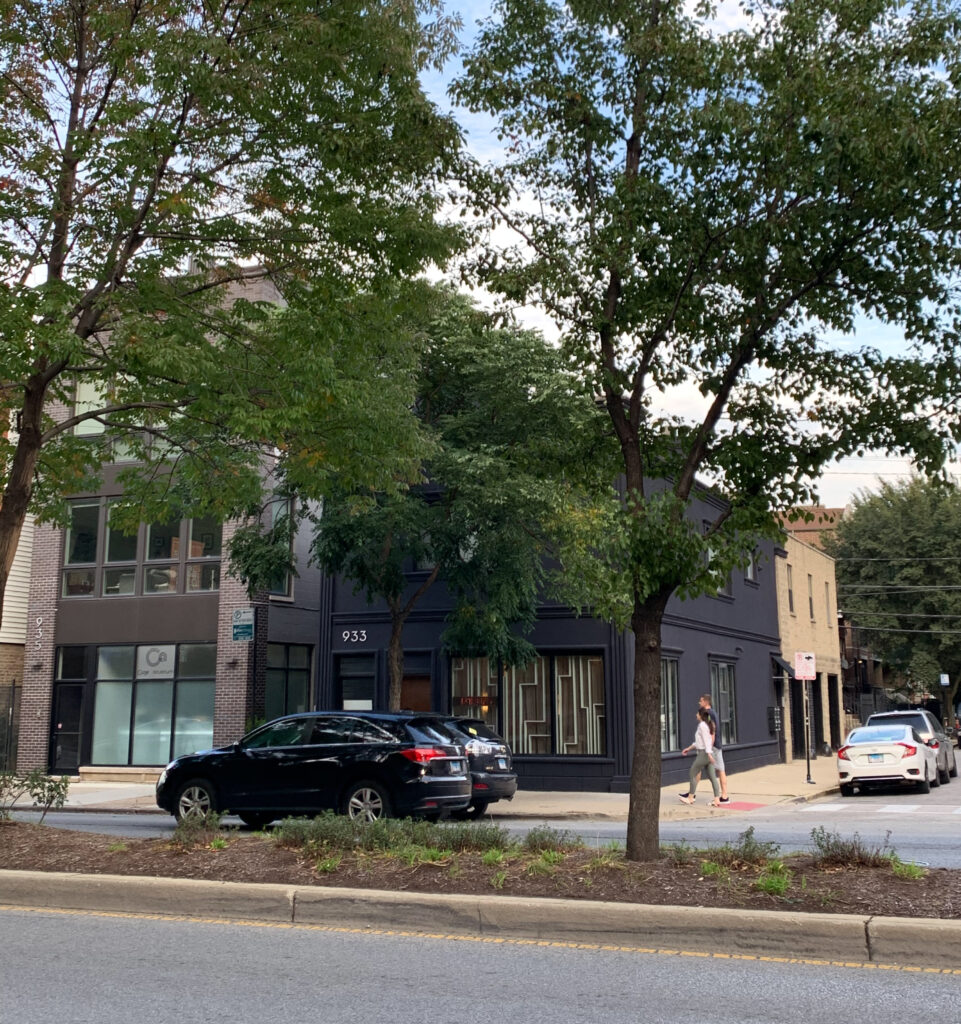
Yes, Temporis feels isolated in this liminal part of the city, reflecting not only the passage of time but the transformation of space as a relatively unknown community gets slowly swallowed up by its more fashionable neighbors. But is this not just a matter of definition? The residents of Noble Square still enjoy their quiet nook just west of the highway, and they surely enjoy having access to places like All Together Now, Boeufhaus, KAI ZAN, Parson’s, Provaré, Split-Rail, Tortello, and Wazwan well within reach. Even the riches of Logan Square and West Loop, truth be told, are not all that far away.
This is an area defined by access to a bevy of the city’s best restaurants as much as it is by what is on your particular block, and those who crave fine dining can easily find their way to Elske, Ever, Oriole, or Smyth in as little as five minutes. Nonetheless, the immediate area is defined more by Kasama (with its daytime operation and $255 nighttime tasting menu) and Porto (with à la carte fare and a $120 set menu of its own). These Michelin-starred concepts are among the most recent in Chicago to receive one of Bibendum’s high honors. They each put forth a very particular kind of cuisine (“Filipino-inspired” and Galician/Portuguese respectively) that engages a clear sense of novelty.
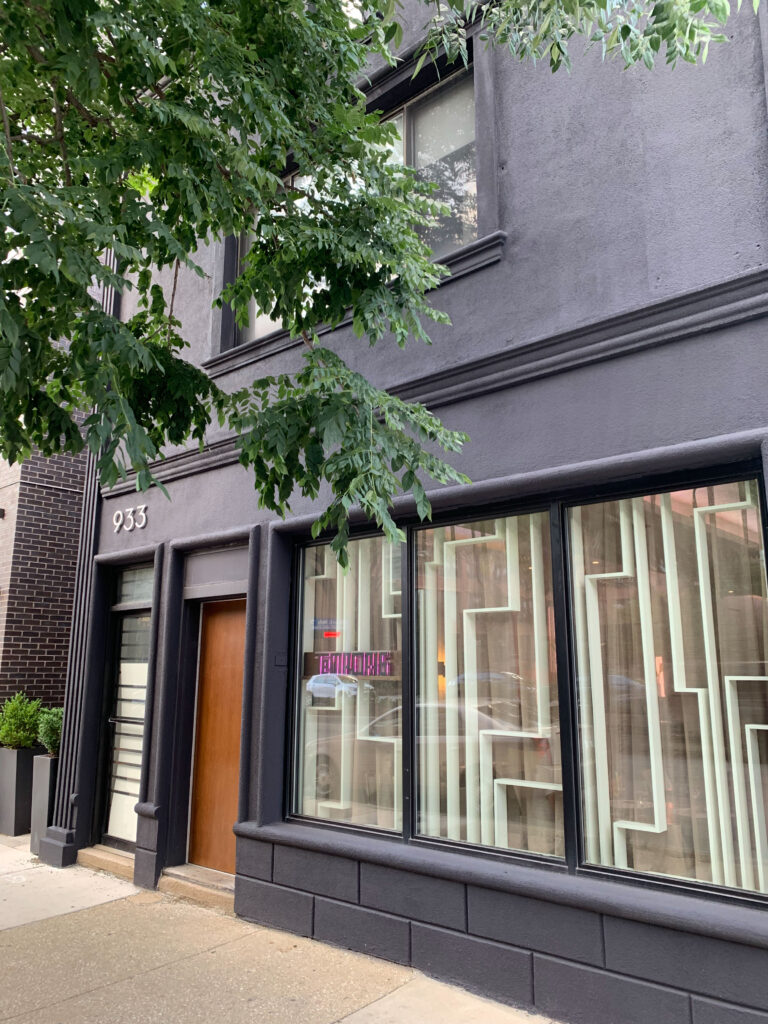
Temporis, by comparison, is a relative institution: the “progressive American” place around the corner promising a straightlaced fine dining experience with no smoke, no mirrors, no pigeonholing into a set theme. Sitting in the restaurant’s dining room and looking through the curtain out onto the street, you note just how many passersby (often towing dogs) stop to peer into the space. “Why are the lights so dim and the tables set so far apart in there,” they no doubt ask themselves (unable to discern much more than the outline of wine glasses and plates). Visually, the building’s façade, unlike its brick-clad brethren on the block, is rendered in matte black stone with columns on the corners. The door, in contrast, is done in a rich shade of brown while each of the windows is set with uneven segments of white wood that, forming right angles, give the impression of patchwork. That name—“Temporis”—reveals little but evokes a Latinate formality. Turning to Google, such a passerby may learn the place offers “creative New American” tasting menus and wine pairings at a premium price point.
This sense of mystery (combined with the relative friendliness that “American” cuisine signals) could, maybe, be enough to get some percentage of the looky-loos through the door. Of those people who are willing to spend $215 per person on dinner, surely some are inclined to try the place next door whose popularity (depending on the proportion of those 20 seats that are filled) has been affirmed firsthand. However, it seems more likely that prospective diners have scanned the Michelin Guide and settled on Temporis as the best of countless options (or at least the one, right now, that allows them to say they have tried them all).
That $215 ticket price (exclusive of a 20% “service charge”) ranks higher than Galit ($88), Sepia ($95), Elske ($125), North Pond ($125), Kyōten Next Door ($159), Atelier ($165-$195), Schwa ($165-$195), Topolobampo ($165), Boka ($175), Goosefoot ($175), Next ($175-$195), EL Ideas ($185), Valhalla ($188), and Mako ($195) at the one-Michelin-star level but lower than Omakase Yume ($225) and Esmé ($235-$265). It even costs more than Smyth’s truncated “Classic” menu ($175), but it is worth considering that Temporis has started to offer its own “abridged” menu ($135) every other Wednesday.
This is all to say: the restaurant is among the most expensive in its category and even knocks on the door of two-Michelin-starred concepts like Moody Tongue ($285), Smyth ($285), Oriole ($295), and Ever ($325). “Why not spend $75-$110 more to ascend to what Bibendum has ‘objectively’ declared to better?” some consumers may ask. These places are also “contemporary American” in style and, assuming a lack of price sensitivity when it comes to planning that special occasion, promise a fine dining experience that is just a little more “fine.”
Yet, other consumers may perceive that second or third Michelin star as reflecting a certain stuffiness, and they may see value in selecting one of the pricier, more elongated tasting menus out of the one-Michelin-star “contemporary American” bunch (Sepia, North Pond, Atelier, Schwa, Boka, Goosefoot, EL Ideas, Valhalla). None of these concepts are wedded all too strictly to a particular theme, and it follows that Temporis—costing more—will deliver more (vis-à-vis portion sizing and luxury ingredients). Such logic calls a car lot to mind: is it better to get a fully-loaded entry-level model or squeeze your way into the stock version of a more premium machine? When you consider the incidence of supplemental courses and the near necessity of purchasing beverages, those two- and three-Michelin-star properties can quickly balloon in price. Just the same, the $75-$110 per person difference to get you in the door represents just about what it takes to secure a wine pairing at Temporis.
Whatever the logic that brings you there, expectations will necessarily run high as you approach 933 North Ashland. This is one of Chicago’s most expensive dining experiences, and Temporis reveals very little of its substance until you see, smell, and taste it for yourself.
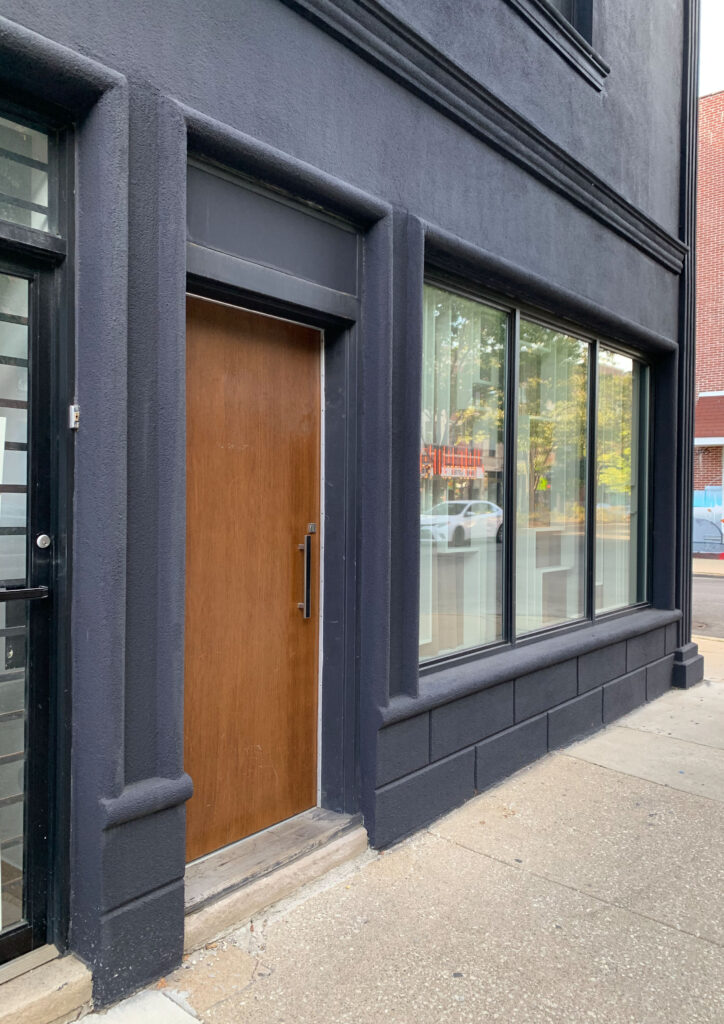
The restaurant’s building, once you have chosen to seek it out, feels more or less fitting. The setting is certainly not picturesque like North Pond, but it compares favorably to other establishments by occupying its own corner and standing proudly—but unostentatiously—there. The tones of black and white woodworking, likewise, satisfy the “contemporary” aesthetic while the warmer tone of the door, in turn, serves as a subtle welcome. This is not a palace—not a place to see and be seen—but an intimate, self-possessed space for the celebration of culinary artistry.
Stepping through the portal, you prepare to be transported. After traversing a short vestibule, you find yourself there: a sleek, minimalist restaurant that is more or less encapsulated in one single room.
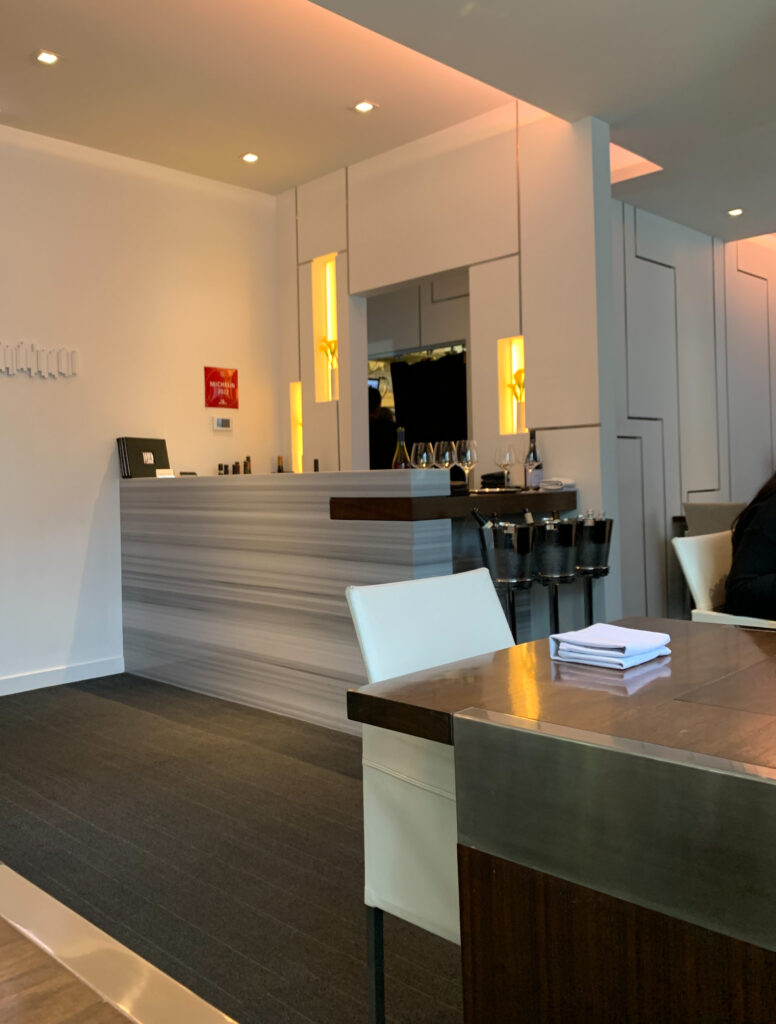
Immediately before you stands a pony wall rendered in a cool, gray gradient. A full-sized wall, centered behind it, is painted white and features irregular grooves that call the patterns in the windows to mind. A few larger cubbyholes contain vases and plant life bathed in yellow light while, off to one side, red Michelin plaques hang as a reminder of Temporis’s pedigree.
Otherwise, this pony wall, which wraps around along the other side, doubles as a host stand and a service station. Wine bottles are strategically positioned at one end of the service while a trio of ice buckets are ergonomically tucked in an alcove facing the diners. Beyond the rear wall, a passageway leads to the kitchen: a tight but tranquil work area that you only get the slightest glimpse of.
Before you can dwell much longer at the entrance, you are warmly greeted by longtime captain Laura Bonetti—a former opera singer, corporate trainer, and now “mother hen” of Temporis. She receives your party with the confidence and charm that can only come with anticipation, recognizing your reservation (there are only 20 seats spread across five timeslots after all) before you even need to provide a name. Compared to some fine dining host stands, two or three cold, suited employees deep, that make you feel like you are facing a firing squad, entering here feels effortless and immediately comforting.
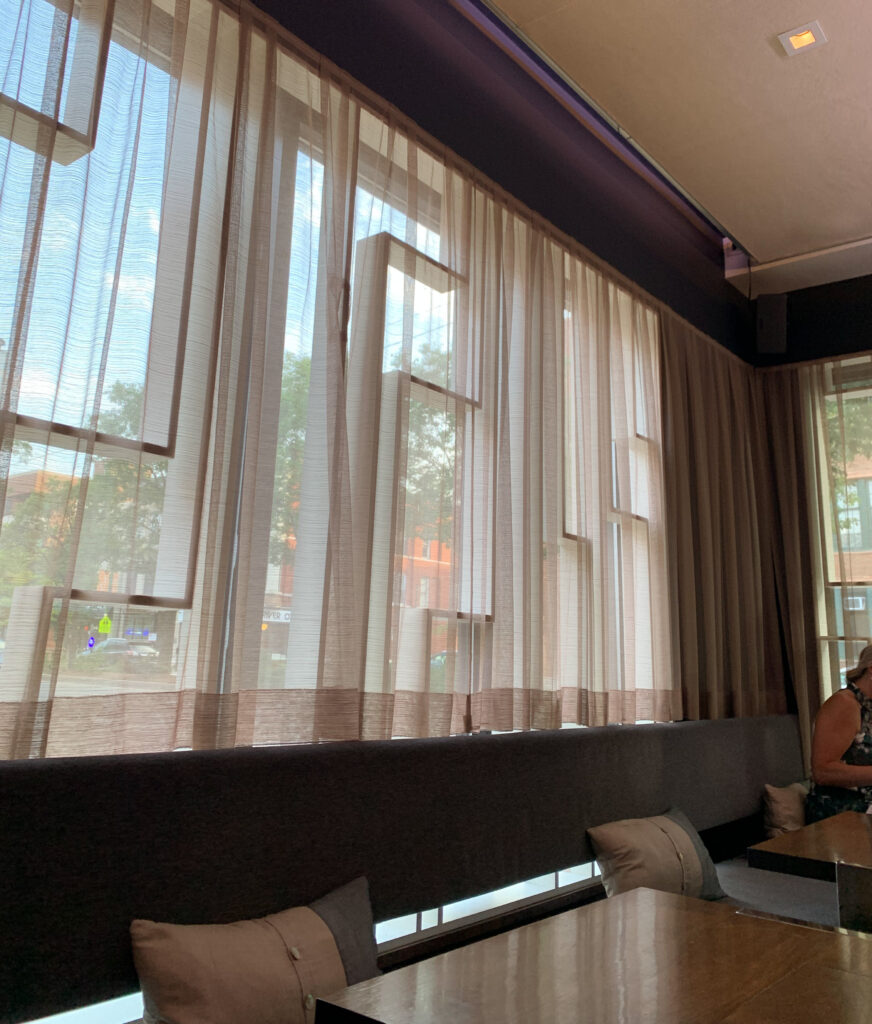
Taking just a few steps sideways, you find yourself in the middle of the dining room: a set of three freestanding two-tops running along the vestibule and kitchen walls with a pair of banquettes (seating eight and six in various configurations) opposite them. The color palette mixes whites (the walls, chairs, ceiling, and curtains), grays (the banquettes and carpeting), browns (the tables and a dividing wall that doubles as glassware storage), and black (some of the other walls) with bursts of polished metal and warm lighting from wall-mounted lanterns. Otherwise, some additional right-angled grooves continue to extend the pattern seen in the windows while a couple pieces of abstract art—painted in blocks of bluish-green—form a thoughtful contrasting element.

To the rear of the dining room, past a curtain, you find a set of bathrooms designed with the same grayscale tones and stocked with Temporis-embroidered towels, an LED-embedded mirror, a grided mirror wall fixture, a stock of toiletries, and a solitary pot of flowers.
Though the restaurant failed your “towel test” (a challenge that, in truth, demands a level of staffing and attention to detail that you would not expect from such an intimate concept) these backstage areas feel impressively luxe and totally pristine. If there’s a prototypical “Michelin-starred bathroom,” it would be very close to this.
And, overall, you find Temporis’s ambiance to be attractively cohesive and understated. Nothing here quite screams “luxury,” but there is a consistent layering of motifs and materials that sets a refined, curated tone. It feels comfortable—not quieting—to sit in the space, and the details (particularly the plant life and use of wood) articulate how the restaurant marries contemporary, minimalist design with an enduring sense of nature. Ultimately, this amounts to a visual representation of the restaurant’s culinary identity: “the passage of time” and the transcension of seasonality through the use of the hydroponic garden, which controls nature much in the manner those various vases are embedded throughout the cool, modern space. It also reminds you a bit of Ever (the hanging raw ingredients juxtaposed by the foreboding Lawton Stanley space) on a smaller, more humble scale. That seems serendipitous given Jorge’s experience working under Duffy, and it helps situate Temporis as part of a kindred “contemporary American” school.
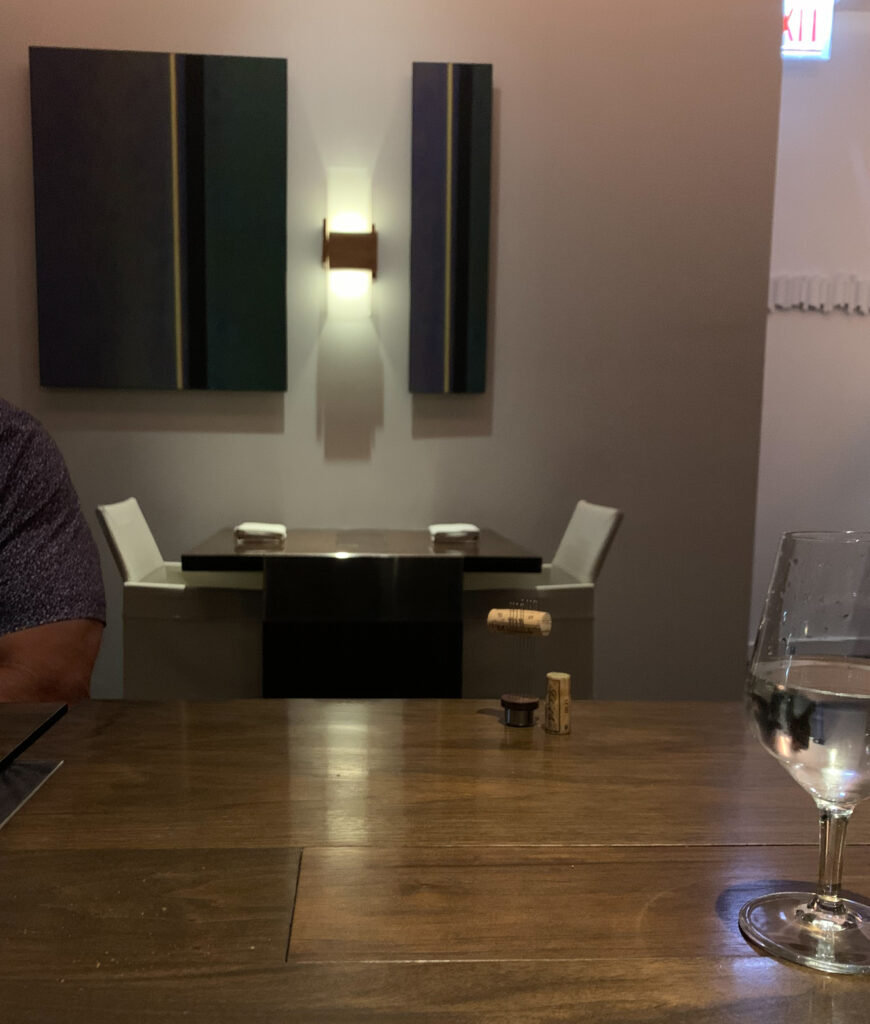
Upon leading you to your seats, the captain inquires about water preferences and returns, in short order, to fill the glasses. Your server—one of three other front-of-house figures working the floor—also introduces themself around this time. Given that Temporis serves one solitary tasting menu, there is not too much ground to cover. They stoke your excitement for the 11 courses to come, double check any dietary restrictions, and offer any applicable supplements (which have included caviar and wagyu in the past but not during your particular visits). They also broach the prospect of beverage pairings, a key part of the restaurant’s identity since opening that today exists in a surprisingly elaborated form.
When booking dinner through Tock, Temporis prompts you to choose one of four pairing options but also assures “guests are welcome to chose [sic] upon arrival.” Of course, there are wines by the glass and by the bottle to consider too. Yet, many consumers (especially those for whom this kind of dining is still entirely novel) will be drawn toward a turnkey solution: select and pay for everything now then simply sit back and relax when it comes time for dinner. You can see the logic there, and you even understand why certain experiences (like Smyth’s Chef’s Table) demand that you commit to one of two higher priced pairings.
Encouraging (or enforcing) these choices ensures a certain minimum spend while empowering a restaurant to strategically open and pour expensive bottles with as little wastage as possible. For that reason, you sometimes assume that committing to a premium pairing in advance will help secure a superior selection. The restaurant, in this manner, need not scramble during service to open bottles that fit the bill but can carefully curate an assortment of wines over a longer period of time (using a Coravin or other preservation systems) that puts its program’s best foot forward.
You thought this might be the case with Temporis’s “Grand Reserve Pairing” ($325), which is priced beyond Oriole’s top “Reserve” pairing ($285) and only surpassed by Smyth’s “Super Mega” ($355) and Alinea’s “The Alinea Pairing” ($395) options within Chicago. This is quite glitzy company to be in, and you naturally wondered how frequently a 20-seat restaurant with only one Michelin star was actually pouring such a superlative splurge. Prior committal, thus, seemed like the polite thing to do, and you eagerly awaited the vinous delights Temporis would have in store. However, not only did the “Grand Reserve Pairing” ultimately disappoint you (more on that in a bit), but you came to learn that the restaurant offers a printed comparison of each of the options if you delay making your choice until the night of the reservation. They even allow diners to split pairings by ordering a half-pour version! So, in truth, there is little reason to commit on Tock when you can make a more informed decision in person.
The pairings offered during the course of your visits have included:
Spirit Free Pairing ($75)
- “Chamoy” (peach, mango, bay leaf)
- “Basil” (elderflower, lemon, parsley)
- “Lapsang” (orange, star anise, cinnamon)
- “Guajillo” (verjus rouge, cherry bitters)
- “Coffee” (rosemary, orange)
Standard Pairing ($115)
- R.H. Coutier Blanc de Blancs Grand Cru Brut Champagne
- 2021 Luis Pato Vinhas Velhas Branco
- 2021 Guy Breton “Cuvée Marylou” Beaujolais-Villages
- 2018 Clos Figueras “Font de la Figuera” Priorat
- 2020 Domaine de la Bergerie “Le Clos de la Bergerie” Coteaux du Layon
Reserve Pairing ($175)
- André Heucq “Héritage” Blanc de Meunier Brut Nature Champagne
- 2017 Bernard Moreau et Fils Saint-Aubin “Sur Gamay” Premier Cru
- 2018 Bruno Clair Fixin “Champ-Perdrix”
- 2017 Il Colle Brunello di Montalcino
- 2021 Weingut Keller Rieslaner Auslese
Grand Reserve Pairing ($325)
- 2012 Pierre Paillard “La Grande Récolte” Grand Cru Extra Brut Champagne
- 2009 Malat “Gottschelle” 1ÖTW Grüner Veltliner
- 2019 Domaine Jean Francois Sanford & Benedict “The Twelve Rows” Pinot Noir
- 2017 Alto Moncayo “Aquilon” Campo de Borja Garnacha
- 2013 Kracher “No. 1 Nouvelle Vague” Rosenmuskateller Trockenbeerenauslese
Now, having tried the “Spirit Free Pairing,” you would say that the drinks are competently executed and worth the money (for those avoiding alcohol) if not quite rising to the level of places like Ever or Oriole. Most of them make use of Seedlip products as a base but harmonize nicely with their chosen dishes (e.g., basil with a tomato-focused dish or star anise with a Pernod-spiked preparation of lobster). While the “Chamoy” tastes a bit muddled to you, the “Guajillo” is the best of the bunch with full, only faintly sweet Kool-Aid flavor to match the headlining preparations of meat. The closing “Coffee,” made with decaf Sparrow beans, offers a play on an espresso martini that looks every bit the part. It cannot quite replace the real thing but will likely delight teetotalers who are otherwise unable to enjoy such a trendy cocktail.
Turning toward the alcoholic options, it should be kept in mind that Temporis offers healthy pours of these five wines so that they may stretch over multiple courses. And, when you consider that seven of the 11 dishes on any given night are savory, that means you get one sparkling, one white, and two reds to carry you through the heart of the meal. Such a format may make for a pairing that is less varied and engrossing at the end of the day; however, theoretically, it should also help to ensure a higher overall quality of product while limiting the number of bottles that could potentially spoil due to a lack of adequate interest.
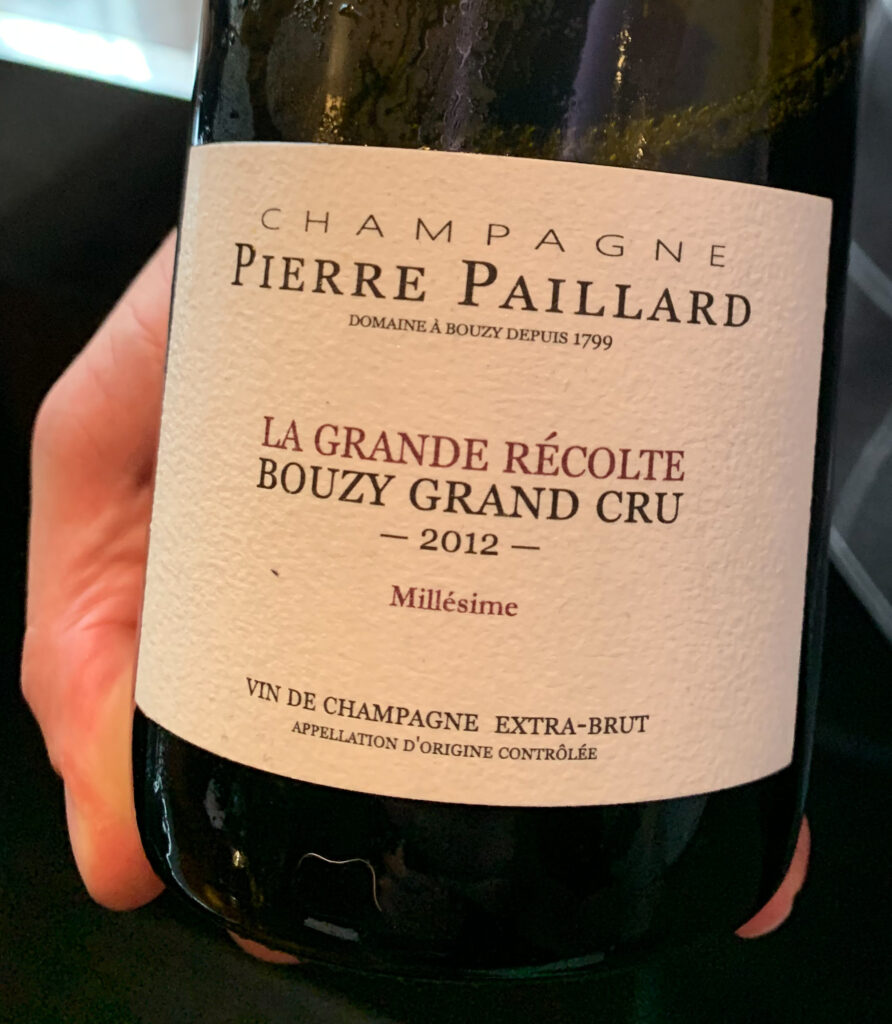
On paper, you actually find both the “Standard” and “Reserve” pairings to be quite strong. They balance top-value producers (Coutier, Heucq, Pato, Breton) with name recognition (Moreau, Clair, Keller) while ticking all the traditional boxes: Champagne, Chardonnay (or something like it), Pinot Noir (or something like it), a heavier red, and something to go with dessert. Truthfully, when you consider the expressiveness of the Blanc de Meunier style of Champagne and the relative age of its two Burgundies (2017 and 2018), the “Reserve Pairing” represents a rare sweet spot in the lineup. While still being priced at less than the cost of the tasting menu itself (and backed up by a “Standard” option that is by no means an afterthought), it may even rank among the best of these premium offerings in all of Chicago.
By virtue of its price, the “Grand Reserve Pairing” should have delivered an even greater degree of pleasure than its more approachable brethren. However, its selections left you feeling cold in the moment and positively gipped with further reflection. Yes, you actually found yourself coveting the 2021 Weingut Keller Riesling you saw being poured (at the time) for other patrons as part of their “Reserve Pairing.” And, later seeing the breakdown of each flight side by side, you feel that Temporis is a bit guilty of needless premiumization.
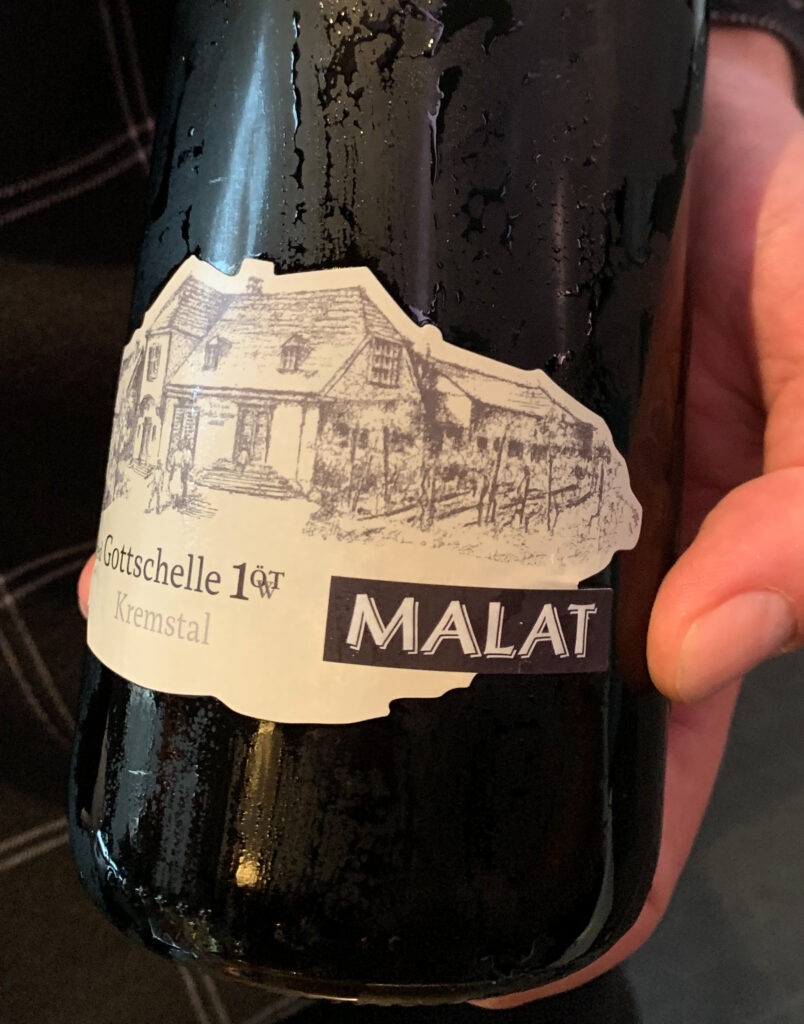
For example, while the 2012 Pierre Paillard Champagne shines as a vintage-dated offering (relative to the non-vintage Coutier and Heucq), it has recently been released onto the market ($169.99) and does not really reflect any special degree of maturity. The same goes for the 2019 Jean Francois and 2017 “Aquilon,” wines that are still widely available at retail (for $114.96 and $179.99 respectively). While the 2009 Malat Grüner Veltliner does offer the kind of age and rarity you are after—at least as a distinguishing factor—the wine is from a fairly unknown producer and typically retails for around $45. The Kracher, instead, is from a well-known producer and can claim a bit of age. However, it is not quite unique and is not capable of carrying such an expensive pairing by itself.
Surely, your personal wine preferences may play a part in shaping your perception here. And, to be fair, those two Burgundies you like from the “Reserve Pairing” are available locally at retail (for $74.96 and $59.00 respectively). Yet, with the “Grand Reserve Pairing,” you get the sense that the restaurant has simply sought to offer more expensive bottles for the sake of doing so. Whether that is intended to sneakily divert consumers toward the middle category (which now seems like a relative deal) via anchoring or to simply allow certain “special occasion diners” to feel extra special (with a guaranteed 20% service charge sprinkled on top) is uncertain.
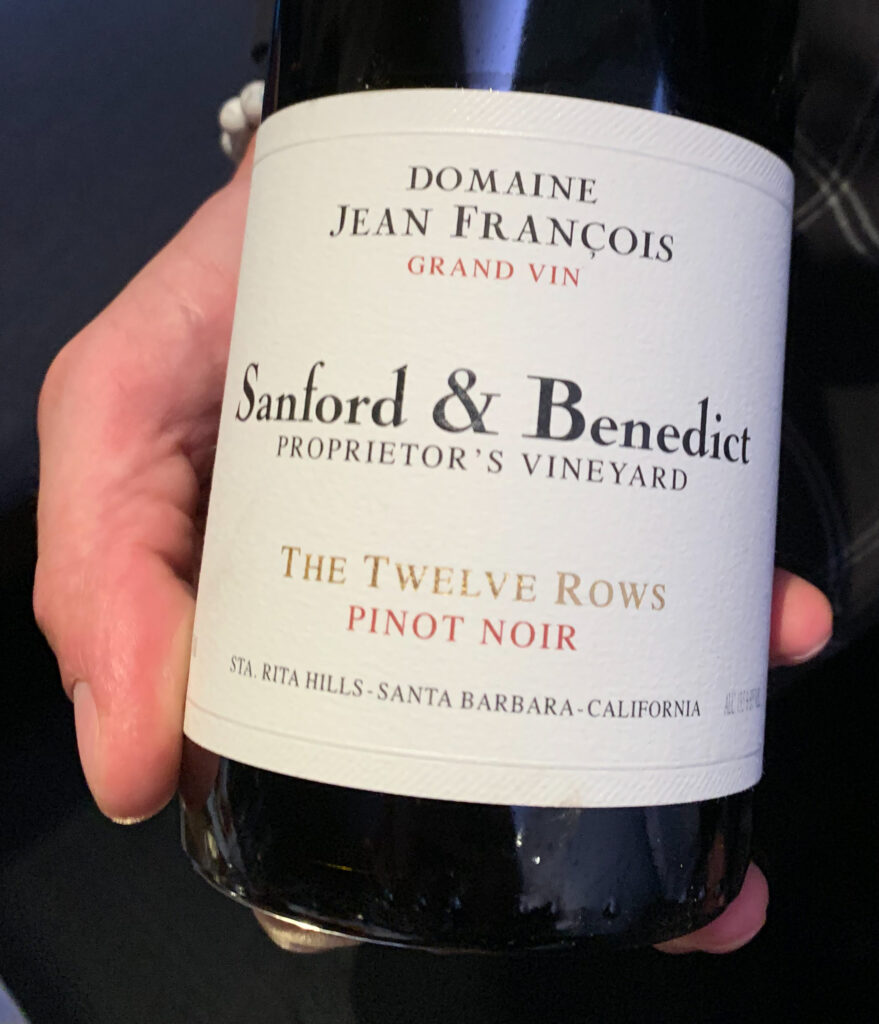
Really, the “Grand Reserve Pairing” is not deceptive in any way so much as it is uninspiring. It lacks the sense you are being poured a pleasant surprise—and, thus, receiving good value—that the other selections maintain. Thus, rather than searching for current release wines that retroactively satisfy “splurge” pricing, Temporis would do better by drawing more on the aged bottles in its cellar or excising this option altogether. For, any diner willing to invest in such a premium pairing is not the kind of customer a restaurant can stand to disappoint (no matter the short-term gain). At this price, any misgivings may even run the risk of spoiling any positive impression of Temporis’s food.
Nonetheless, the restaurant’s à la carte beverage options offer oenophiles—at least those who want to go beyond the “Standard” and “Reserve” pairings—some relief. The selection begins with a range of classic cocktails (like a “Negroni,” a “Manhattan,” and an “Old Fashioned”) and the more colorful “Chicago Franken Spritz” (Prosecco, grapefruit liqueur, Malört, lemon, soda). There is also a small assortment of beers (predominantly sourced from Chicago and the wider Midwest) along with a couple premium ciders.
The range of wines offered by the glass do not seem like much to write home about on the surface:
Champagne
- 2014 Gramona “Imperial” Brut Cava ($23)
- André Heucq “Héritage” Blanc de Meunier Brut Nature Champagne ($37)
White
- 2019 Martin Woods “Hyland Vineyard” McMinnville Riesling ($21)
- 2019 Emile Beyer “Tradition” Alsace Pinot Gris ($15)
- 2021 Pax Mahle “Lyman Ranch” Amador Chenin Blanc ($23)
- 2019 Mount Eden Vineyards “Wolff Vineyard” Edna Valley Chardonnay ($20)
- 2020 Vincent Gaudry “Le Tournebride” Sancerre ($25)
Rosé
- 2022 Domaine de Fontsainte “Gris de Gris” Corbières ($15)
Red
- 2021 Guy Breton “Cuvée Marylou” Beaujolais-Villages ($16)
- 2018 Russian River Vineyards Sonoma County Pinot Noir ($20)
- 2015 Terre Rouge “Les Côtes de l’Ouest” California Syrah ($14)
- 2020 Tyler Happy Canyon of Santa Barbara Cabernet Sauvignon ($31)
Dessert
- Château de Laubade Floc de Gascogne ($8)
- Jean Bourdy “Galant des Abbesses” ($19)
- David Ramnoux Pineau des Charentes ($12)
However, even when you consider that a couple of these bottles appear as part of the pairings, this is actually a smart selection. It is representative of all the major grape varieties (including a few eclectic sweets) while offering pours with a bit of age from notable producers and regions. None of these wines will necessarily send nerds’ tongues wagging, but you also don’t see them being served all over town. With the feeling that you are drinking something that is at least a little bit unique, you can get a decent Chardonnay or Pinot Noir for $20. Thus, imbibing few of these glasses may present an attractive value for diners who do not want to spend $115 on the “Standard Pairing” (or even spend $57.50 on half-pours).
That being said, the bottle list is where lovers of wine will find themselves richly rewarded. The following represent some of the collection’s highlights:
Sparkling
Jean-Luc Mouillard Crémant du Jura ($90)
R.H. Coutier Grand Cru Rosé Champagne ($140)
Lacourte-Godbillon “Mi-Pentes” Premier Cru Champagne ($150)
Vilmart & Cie “Grande Réserve” Premier Cru Champagne ($150)
Billecart-Salmon Brut Rosé Champagne ($185)
2009 Jacquart Blanc de Blancs Champagne ($185)
Pierre Moncuit Blanc de Blancs Grand Cru Champagne ($185)
2014 Paul Bara Grand Cru “Millésime” ($200)
Egly-Ouriet “Les Vignes de Vrigny” Premier Cru Champagne ($215)
2002 Thiénot “Cuvée Alain Thiénot” Champagne ($245)
2007 Philipponnat “Clos des Goisses” Champagne ($350)
Krug “Grande Cuvée” Champagne ($420)
2013 Pol Roger “Sir Winston Churchill” Champagne ($580)
White
2014 Reichsgraf von Kesselstatt Riesling Kabinett ($85)
2020 Antoine Jobard Aligoté ($90)
2021 Massican “Annia” White Blend ($90)
2010 Joh. Jos. Prüm Graacher Himmelreich Riesling Spätlese ($100)
2021 Weingut Keller Riesling Trocken ($105)
2021 Weingut Keller “Limestone” Riesling Kabinett ($115)
2016 Domaine Huet Vouvray “Le Mont” Demi-Sec ($130)
2018 Maximin Grünhaus “Abtsberg” GG Riesling ($135)
2021 Weingut Keller “Von der Fels” Riesling ($135)
2020 Nicolas Jay “Affinités” Chardonnay ($140)
2018 Dönnhoff Niederhäuser Hermannshöhle Riesling Spätlese ($150)
2017 François Carillon Puligny-Montrachet ($185)
2014 Peter Michael “Mon Plaisir” Chardonnay ($195)
2020 Aubert “Larry Hyde & Sons” Chardonnay ($215)
2015 Kongsgaard Chardonnay ($230)
2016 Nicolas Joly Clos de la Coulée de Serrant Chenin Blanc ($240)
2020 Antoine Jobard Saint-Aubin “Sur le Sentier du Clou” Premier Cru ($265)
2018 Didier Dagueneau Pouilly-Fumé “Silex” ($270)
2019 François Raveneau Chablis ($285)
2018 Vincent Dauvissat Chablis “Les Preuses” Grand Cru ($320)
2020 Antoine Jobard Meursault Blagny Premier Cru ($420)
2013 Trimbach Clos Ste. Hune Riesling ($515)
2020 Weingut Keller “Westhofen Kirchspiel” GG Riesling ($520)
2020 Weingut Keller “Abts E®” GG Riesling ($520)
2015 Jean-Marc Roulot Meursault “Les Vireuils” ($560)
Red
2020 Grégoire Hoppenot Morgon “Corcelette” ($100)
2011 Domaine du Collier Saumur “La Charpenterie” ($165)
2016 Jean-Marc Morey Beaune “Les Grèves” Premier Cru ($175)
2017 The Eyrie Vineyards “Daphne Vineyard” Pinot Noir ($175)
2019 Weingut Keller “Reserve” Spätburgunder ($185)
2019 Nicolas Jay “Own-Rooted” Pinot Noir ($195)
2015 Paolo Bea Montefalco “Pipparello” Riserva ($195)
2018 Chappellet Cabernet Franc ($210)
2018 Bruno Clair Chambolle Musigny “Les Veroilles” ($240)
2015 Paolo Bea Montefalco “Pagliaro” ($240)
2016 Auguste Clape Cornas “Renaissance” ($250)
2009 Marqués de Murrieta Rioja “Castillo Ygay” Gran Reserva Especial ($250)
2006 Château de Beaucastel Châteauneuf-du-Pape ($260)
2009 Jean-Claude Boisset Chambolle Musigny “Les Chardannes” ($260)
2012 Marchesi di Grésy Barbaresco “Camp Gros” Riserva ($270)
2009 Maison Bertrand Ambroise Clos Vougeot Grand Cru ($310)
2014 Sea Smoke “Ten” Pinot Noir ($310)
2013 Continuum Cabernet Sauvignon ($390)
2017 Elena Walch “Aton” Riserva Pinot Noir ($390)
2018 Thierry Allemand Cornas “Reynard” ($560)
2015 Sine Qua Non “Le Chemin Vers L’Hérésie” Grenache ($570)
2018 Opus One ($575)
2007 Giuseppe Quintarelli Amarone della Valpolicella Classico ($600)
1985 Château Cos d’Estournel ($750)
2018 Poggio di Sotto Brunello di Montalcino ($750)
1989 Château Montrose ($800)
2013 Hundred Acre “Ark Vineyard” Cabernet Sauvignon ($850)
1990 Château La Conseillante ($1,000)
2006 Château Margaux ($1,200)
1990 Château La Mission Haut-Brion ($2,000)
1990 Château Haut-Brion ($2,500)
By your measure, the sparkling wines may amount to the weakest part of the selection. Nonetheless, bottles like the Vilmart “Grande Réserve” ($150 on the list, $70 Wine-Searcher average), Egly-Ouriet “Les Vignes de Vrigny” ($215 on the list, $109.99 retail price), Philipponnat “Clos des Goisses” ($350 on the list, $253 Wine-Searcher average) and Pol Roger “Sir Winston Churchill” ($580 on the list, $348 Wine-Searcher average) appeal to a range of price points while maintaining markups that are right around 100% or sometimes even as low as 60%-70%. While the restaurant’s 20% service charge should be kept in mind, this restrained approach to pricing—especially when you consider the special premium Champagne usually commands—is commendable.
Turning toward the whites, you find even more to get excited about. Yes, all those bottles of 2020 Antoine Jobard and 2021 Keller are more or less current release, but these allocations form a nice foundation for the list and are generally offered around that 100% markup (if not less). (The “Limestone” Kabinett, which costs $115 and retailed for $42 in Chicago, and the “Von der Fels,” which costs $135 and retailed for $54 in Chicago being notable exceptions.)
But it is aged selections like the 2010 Prüm Spätlese ($100 on the list, $61 at auction), 2017 François Carillon Puligny-Montrachet ($185 on the list, $127 Wine-Searcher average), 2014 Peter Michael “Mon Plaisir” ($195 on the list, $139.97 at retail), 2015 Kongsgaard ($230 on the list, $195 Wine-Searcher average), and 2019 Raveneau Chablis ($285 on the list, $249.99 at retail) that impress you most.
Even the most expensive bottles—like the 2018 Dauvissat Chablis “Les Preuses” ($320 on the list, $365 Wine-Searcher average), 2013 Trimbach Clos Ste. Hune ($515 on the list, $341 Wine-Searcher average), 2020 Keller “Abts E®” ($520 on the list, $454 Wine-Searcher average), and 2015 Roulot “Les Vireuils” ($560 on the list, $428 Wine-Searcher average)—offer great value. You must consider that retail and auction prices for these wines have continually risen due to currents of scarcity and speculation. However, Temporis deserves credit for not revising its markups but, rather, patiently cellaring these bottles until the right customer comes along.
This same trend can be noted among the red wines, with bottles like the 2011 Domaine du Collier ($165 on the list, $179 Wine-Searcher average), 2018 Bruno Clair “Les Veroilles” ($240 on the list, $166 Wine-Searcher average), 2018 Allemand “Reynard” ($560 on the list, $413 Wine-Searcher average), 2018 Opus One ($575 on the list, $394 Wine-Searcher average), 2007 Quintarelli Amarone Classico ($600 on the list, $550 Wine-Searcher average), and 2013 Hundred Acre “Ark Vineyard” ($850 on the list, $813 Wine-Searcher average) falling a sweet spot where they would almost cost the same outside of the restaurant.
Those legendary aged Bordeaux—like the 1989 Montrose ($800 on the list, $710 Wine-Searcher average), 1990 La Conseillante ($1,000 on the list, $499 Wine-Searcher average), 2006 Margaux ($1,200 on the list $738 Wine-Searcher average), 1990 La Mission Haut-Brion ($2,000 on the list, $1,126 Wine-Searcher average), and 1990 Haut-Brion ($2,500 on the list, $1,283 Wine-Searcher average)—also fall at (or well under) that 100% markup despite enjoying greater price stability.
While there is also a sprinkling of more approachable Pinots from Jean-Marc Morey, The Eyrie Vineyards, and Nicolas Jay that reflect the same minimal markups, Temporis’s wine list is—at the end of the day—tailormade for connoisseurs. That is not by any means a bad thing. Frankly, it delights you. For, considering that the restaurant’s notable bottles start in the $100-$150 range, entry-level consumers will be easily drawn toward the “Standard Pairing” ($125) or “Reserve Pairing” ($175) as a turnkey solution rather than contend with picking one or two wines on their own. Oenophiles, who have typically learned to distrust pairings through painful experience, can—in contrast—use that $125, $175, or even $325 (for the “Grand Reserve”) to secure one or two attractive aged selections of their own choosing.
The math tends to work out so long as you commit to spending a couple or a few hundred dollars on a bottle, at which point some of the very lowest (relative) markups come into effect. However, even customers choosing to order something à la carte close to $100 can be assured they are not being grossly upcharged. This pervading sense of value, whether ordering a pairing or delving into the bottle list yourself, is where Temporis’s beverage program shows its real strength. After getting you in the door, the restaurant does not squeeze you for a little extra lucre but, rather, affirms wine’s role as a friendly, engaging companion through which to celebrate fine food.
Of course, you have already mentioned your issues with the “Grand Reserve Pairing,” and oenophiles should not have to spend a comparable amount à la carte in order to feel that they have beaten the market by picking the best cherries off of the list. Some of Temporis’s aged wines have been offered since the restaurant’s opening, and stocking full cases in this manner—letting them slowly develop without increasing pricing—is the right way to run a program. Just the same, holding onto this much inventory can be difficult for a small place where only an even smaller proportion of guests are going to be purchasing bottles. For this reason, you would once more like to see Temporis draw on its more mature stock to create the “Grand Reserve Pairing” (at least when it comes to $150-$250 wines that are not likely to improve dramatically).
Such a move would really stand to impress patrons who opt for the most premium set of pours (rather than leaving them disappointed as in your case). It would also empower a bit more turnover of the bottle list and allow the restaurant to do more buying. Save for Riesling and a small amount of Chardonnay, you find the $100-$200 range in each of the sections to be a bit depleted. You would love to see more Grower Champagne on offer along with wines from the Jura, the Loire, and the Savoie. Even when it comes to Burgundy and domestic offerings, you think there is room for top-quality village-level offerings and producers who reflect a more expressive biodynamic or “natural” style of winemaking. These bottles would pair brilliantly with Jorge’s food and would allow the restaurant to continue offering superlative value (as the price of these products, in turn, comes to appreciate in time).
Still, this all just amounts to a wish list and does nothing to take away from the great work Coen has done with this program. Should you avoid the pitfall of the “Grand Reserve,” you are left with a by-the-glass selection, pairings (including a decent spirit-free option), and bottle list that rank favorably against any restaurant in town. While you did not personally confirm the possibility of corkage (listed online as $35 with no limit on the number of bottles), this seems like a fair sum given the value to be had with Temporis’s own offerings.
It should be mentioned, nevertheless, that Coen acts as a beverage director and, as such, is not seen working the floor. This, again, is understandable given the 20-seat format and the need to prioritize the everyday mechanics of service. However, it also means that the servers—in addition to filling water, running food, and conducting the general flow of your evening—are tasked with telling the stories of the chosen wines.
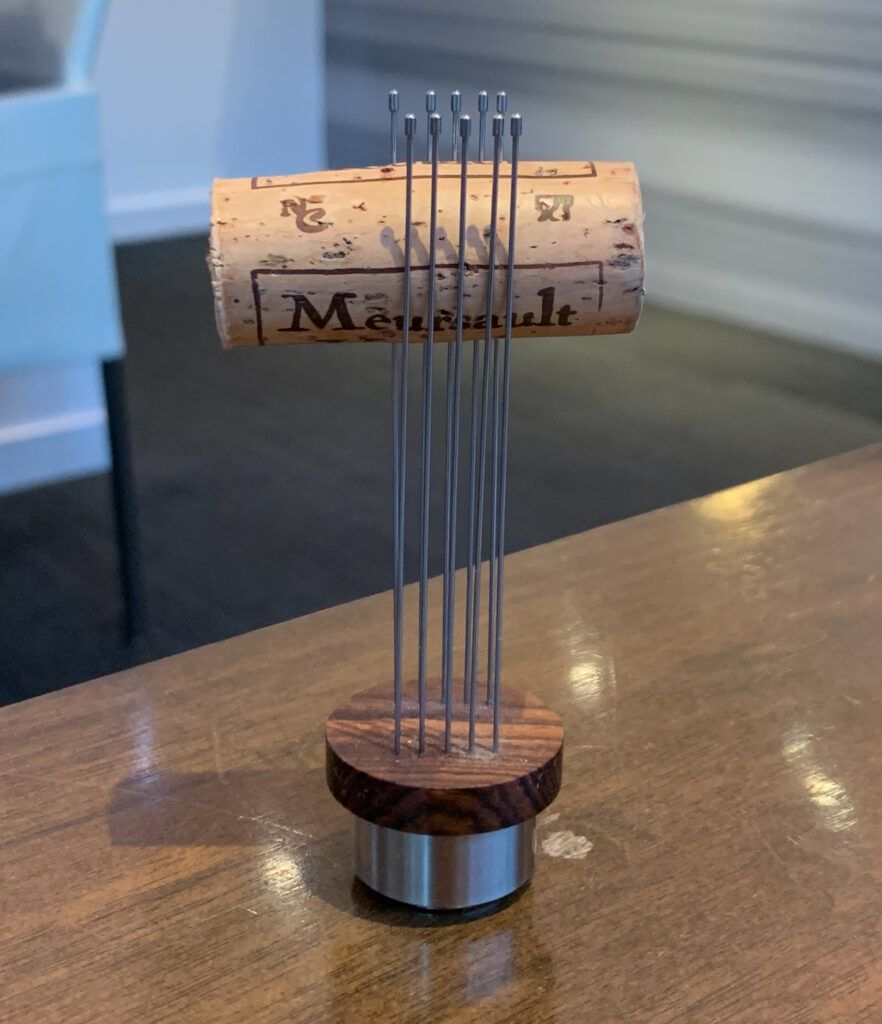
As far as the “Grand Reserve Pairing” goes, information of any enduring value was scarce. The descriptions provided for the wines deferred to general details like country of origin, vintage, grape variety, and vineyard designation (erste lagen, grand cru). Sometimes they highlighted a particular synergy with the food (Grüner with an herbaceous preparation of tomato, Grenache with a plate of wagyu). Most of these spiels—accompanied by knowing nods and smiles—failed to go beyond what an intermediate wino would consider self-evident: things that are written on the label and that form the fundamentals of classification and appreciation. You think a restaurant can get away with this when it comes to the $125 or even $175 pairings, but charging $325 demands a greater expression of expertise.
To that point, it would be nice to hear more about the nature of a particular vintage or the distinguishing winemaking practices of a particular producer. It would be even better to feel transported to these estates—to feel a bit of the romance and the terroir (both human and geological)—and be led to recognize the kindred artistry by which they and Temporis approach their respective crafts. Focusing on a bottle’s secondary and tertiary flavor characteristics, likewise, would also make for richer insights when thinking about how it might match food. These suggestions, of course, represent a tall order even for certified sommeliers (especially as there were times when your server struggled even to fill the glasses without spilling). Still, you do not think this is an entirely unfair expectation when selling such a premium pairing. Whether or not the labels command your attention, the performance certainly should.
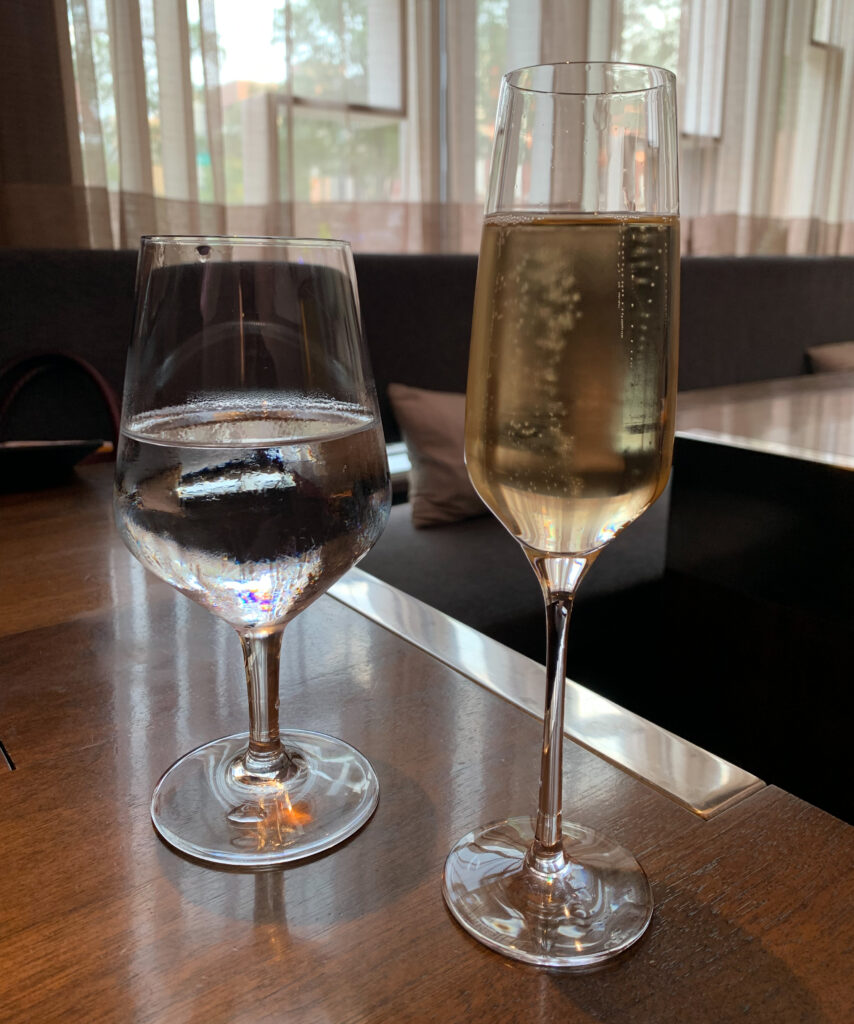
Otherwise, in terms of mechanics, you think the restaurant’s servers do quite well. When bottles are ordered off of the list, they are adept at chilling, decanting, and pouring multiple wines over the course of the meal. Your glass never sits empty for long, and the team also ensures that you have each selection in front of you before the arrival of the best accompanying dishes.
The front of house also excels in a more general sense when it comes to temperament. Mirroring Bonetti’s own glowing energy (immediately perceivable upon walking through the door), the other servers are friendly and enthusiastic. They walk the floor with confidence, watch your table attentively, and always respond to your gratitude with a gracious smile. You never get the sense that the team must rush to fulfill all its duties, yet they are also not necessarily the sort to linger and make much additional small talk. The intimate environment and staff-to-guest ratio may work to preclude that (and this might be something that changes with repeat patronage or a real effort on the part of the individual diner). However, you would label the service as warm and precise in the traditional fine dining manner rather than fitting more into an avant-garde “gastronomy doesn’t have to be so serious; we are all just friends hanging out” style.
What’s important is that the interactions feel natural, and they certainly do. Jorge’s dishes are also presented fluently with a level of detail (and, in the case of one server, intoxicating enunciation) that you found missing with the wine pairings. You feel the sense of shared passion that keeps this tight-knit team together and sets a warm, comforting tone throughout the dining room. Any lack of further self-expression—a dimension of hospitality that may facilitate deeper emotional bonding between server and served—seems more like a stylistic choice. The front of house never seems stiff, rehearsed, robotic, or uncanny. Rather, they operate, like stagehands, from a position of remove that facilitates mechanical excellence and allows the menu to shine. How is this different from Alinea or Ever? Well, you suppose you do not notice the stench of a tyrannical culture that standardizes superficial, chummy interaction in pursuit of profit.
The quality of Temporis’s front of house is rooted in longstanding figures like Bonetti, Plotnick (a regular, pleasantly inconspicuous presence on the floor in years past if not so much currently), and Jorge himself. Yes, the chef—to his great credit—is very engaging when it comes to hospitality: dropping off food, shaving truffles tableside, and sharing experimental dishes with repeat patrons. Most importantly, Jorge always makes a point of leaving the kitchen to bid guests goodbye as they head toward the door. This offers you the chance to request a picture with him if so desired or, simply, to voice your appreciation for the meal and forge some small connection with the Michelin-starred master craftsman.
In this context, the bit of restraint shown by the front-of-house team makes sense. Temporis’s food is the star, and Jorge is always there, at the ready, to imbue his compositions with an extra personal touch for the sake of pleasing his patrons. The chef strikes you as grounded, humble, and sincerely curious about guest perceptions of his work. Yet, he also emits a palpable degree of dedication and natural charisma—leavened by that charming trace of Bostonian accent—that satisfies everything modern consumers, weaned on celebrity chef culture, could want from their audience with that evening’s maestro.
Jorge, in this manner, sets the tone for the experience from the top and imbues every meal at Temporis with a dimension of romance that many of Chicago’s Michelin-starred restaurants are missing. You can count on just one or two hands the number of chefs in this city who, despite reveling in social media fame to sell their tasting menus, can actually be found behind the stove each and every evening. Still fewer are those who make it a point to interact with all of their guests—let alone who do so memorably with a real sense of presence. As someone who crafts plates that can seem rather abstract, Jorge wields his personability as an essential counterpoint. His commitment to the role of chef as host and heartfelt collaborator in setting the mood of the dining room is something the city’s other professionals—especially those backed by far bigger teams with far less to do—could learn from. Yet, in the context of Temporis, it simply ensures each meal feels like a meaningful encounter with something (artistry? soul?) that goes beyond mere food.
With your beverage order settled and all the staff at the ready, the meal commences.
To begin, rather than serving a lone amuse-bouche, Jorge welcomes guests in a grand fashion with an assortment of “Canapés.” These have reliably included a “Wagyu Dumpling,” an “Uni-Caviar Tart,” and a “Razor Clam Escabeche.” However, subsequent visits have seen the selection expand to include a “Rhubarb” drink and the chef’s signature “Mojito” bite. Each of these elements is presented daintily on its own plate or platform, with the dumpling (set on a spoon within the hollow Crucial Detail bowl made famous by Alinea’s “Black Truffle Explosion”), the razor clam (placed at the end of a ceramic faux shell), and rhubarb (served in a test tube that hangs from a twisted metal wire) being the most visually striking. Thus, while the composition does not delve fully into environmental “smoke and mirrors,” it does have a sleek, contemporary feel that introduces the chef’s precise—yet luxurious and nostalgic—style in an engaging manner.
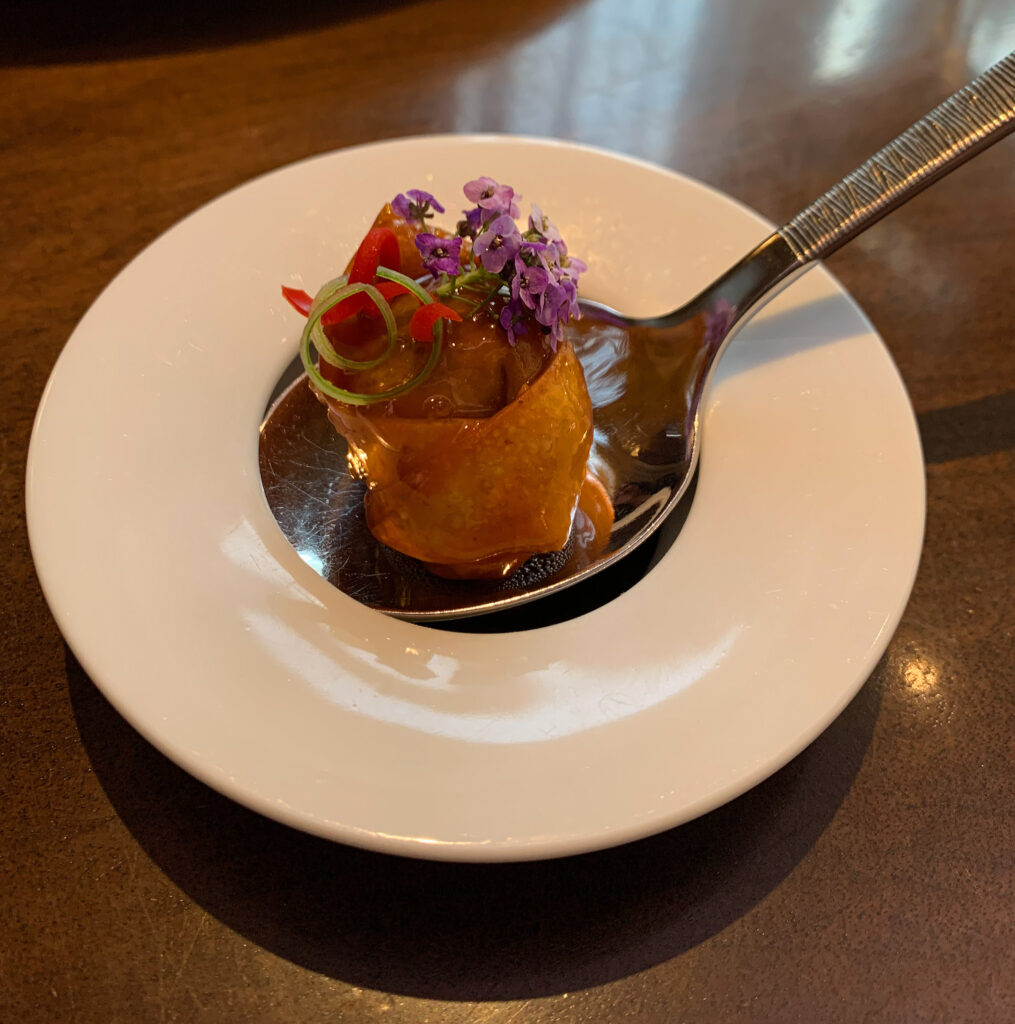
Going in order, you find the “Wagyu Dumpling” to be the strongest of the bunch. It boasts a crisp wrapper with a tender beef filling, a garnish of allium flower, and a coating of thick, syrupy ginger soy sauce. On the palate, the dumpling breaks apart cleanly (without burning your mouth), allowing the various elements to meld. You often find the flavor of wagyu to be too subtle, yet the onion notes of the allium flower emphasize the meat’s savoriness while the sweet-tangy character of the sauce combines with its fattiness to make for a lip-smacking, decadent finish. This makes for a beautifully packaged bite that you could eat by the dozen!
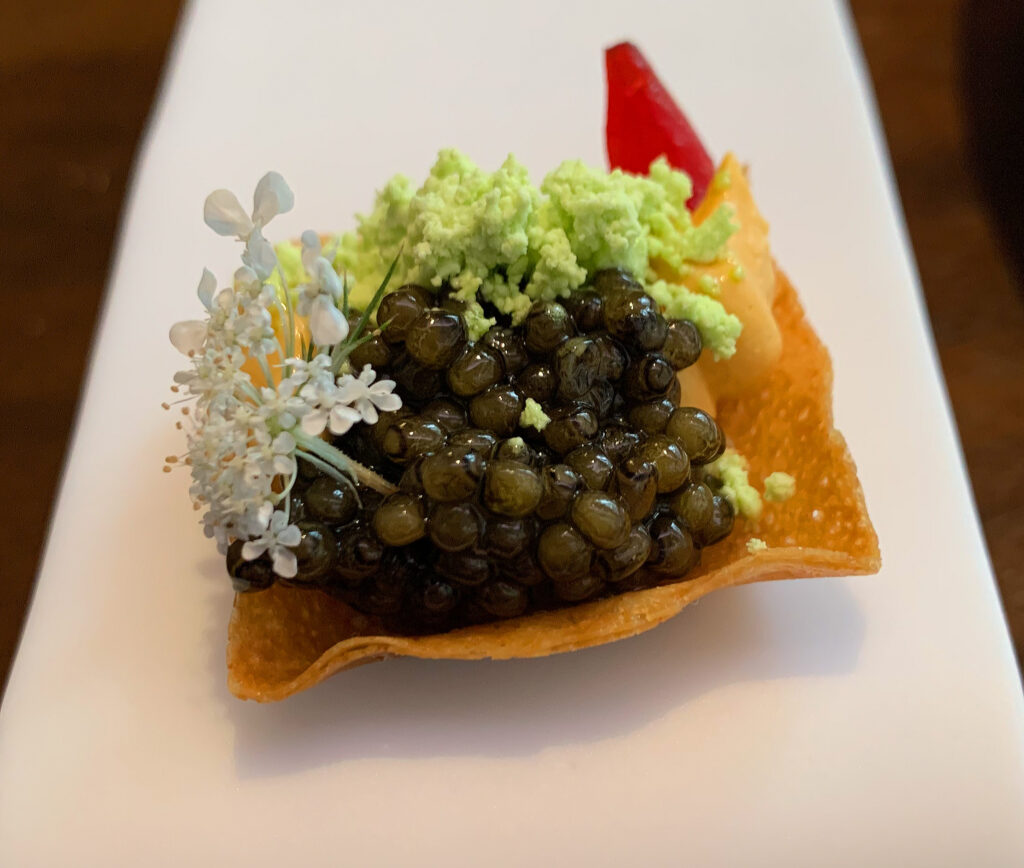
The “Uni-Caviar Tart,” by comparison, looks rather pretty with its overflowing orbs of roe but lacks intensity and persistence. The morsel sits atop a kind of cracker that reminds you of the wrapper used for the preceding dumpling. Buried beneath the caviar, you find a dollop of rather pale looking sea urchin “foam” while, atop it, sit small clumps of chive powder. Though this trio sounds impressive on paper, the tart is crisp and light but any bursting roe is hard to perceive. The flavor likewise, shows little of the nuttiness you might expect from the caviar or the briny sweetness (nor even irony quality) you associate with uni. Even the allium notes of the chive, for whatever reason, seem muted. To be clear, there’s nothing unpleasant about this bite—it just fails to come alive in the manner you would expect from such prized ingredients.
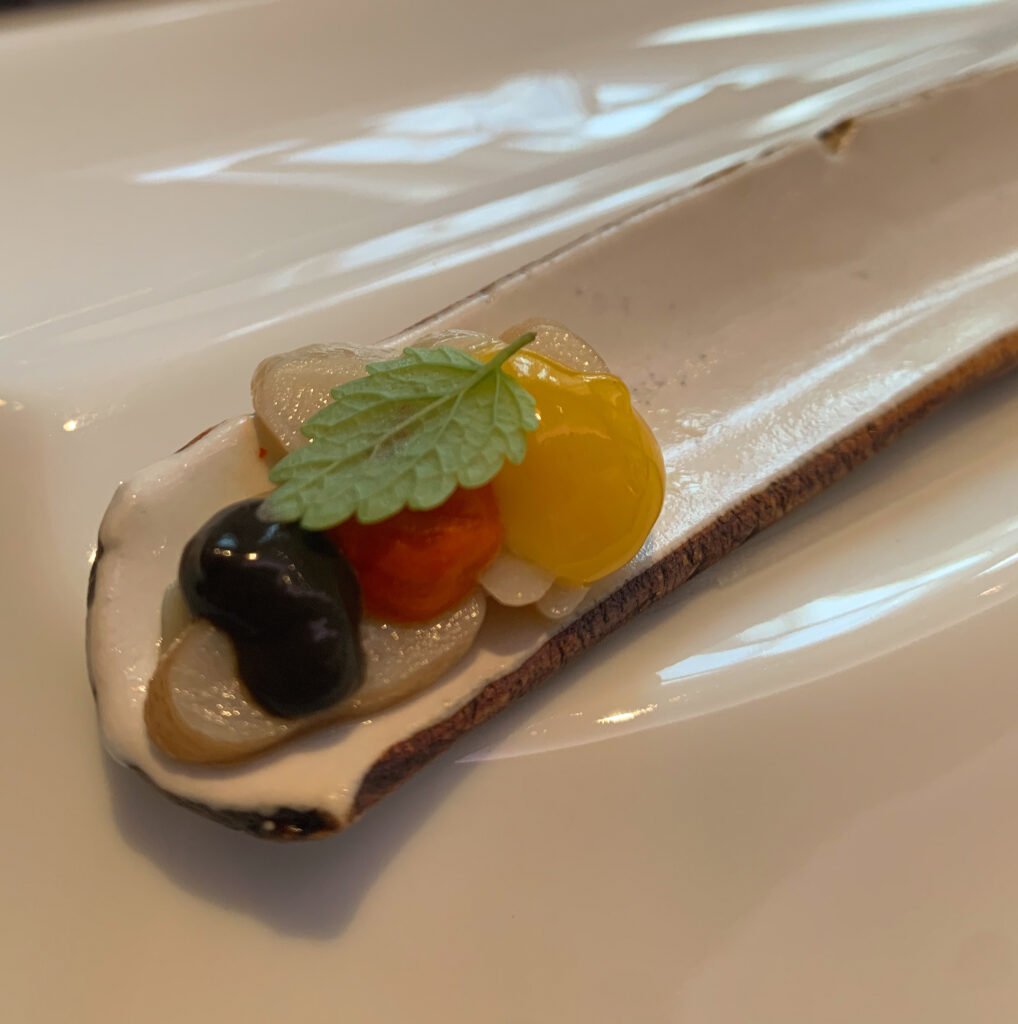
Nonetheless, the “Razor Clam Escabeche” fares better. Considering that this preparation amounts to a few slivers of the mollusk coated with a couple globules of sauce, it might be right to term it more of a “deconstructed” escabeche. However, while that term often connotes a descent into needless pretension, here it makes for a cohesive mouthful. The razor clams are pleasantly firm against your teeth and exhibit a mild, briny-sweet flavor that is enlivened by their tangy marinade. The sauces (made of piquillo pepper, lemon balm, and black garlic), meanwhile, provide subtle notes of spice and citrus (with an extra burst of umami) that offer added depth without overshadowing the small slices of shellfish. Overall, for being so dainty, this is nice.
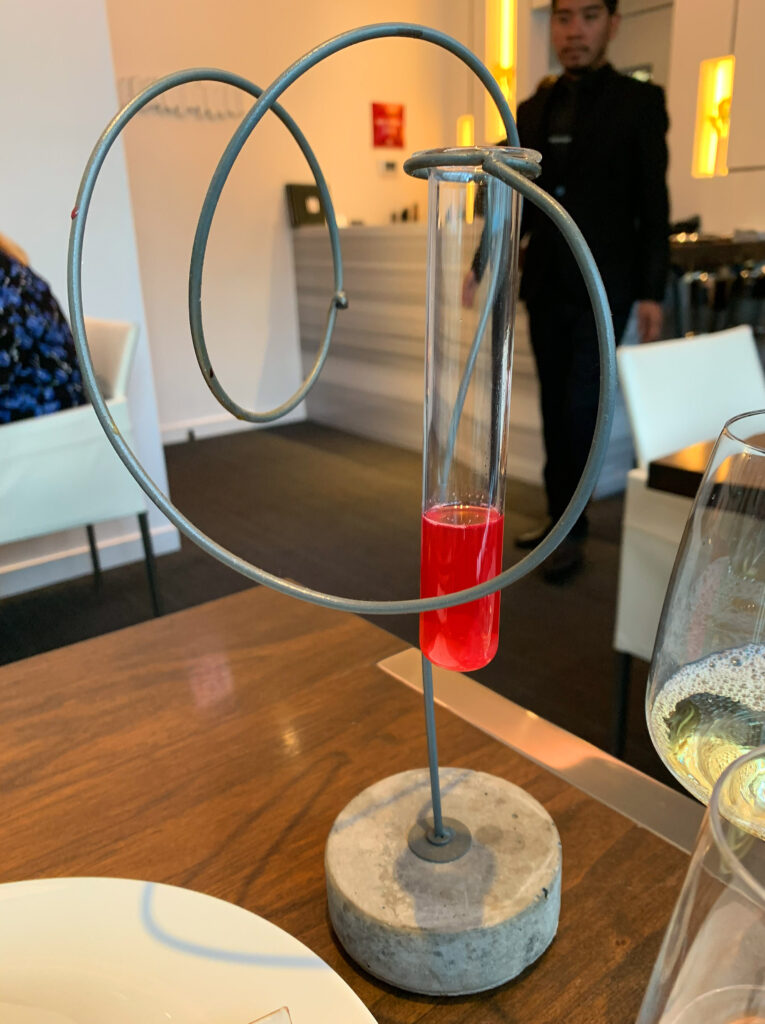
The ”Rhubarb” drink, served in its test tube, calls the “mad scientist” side of molecular gastronomy to mind. However, in practice, it amounts to a moderately fizzy soda with a dose of basil oil and some tapioca pearls hiding at the bottom. As simple as that might sound, the beverage displays an invigorating tart-sweet flavor with some complicating anisey notes and a surprisingly lasting, chewy finish. In some sense, the drink acts as a microcosm of the kind of elements Jorge likes to combine when crafting full plates: sour, herbaceous, playful, with a textural twist. However, at this point in the meal, the “Rhubarb” acts as a fun, refreshing interlude between the other parts of the opening salvo.
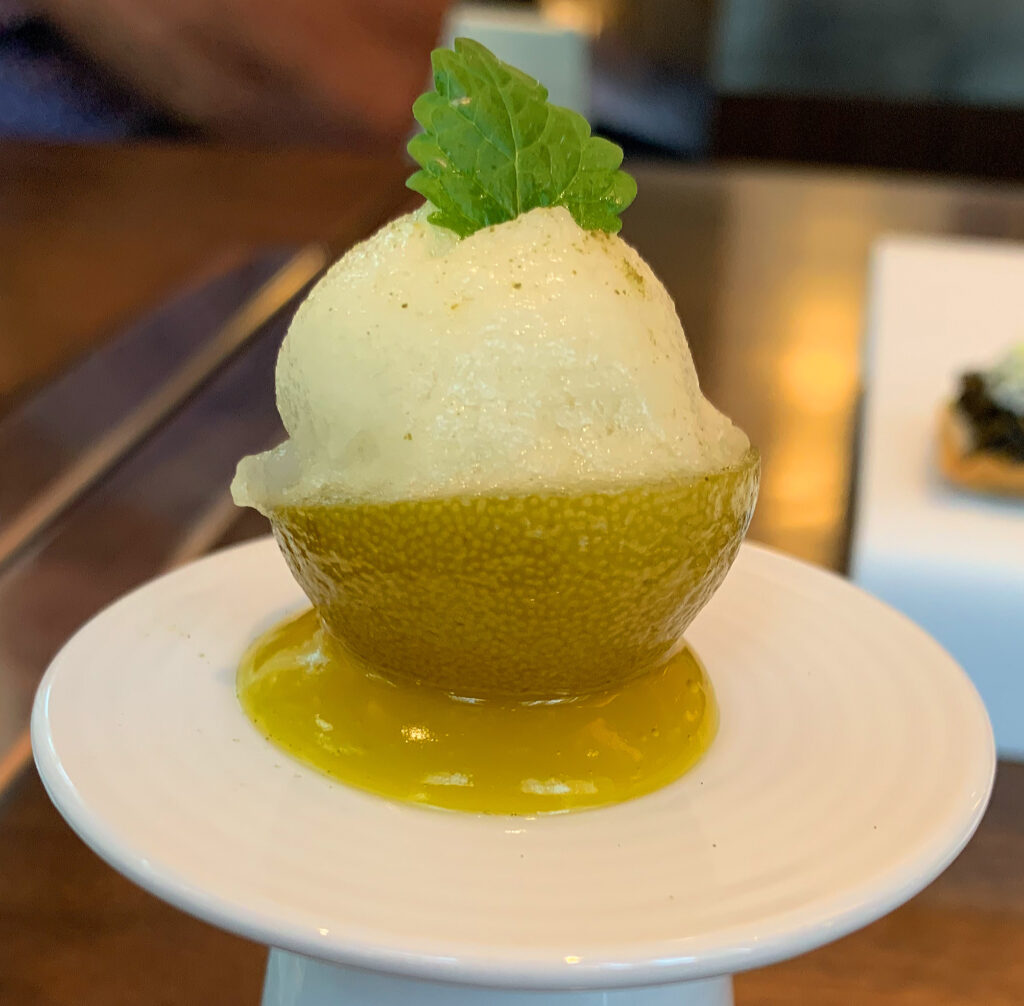
Finally, the “Mojito” bite tips its hat toward one of the chef’s classic creations that is typically served during the transition from savory to dessert. However, coming on the back of the “Rhubarb,” it actually works as the closing part of the “Canapés” assemblage. The preparation, in essence, is something like a frozen tart (rendered as though it was a halved segment of citrus) and blends the sweet-sour flavor of Key lime with a minty, rum-tinged mojito foam. This combination, which tickles your upper lip as it reaches your mouth, takes the tangy notes of the rhubarb soda one step further and totally cleanses the palate in anticipation of the first proper course set to come next. Moreover, it makes for a playful end to Jorge’s welcoming sequence that also hints at the range of influences guests can expect to see throughout the menu.
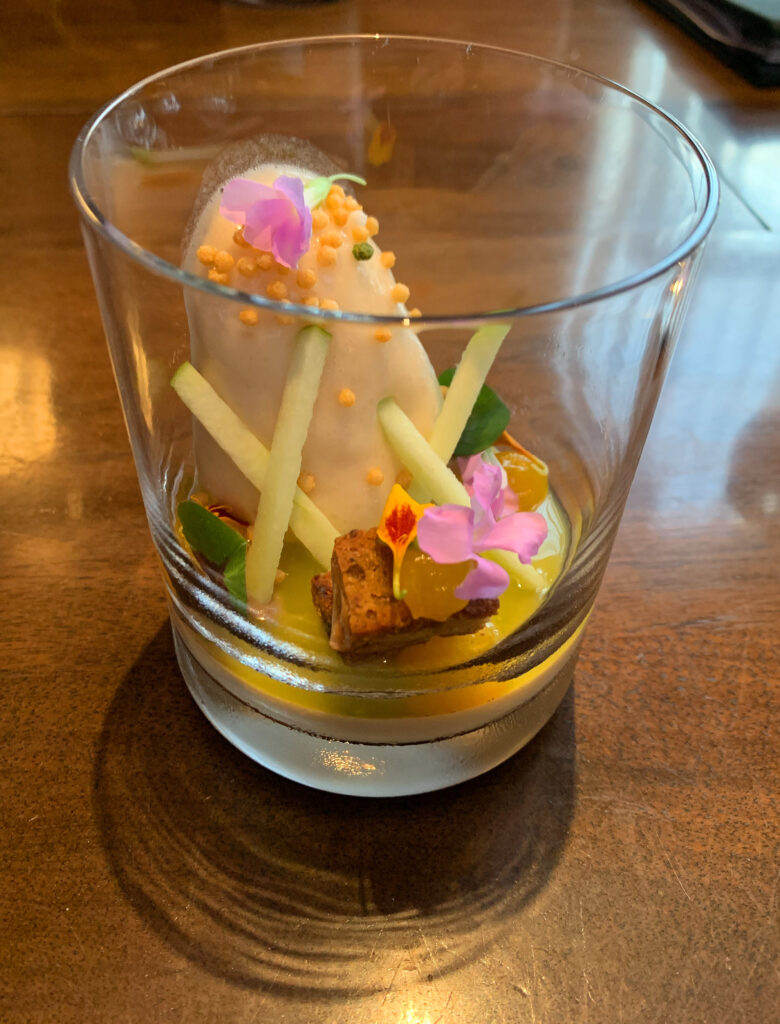
On the back of the wagyu-, uni-, and caviar-filled “Canapés,” Jorge has served a preparation of “Foie Gras” that brings yet one more totemic luxury ingredient to the forefront. This course also invokes one of Temporis’s favorite visual tropes—the “seasonal edible terrarium”—that has been seen throughout the chef’s tenure via dishes like “Peas & Carrots.” The presentation involves a simple glass tumbler that acts as the window into a diminutive world of apple slices, masago arare (crispy rice pearls), banana bread croutons, gooseberry sauce, herbs, and flowers set atop layers of apple miso and duck liver mousse. A scoop of Helles lager-flavored ice cream slouches against one end of the vessel like a snow-capped mountain, drawing your eyes upward and emphasizing the dainty quality of the other ingredients due to its scale.
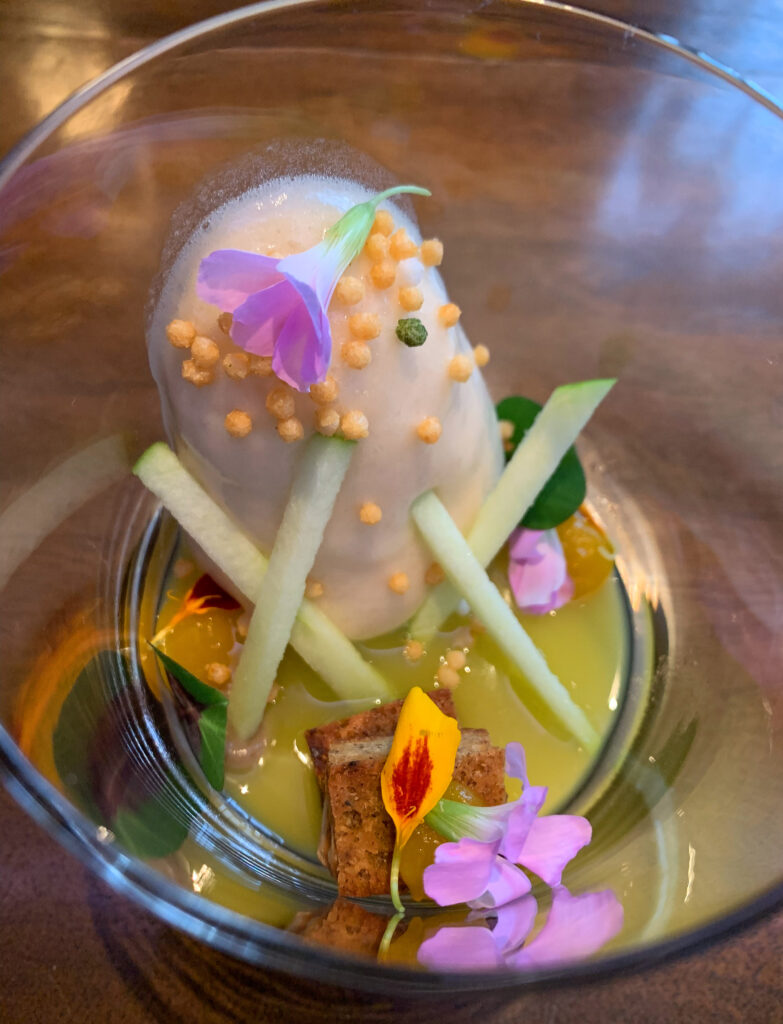
Feeling a bit like a giant monster, you plunge your spoon into this terrarium world and erase the sense of order the chef so carefully instilled. Smooth elements—like the foie gras mousse, apple miso, gooseberry globules, and ice cream—mix with the crunching apple slices and pearls of rice. Those cubes of banana bread, too, subvert the baked good’s usual identity as a dense, moist treat by shattering with all the might of a true savory crouton. From this textural hodgepodge, a vein of flavor emerges that is rich (from the duck liver), mildly sweet (from the fruit), subtly spiced (from the banana bread), and a tad bitter (from the lager). To your palate, the foie gras does not offer enough length or intensity to be memorable (something that the miso element, if more pronounced, might help with). However, this is a pretty and tactilely engaging dish that succeeds in blending a range of bold components in a manner that, even if they do not sing, will not offend diners who are hesitant about offal. You think this idea—and the more general “terrarium” form—shows potential.
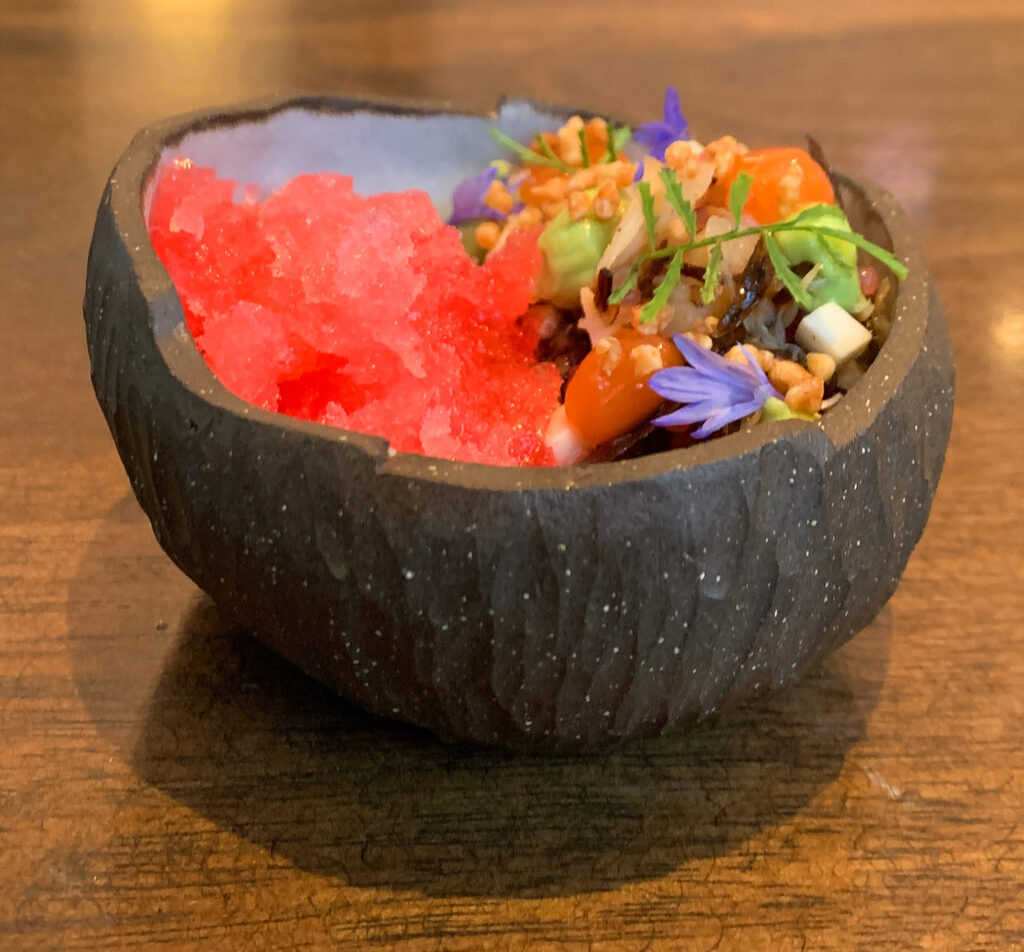
Alternatively, the “Canapés” have been followed by a preparation of “Dungeness Crab” that lacks some of the duck liver’s totemic pizzaz but still works to spoil guests with a serving of another prized ingredient. The crustacean, in this case, is rendered as fine shreds of meat that are interspersed among chunks of young coconut custard and dollops of avocado cream at one side of a small bowl. On the other side, you find a grapefruit granita that glistens in its vivid pink hue. A couple herbs, flowers, and bits of puffed rice form the finishing touches, lending an intricacy and delicacy to the presentation that is not unlike the preceding “terrarium.”
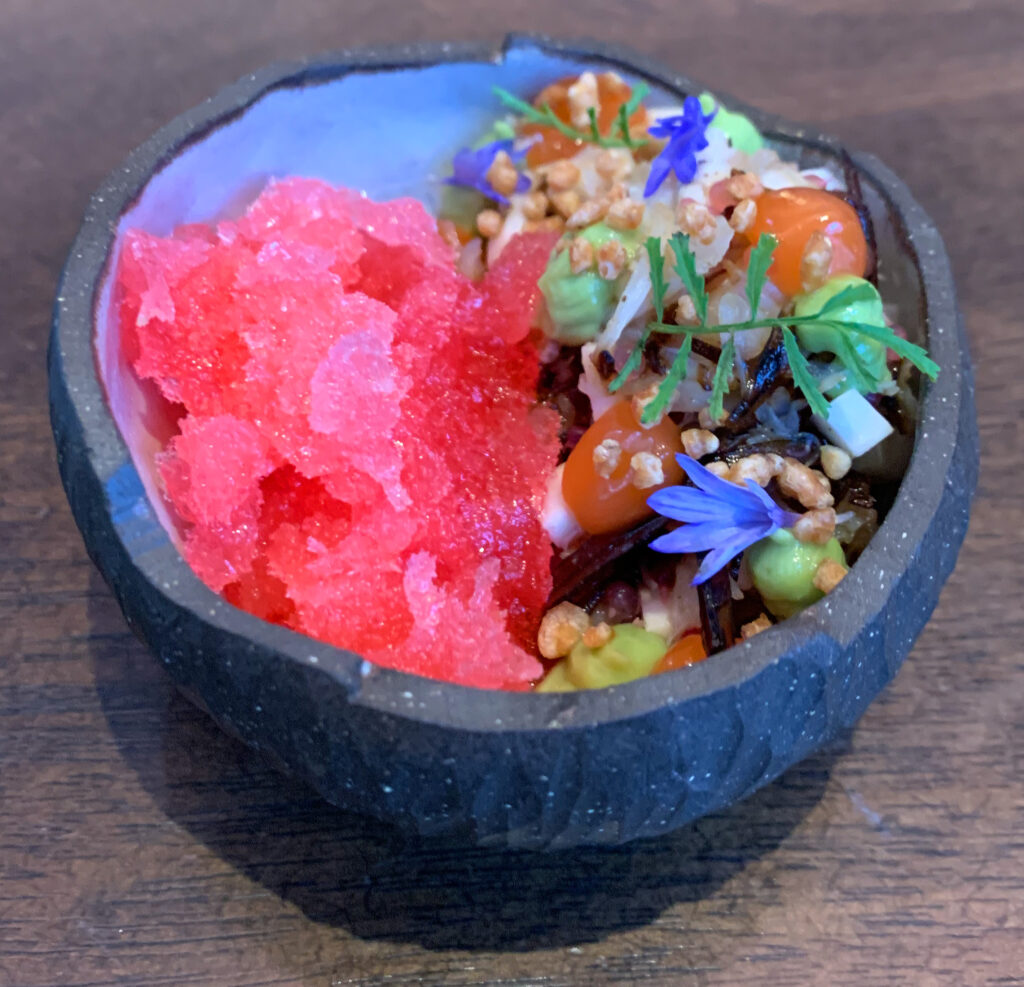
Approaching the dish, you marry the two sides of the bowl—the crab/coconut/avocado medley and the ice—on the surface of your spoon. Upon reaching your palate, the granita crunches, melts, and coats your tongue with a trace of tangy bitterness. The puffed rice seems to extend this textural sensation for a couple seconds before the weight of the creamy avocado and coconut custard takes hold. These elements cover your tongue concertedly, moderating the bitterness of the grapefruit while setting the stage for the shreds of crab to show themselves. The Dungeness’s meat is slight and somewhat hard to perceive at first but tender and sweet once you pick it out. Still, you think its delicacy gets damped because the brittle crystals of ice are disconcerting. The young coconut and avocado components, too, do not quite overcome the grapefruit when it comes to flavor. Thus, rather than a rich, tropical expression of crab (accentuated by citric tang), you are left with a boldly bitter, searingly acidic dish that fits more of a “palate cleanser” mold. Ultimately, you think the crustacean could be utilized more effectively, but the preparation at least remains intriguing on account of its varied textures and colors.
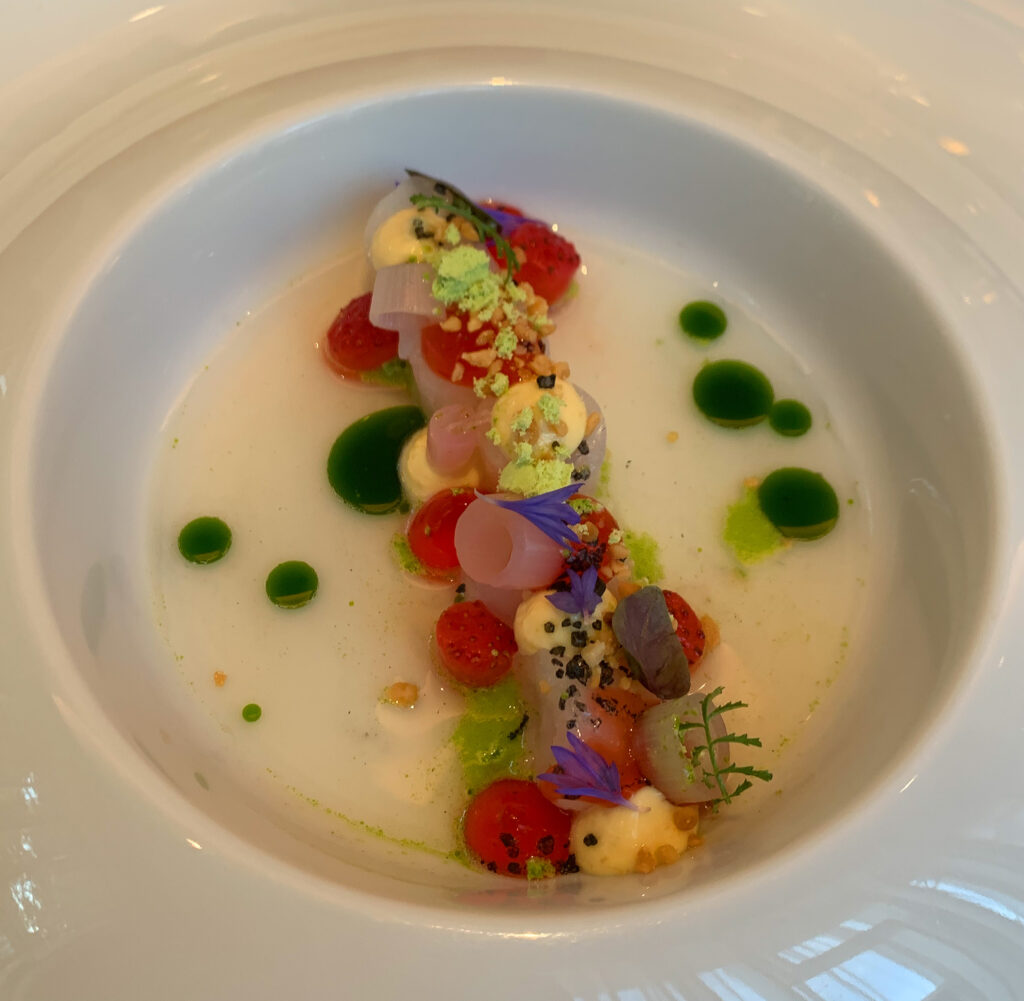
Moving on from the meal’s more fleeting openers, Jorge’s “Fluke”—served across all of your visits (having first appeared in 2019)—represents a more substantial study of a single ingredient. The fish in question, known under the umbrella term hirame when it appears in the omakase genre, is actually a kind of flounder. Its firm texture and mild flavor make it an ideal canvas on which to demonstrate both a mastery of technique and a singular sort of creativity. To begin, the chef slices the raw fluke’s flesh and shapes the resulting pieces into a series of curls that run down the center of a shallow bowl. These ribbons of fish are moistened by a shallow pool of carbonated lime juice before being joined by segments of compressed strawberry and preserved ramps. The finishing touches come by way of a dusting of basil powder, a sprinkle of black lava salt, and Marcona almonds—rendered both as a crumble and as dollops of aioli.
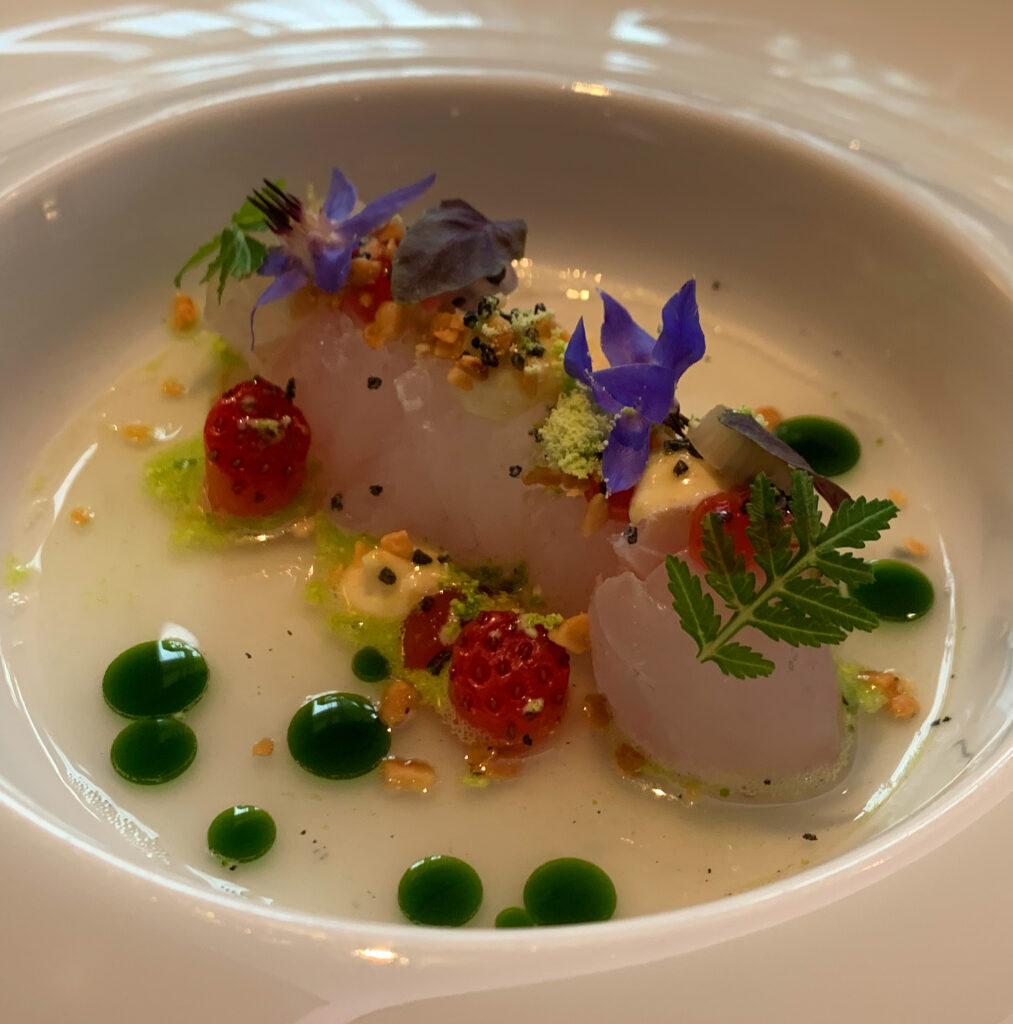
Using your spoon, it is easy to pluck a piece of fish out of the lineup and transport it onto your palate with each of its accompaniments in tow. When the fluke meets your teeth, you are struck by its soft, almost gummy quality that quickly yields to tenderness as the flesh spreads out across your tongue. With further chewing, the bursting fragments of strawberry and crunching rounds ramp make themselves known, as do the finer grains of the salt and almond. Nonetheless, the aioli does a good job of coating the fluke, enhancing its sense of richness, and acting as a buffer against these contrasting elements (something you felt was missing from the “Dungeness Crab”). On that note, while this dish features the same driving acid seen in Jorge’s other recipes (along with some tingly carbonation to boot), here it is adeptly balanced by salty, fruity, and nutty layers that dampen the tang. In doing so, they construct a degree of savory intensity that, combined with the pristine texture of the fish, you find highly appealing. Overall, this dish ranks favorably against the city’s best crudos and reflects, perhaps more than any other course thus far, Jorge’s style of cooking at its most effective. A subsequent version of the preparation, substituting the fluke for turbot, has been even more impressive!
After so many successive servings of seafood (along with other totemic luxury ingredients like wagyu and foie gras), it comes time for some expression of produce. Of course, you are not complaining, for what diner wouldn’t find caviar, uni, razor clam, and sashimi to be a stellar starting lineup (at least on paper)? Rather, seasonal fruits and vegetables allow Temporis to engage with that idea of “the passage of time” in a way that goes beyond ephemeral microgreens. They allow the kitchen to more clearly express itself and transform the natural bounty in a manner that is more inventive than what might be seen with pristine protein from land or sea.
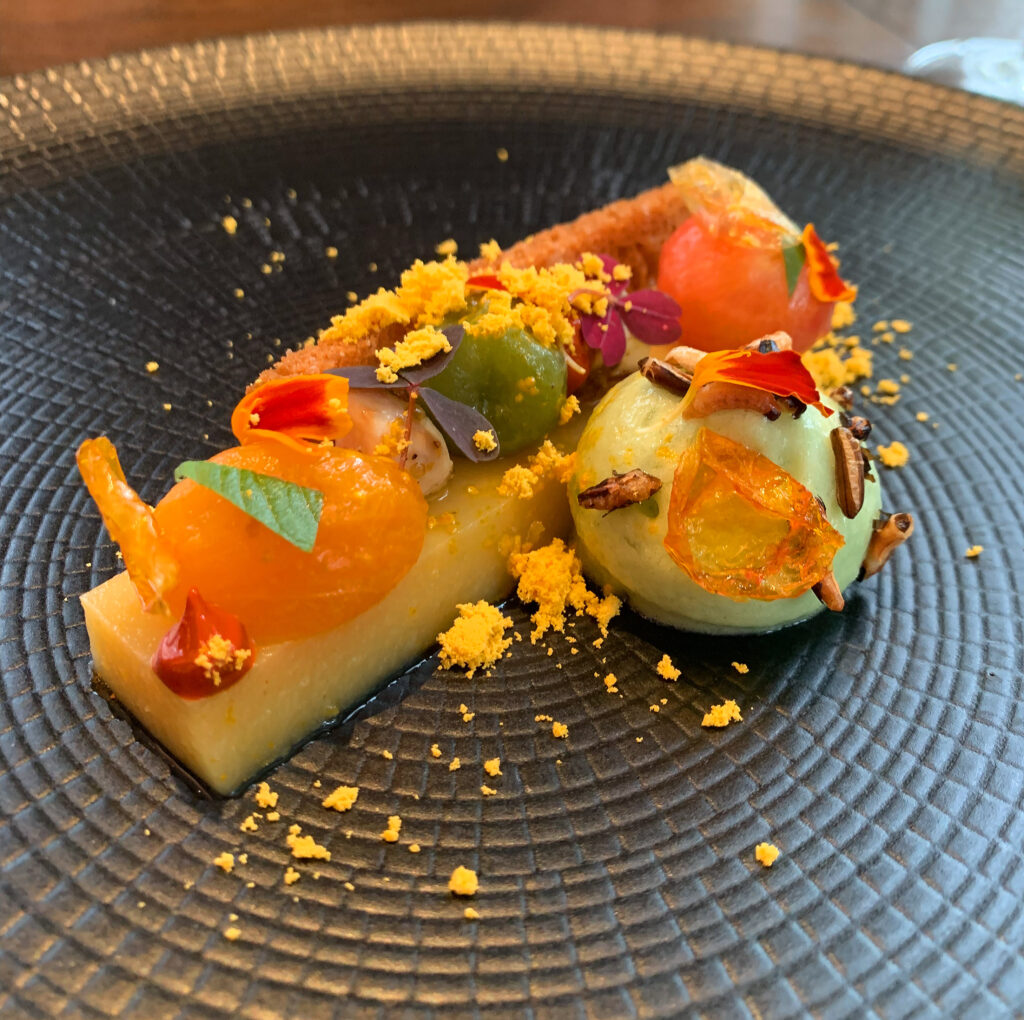
“Tomato,” as the next course is titled, transforms its star ingredient in two principal ways. Jorge uses golden tomatoes to make a rectangular slab of custard—the centerpiece of the plate—that is then topped with halved segments of cherry tomato that have been pickled or carbonated (alternatingly). Some crispy tomato skins and clumps of tomato powder are also thrown in the mix, along with small chunks of smoked mozzarella and bits of puffed wild rice. However, the custard is primarily contrasted by a long piece of crispy brioche and a dollop of cucumber foam that flank it on either side.
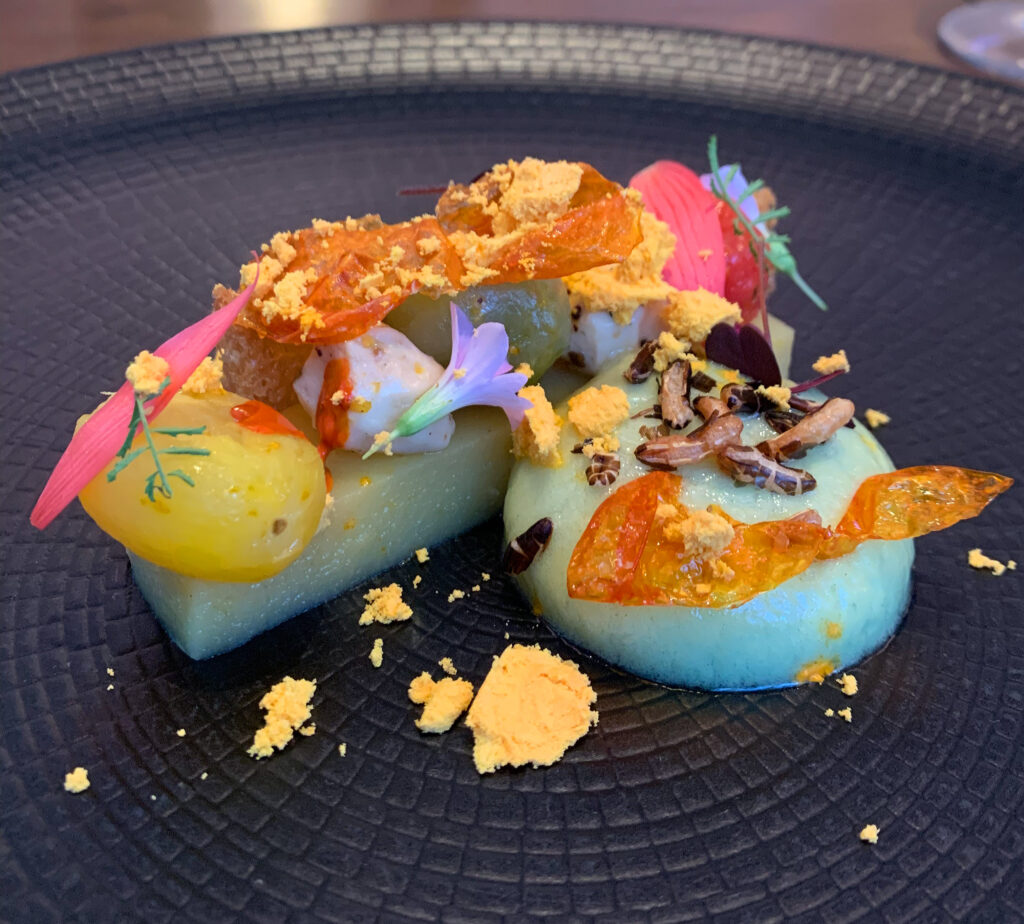
Diving in, the dish displays a dramatic textural contrast, with the creamy tomato custard and frothy cucumber foam being offset by the bursting (and a bit prickly) pickled/carbonated tomatoes, chewy mozzarella, and crispy layers of tomato skin, puffed rice, and brioche. These varied ingredients engage your palate like a good salad would. However, the preparation’s ultimate flavor profile is reminiscent more of a gazpacho. The tomato custard, carbonated segments, and skins build toward a deep, beautiful sweetness—tinged with acid—that combines with the cleansing cucumber. While the milky, smoky qualities of the mozzarella are a bit understated, the brioche and wild rice elements offer a rich, earthy character that grounds the dish on the savory side. In sum, this is a nice (if not totally electrifying) course that honors its star ingredient in an inventive way. You would perhaps like the dish to emphasize the ripeness of the tomatoes a bit more (and their accompanying tang a bit less), yet the preparation remains true to Jorge’s style.
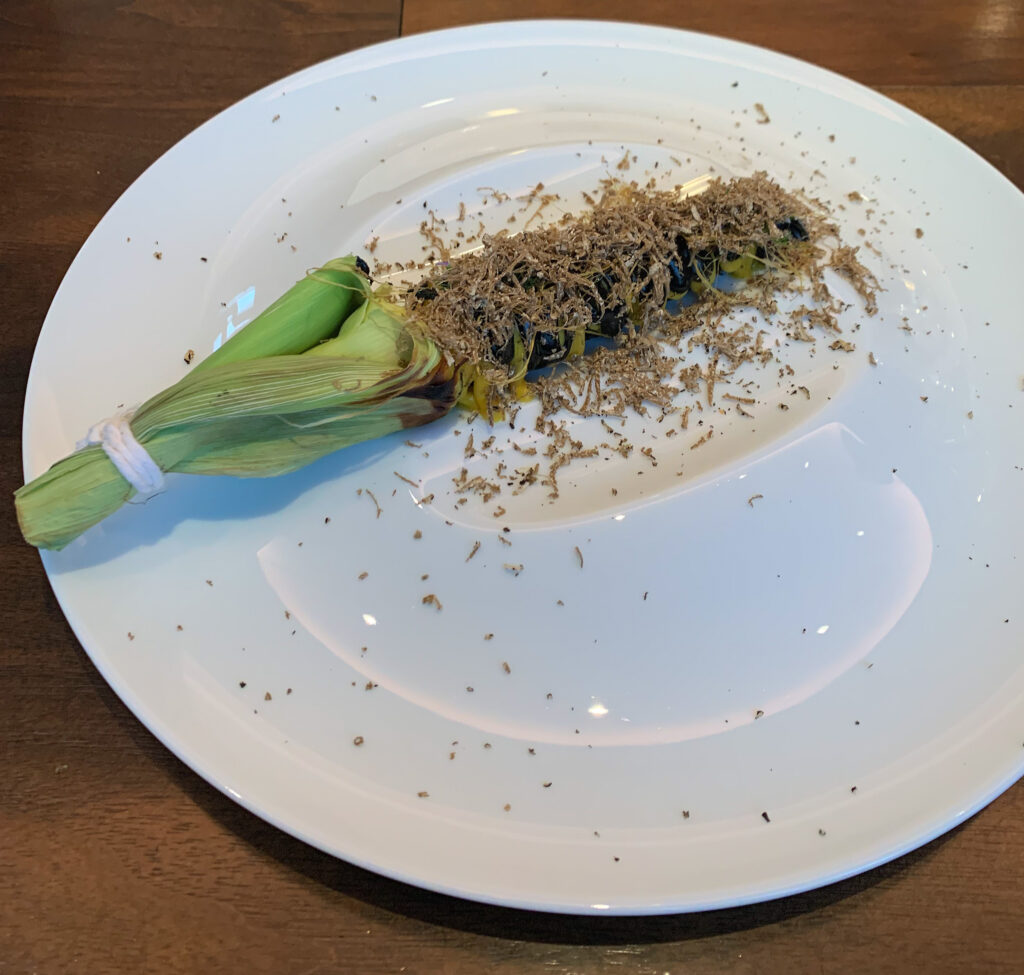
Moving on, the “Corn” follows in much the same fashion as the “Tomato,” representing a worshipful rendition of a singular piece of produce that is meant to emphasize the restaurant’s dedication to seasonal cooking. However, while the preceding course (and most of the food served thus far) indulges in “modernist” custards and foams, its successor aims squarely at pleasure in a way that has surprised you. This sense of restraint—vis-à-vis the techniques that mark Temporis as a “contemporary American” concept—is noteworthy, for it affirms the kitchen is not bound by a particular style but can easily pivot toward something that is comparably simple and timeless.
The preparation, which the chef first served (in some form) back in 2019, centers on a piece of baby corn (sourced from Kankakee’s Three Sisters Garden) that is cooked in its husk. Jorge peels the husk back, leaving it attached, and coats the exposed kernels with alternating ribbons of cream made from Espelette pepper and black truffle. A bit of parmesan is then grated on top before the dish is transported to the table and finished, by the chef, with a shaving of fresh Italian summer truffles. Jorge leaves you with instructions to pick the cob up by the end and go to town, revealing that the husk—in this case—is actually edible (and not by any means unpleasant you can report).
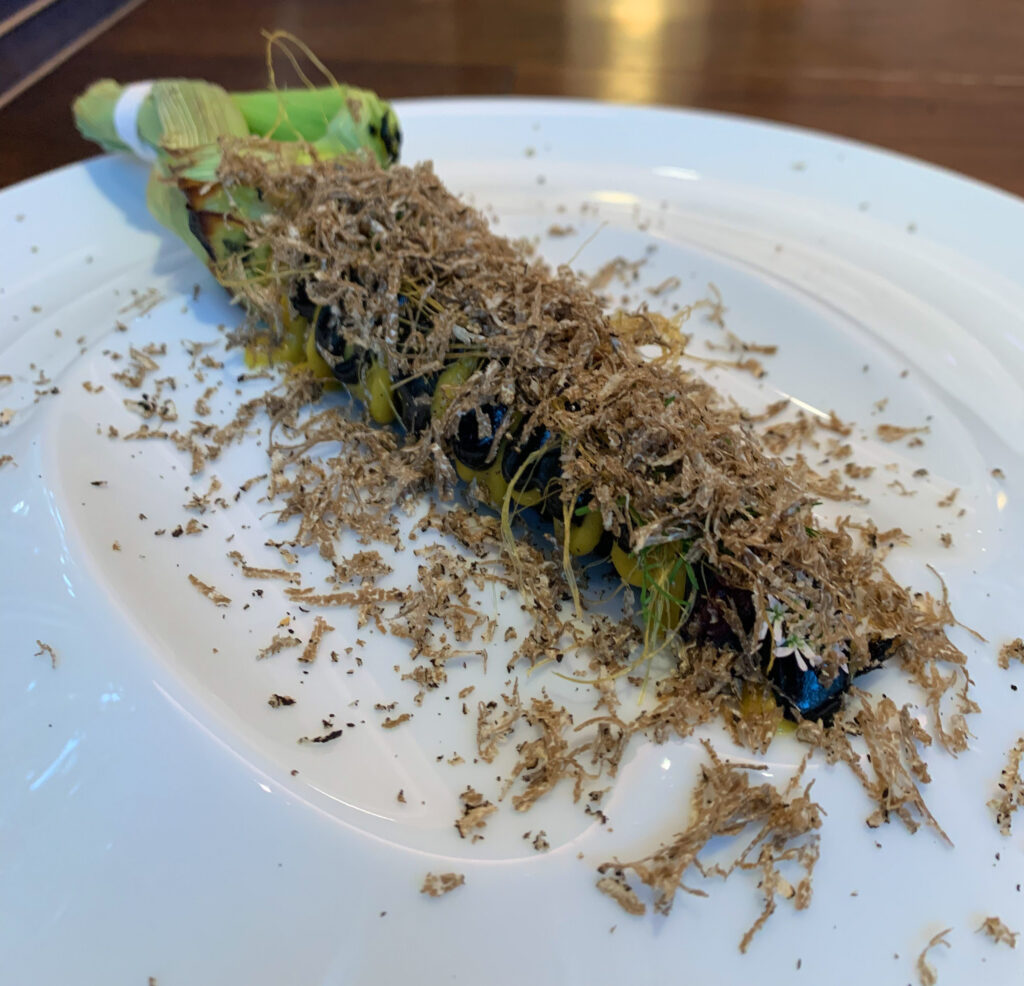
When it meets your teeth, the baby corn is satisfyingly crunchy. On their own, the kernels are only subtly sweet and earthy. They almost make you think, for a moment, “is that it?” Yet, with further bites, a deeply savory quality comes to the fore. It combines the smoky-sweet Espelette, the pure umami of the parmesan, and the mushroom notes of the truffle (smartly expressed via both the aromatic shavings and the more concentrated cream). No one of these flavors wins out or overshadows the others. Instead, their intensity is subsumed into the baby corn, extending and enhancing its latent character—revealing an untold dimension of depth—through a lasting finish. Overall, this is a simply superlative course that reveals, beyond all the special effects, just how masterfully Jorge can draw upon nostalgia (in this case, elotes) to conjure pure, precisely pleasing flavor. This preparation would shine as part of any tasting menu in town—even at the tippy top of Bibendum’s list—and is just the kind of bite that makes you dream of coming back to Temporis for another round. Bravo!
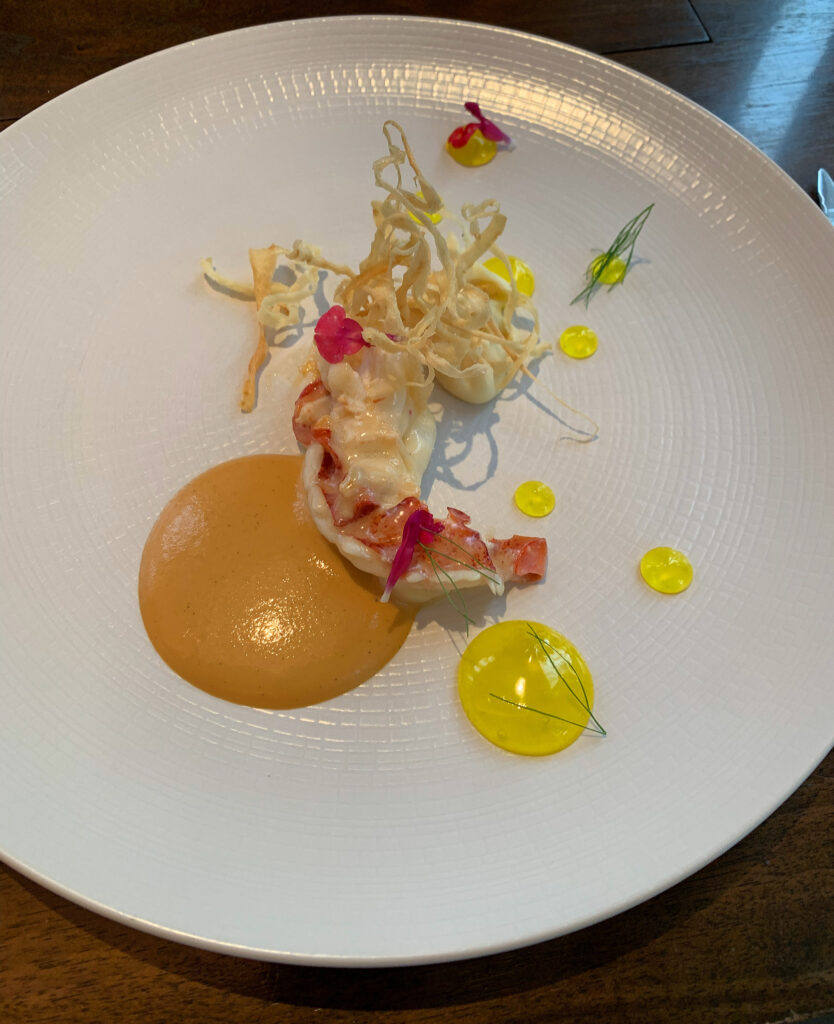
Coming on the back of a couple inventive preparations of produce, Jorge’s next course, once more, showcases seafood. In fact, with ingredients like uni, caviar, razor clam, crab, and fluke already being utilized throughout the menu, the chef may have saved the most totemic item for last. “Lobster,” though considered nothing more than “a cheap source of protein” in the 1800s, still commands a particularly luxurious reputation today. Compared to various types of roe and slimy mollusk, which are arguably more prized by experienced gastronomes, this crustacean promises a plump, meaty texture and buttery-sweet flavor with broad appeal. Temporis, to its credit, embraces this kind of easy pleasure, serving a sizable half of poached lobster tail with nothing more than a tangle of crispy parsnip, a vanilla-lobster reduction, a parsnip cream, and some globules of a gelatinous Pernod-spiked gastrique.
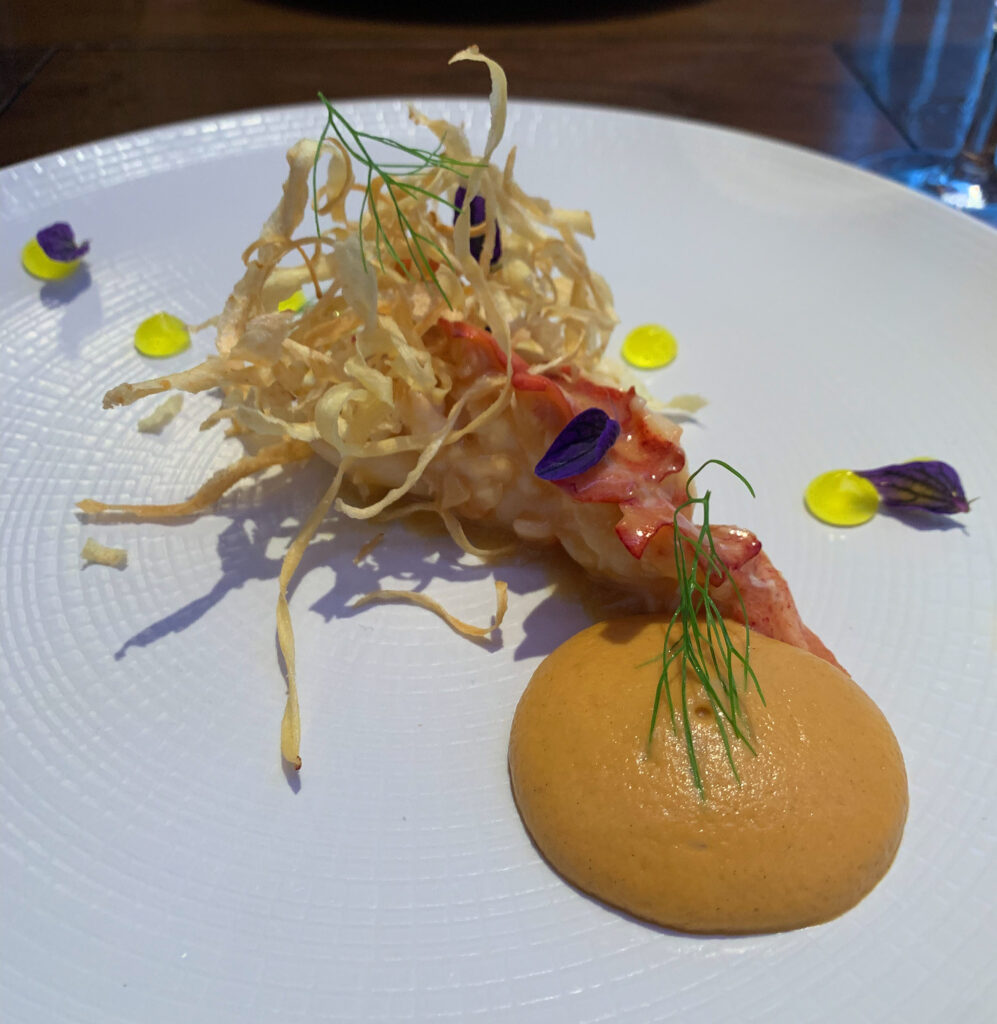
Attacking the meat with fork and knife, you are impressed by the ease with which it breaks apart. On the palate, the crustacean displays a fleeting firmness that yields to a soft, succulent mouthfeel. “Fair enough,” you might think, “the Michelin-starred restaurant can properly poach lobster.” However, when you drag the tail through the accompanying reduction (rendered supremely airy through the use of nitrous oxide), it is blanketed by a warm, rich sensation that calls bisque to mind. The intensity of crustaceous flavor here is maddeningly delicious, and the parsnip cream, too (when incorporated), amplifies the lobster’s latent sweetness and complements it with a delectable nutty quality. Likewise, those crispy pieces of parsnip, beyond contrasting the tender meat, provide their own harmonizing caramelized undertones. Yet, it is the perfectly judged use of vanilla and anise that really makes the dish sing. While not totally novel, these flavors cut through the decadence of the lobster-parsnip combination and mark the preparation with a transfixing licorice finish. In doing so, they do not detract from the sense of luxury but, rather, provide it with greater depth and definition.
Like the “Corn,” the “Lobster” succeeds in spoiling guests with a superlative (and still moderately creative) version of an ingredient they recognize. The dish also, once more, demonstrates Jorge’s capacity for restraint in pursuit of flavors that guests, whether new to fine dining or well-versed, are sure to enjoy. This course, reflecting this kind of generosity, would impress as part of any tasting menu in the city. Well done.
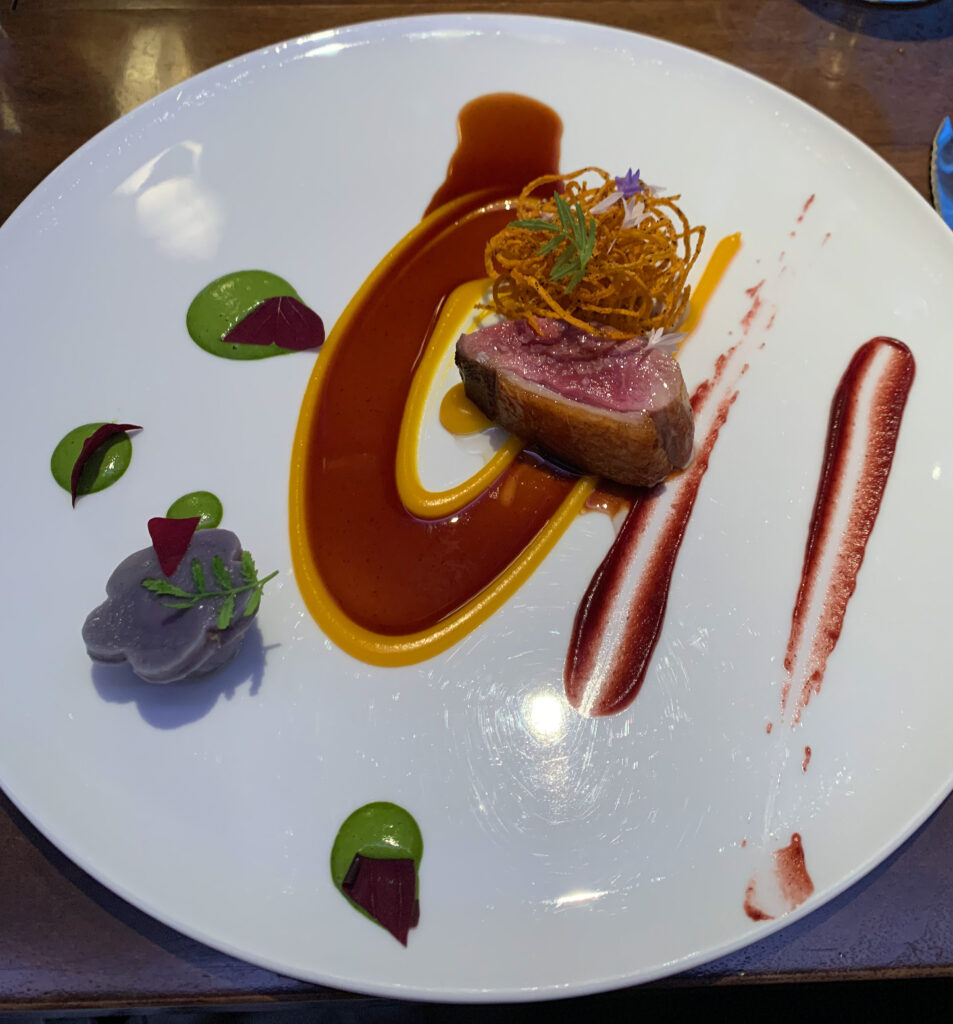
Turning, at long last, toward the animal kingdom, you have first encountered a preparation of “Duck Breast.” Though the portion here is not quite as impressive as the preceding “Lobster,” this dish only represents the first of two meat courses that form the final savory portion of the meal. Plus, the bird’s breast still impresses with its golden-brown crust, blushing rare interior, and finishing sprinkle of flaky salt. The meat is joined by a tangle of crispy onions (not unlike what was done with the parsnip in all honesty) and surrounded by swirls (as well as splatters) of sauce made from puréed chestnut, buddha’s hand, and cranberry. Off to one side, a flower-shaped dumpling filled with duck confit also sits as a final touch.
At a visual level, this course clearly reflects Jorge’s love of abstract art and speaks (perhaps somewhat stereotypically) to the painterly style of molecular gastronomy that still features so prominently in creations like Alinea’s “Table Dessert.” Still, there are really not that many restaurants in Chicago designing plates in this fashion, so you think the presentation retains a sense of novelty and charm.
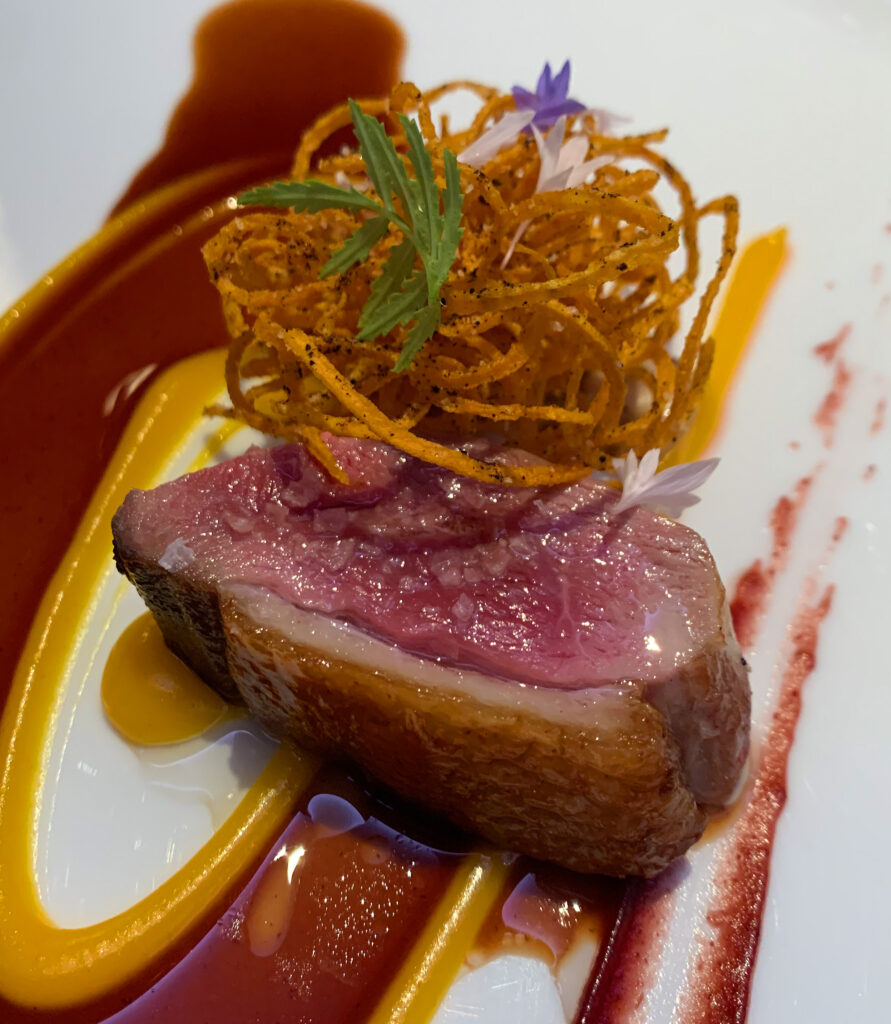
When it reaches your palate, the duck’s skin displays a pleasing crispness (matched by that thicket of onions) and a skillful rendering of its subcutaneous fat. This latter quality ensures that the transition from brittle exterior to chewy, juicy interior is effortless. The sprinkling of salt ensures the bird’s rich, subtly gamey flavor is accentuated, and these carnal notes are further emphasized by the chestnut purée. In contrast, the citric buddha’s hand and sweet-sour cranberry display a cleansing character that invites you to take another bite. The dumpling, too, is a nice surprise. Its wrapper is pleasantly chewy, and the bit of confited meat tucked inside strikes you with even more intensity than the breast itself. Ultimately, this is a fairly traditional take on the combination of duck and fruit embellished with some eye-catching plating. It is a good, technically sound dish that offers pleasure without quite taking any big risks.
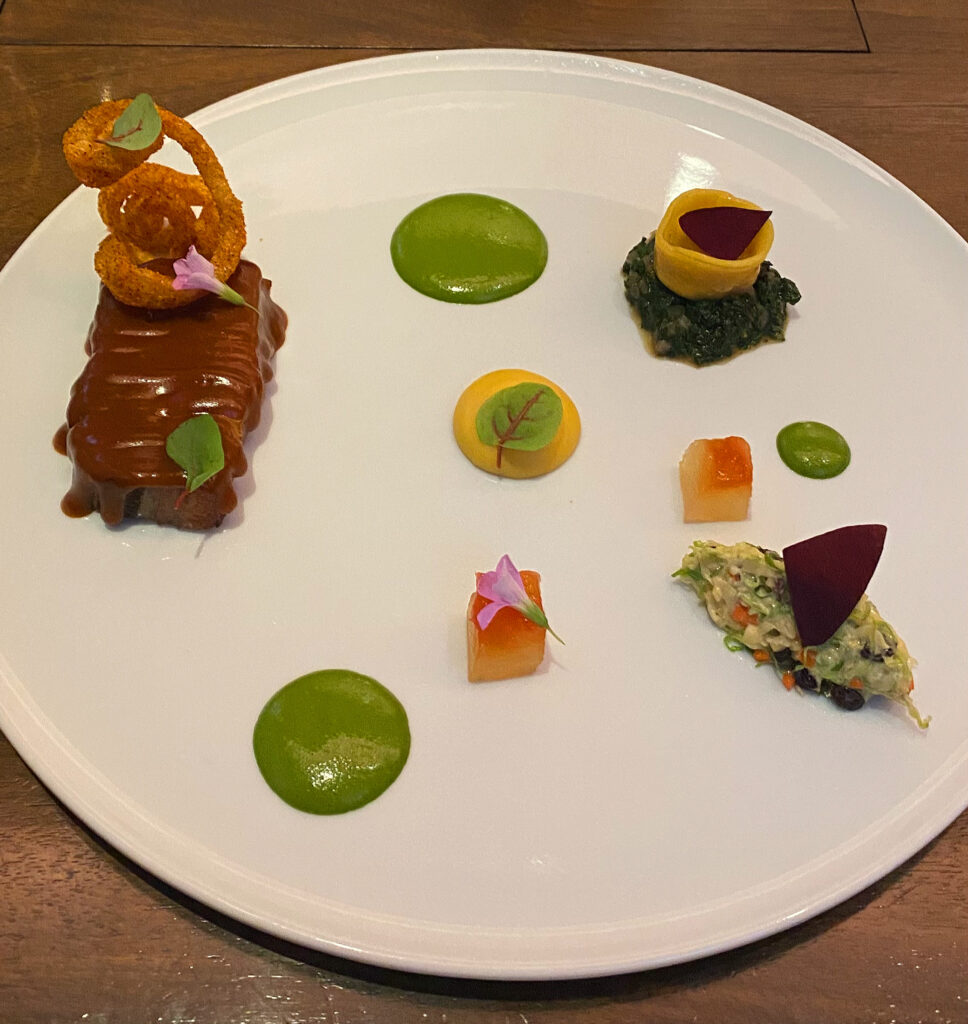
Nonetheless, if the “Duck Breast” is a bit tame, its successor brings the fireworks. “Iberico,” as the course is titled, is described as an “ode to American barbecue.” The preparation highlights a cut of the prized black-hoofed pig’s loin that has been marinated in Dr. Pepper for three days, slowly cooked, coated in a sticky sauce, and topped with a curled, spring-like chicharrón. In the very center of the plate, sits a dollop of cornbread mousse that is flanked by dots of sorrel sauce (in alternating sizes) and a couple pieces of pickled watermelon rind. Off to the other side of the canvas, you find a coleslaw made from brussels sprouts and, across from that, a mac and cheese flavored tortellono, under which can be found a play on collard greens made from Swiss chard.
On paper, this course sounds like an absolute feast; however, Jorge executes the barbecued meat and its sides with his typical precision and artistry. The ibérico itself is melt-in-your-mouth tender (nicely contrasted by the airily crisp chicharrón) with a deeply nutty, porky character buttressed by the soda marinade’s 23 flavor. The loin’s accompanying sauce is done in a Carolina style—being powerfully tangy and a bit spicy—with just a little sweetness and a finish that lasts more than a minute. The resulting combination is among the most hedonistic you have ever encountered in a tasting menu format, and the dish would be a rousing success based on these elements alone. However, the sour sorrel, cleansing chunks of watermelon rind, and creamy brussels sprout slaw each offer alleviating notes that help renew you appreciation of the meat. Likewise, the cornbread mousse, cheesy stuffed pasta, and moist mound of chard add to a sense of richness via varied earthy and milky tones. None of these accompaniments particularly outshines the others, but they make the plate more engaging and deepen your appreciation for the starring cut of pork. By combining nostalgia, technique, and unabashed decadence, Jorge’s “Iberico” is quite simply a triumph.
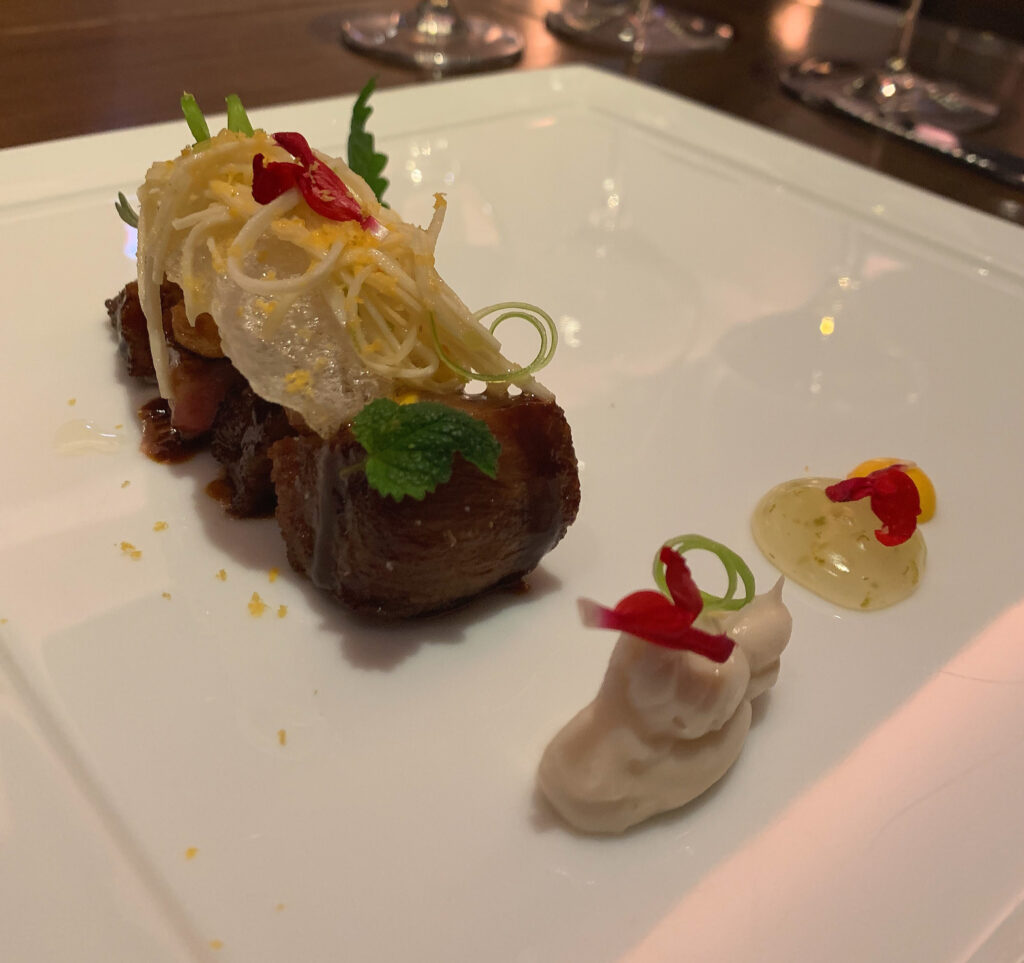
The final savory course of the evening draws on one of fine dining’s favorite tropes: the ubiquitous A5 wagyu beef. Given the increasing proliferation of American “wagyu,” a term that guarantees nothing (but can, from scrupulous purveyors, denote cows of pure genetic stock), you suppose you prize that “A5” rating (which suggests Japanese sourcing). And, despite always complaining about how this totemic luxury ingredient saps chef’s creativity, you respect Jorge for utilizing “A5 Wagyu Ribeye” rather than deferring to the same cut of striploin as everyone else.
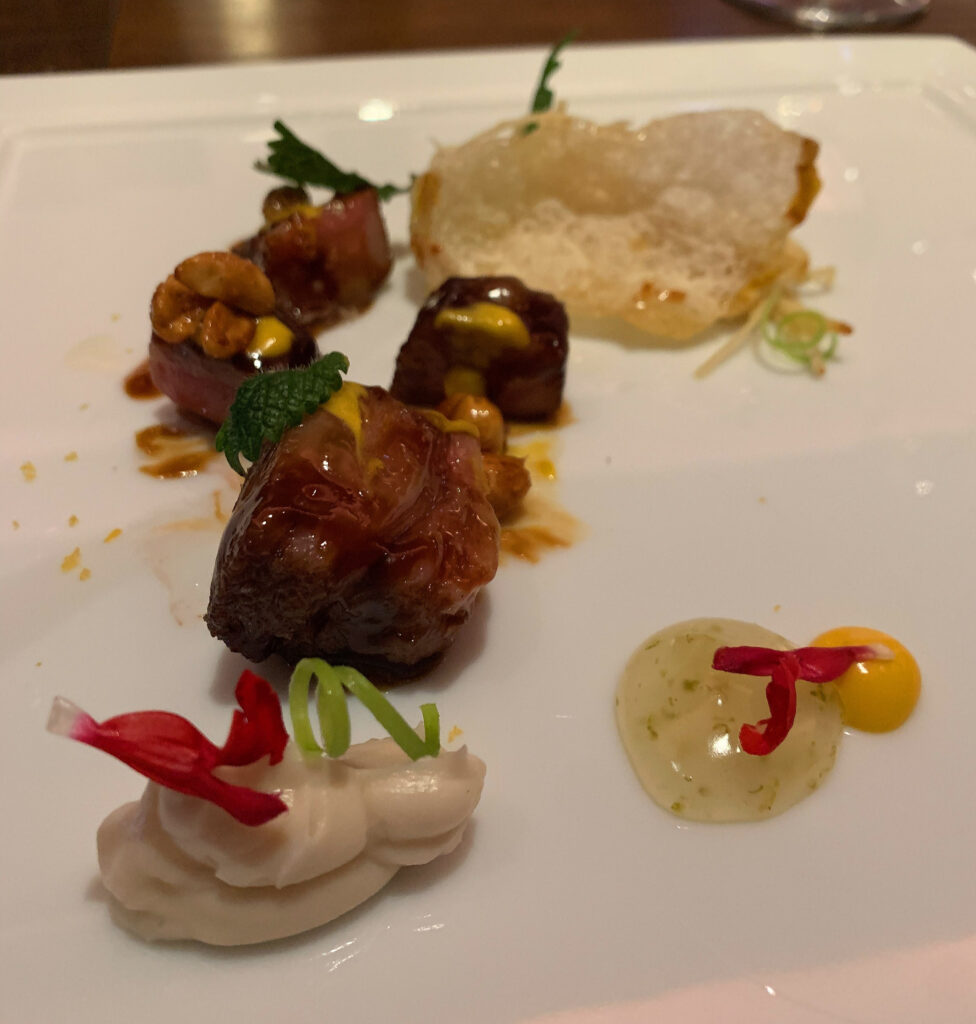
For this course, the beef—rendered as a quartet of rectangular chunks—is garnished with a reduction of satsuma (a kind of mandarin) and a handful of caramelized peanuts. It is then hidden under a puffed piece of wagyu tendon with some shredded hearts of palm cascading across the top. Off to the side, you find a jackfruit marmalade interlaced with the peel of sudachi (a more aromatic relative of lime) along with a dollop of coconut curry. The whole combination is meant to call pad thai to mind, yet it also (especially that puffed tendon) seems straight out of the Grace/Ever playbook.
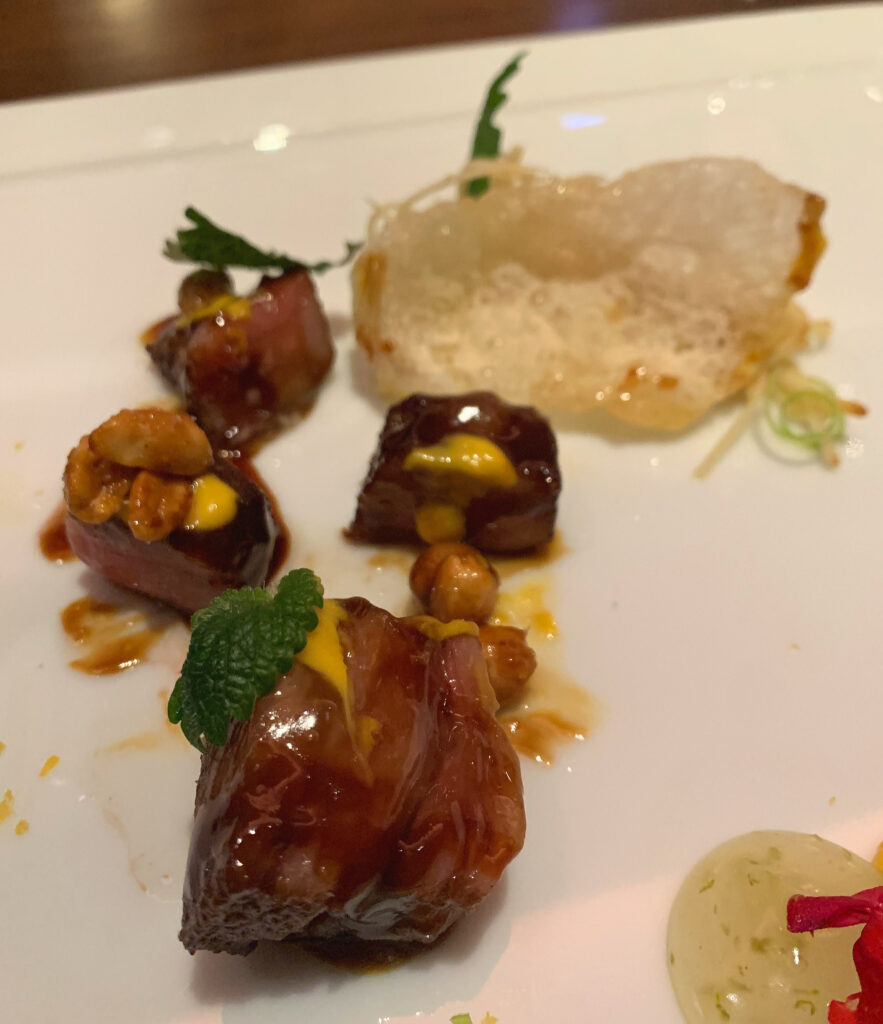
Upon reaching your palate, the ribeye offers the slightest sense of chew then displays all the melting, unctuous character you expect from wagyu beef. Yet, there is a nice caramelization to its exterior that joins with the peanut topping to make for a pronounced savory flavor (something that can often go missing when chefs treat this prized meat with kid gloves). From this base, the piece of tendon and hearts of palm provide a crunching contrast. Their flavor, otherwise, is mild and serves mostly to extend the pleasure of the meat without obscuring it. Instead, the more dramatic effect comes by way of the satsuma, coconut curry, jackfruit, and sudachi—a medley of citrus and tropical fruit that sweetens your perception of the wagyu’s fat (and cuts its richness) without totally cleansing your palate. Ultimately, you think the reference to pad thai is sound, but this course really succeeds by marrying the ribeye’s beautiful, gushing texture with pronounced nutty-sweet notes that ensure the beef actually tastes of something. To that point, the puffed tendon and shredded heart of palm seem a bit superfluous: a kind of camouflage or filler relative to the real star. Still, this is a better-than-usual take on a familiar luxury ingredient that will please newbies and cynics alike.
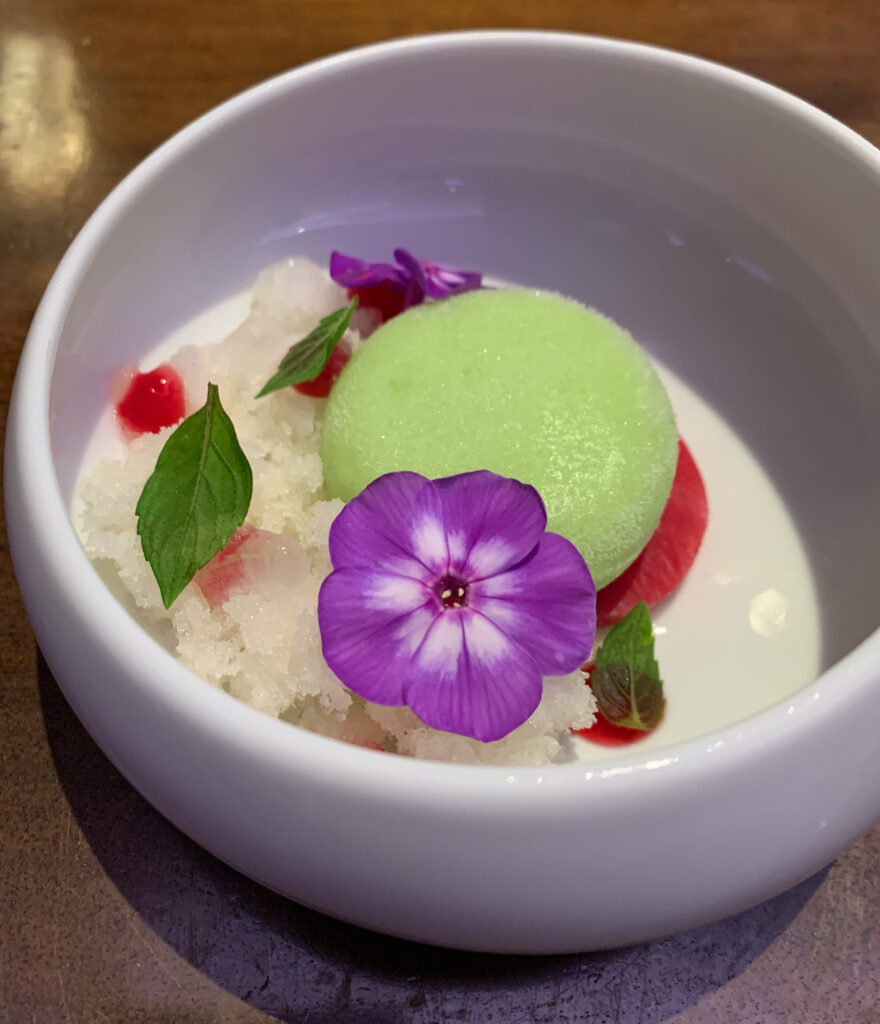
With that, the savory portion of the tasting menu comes to its close, and diners are placed firmly in the hands of Paternico, Temporis’s pastry chef. To mark the transition toward the sweeter side of the meal, she begins with a preparation of “Cactus.” Yes, the spiny plant is transformed into a palate cleanser by way of a sorbet made from its pads and a gelée made from the prickly pear fruit. These are joined by an accompanying granita flavored with aloe and mint, along with a couple leaves and flowers.
Diving in, you first appreciate the dish’s visual appeal: tones of pale green and deep red offset by the colorless granita and the odd burst of purple petals. Texturally, you find the gelée to be a bit stiff but both of the frozen components to be impressively soft. As the various elements combine in your mouth, the bracingly tart flavor of the cactus pads yields to the full, almost melon-like quality of the prickly pear with a closing cooling note drawn from the mint. Overall, you like the persistence of the fruit here (especially when you consider how bright and tangy Jorge’s savory creations can already be) and enjoy seeing these more obscure ingredients utilized. The course does its job of cleansing and readying your palate for what’s to come even if it does not quite rise to the level of being memorable.
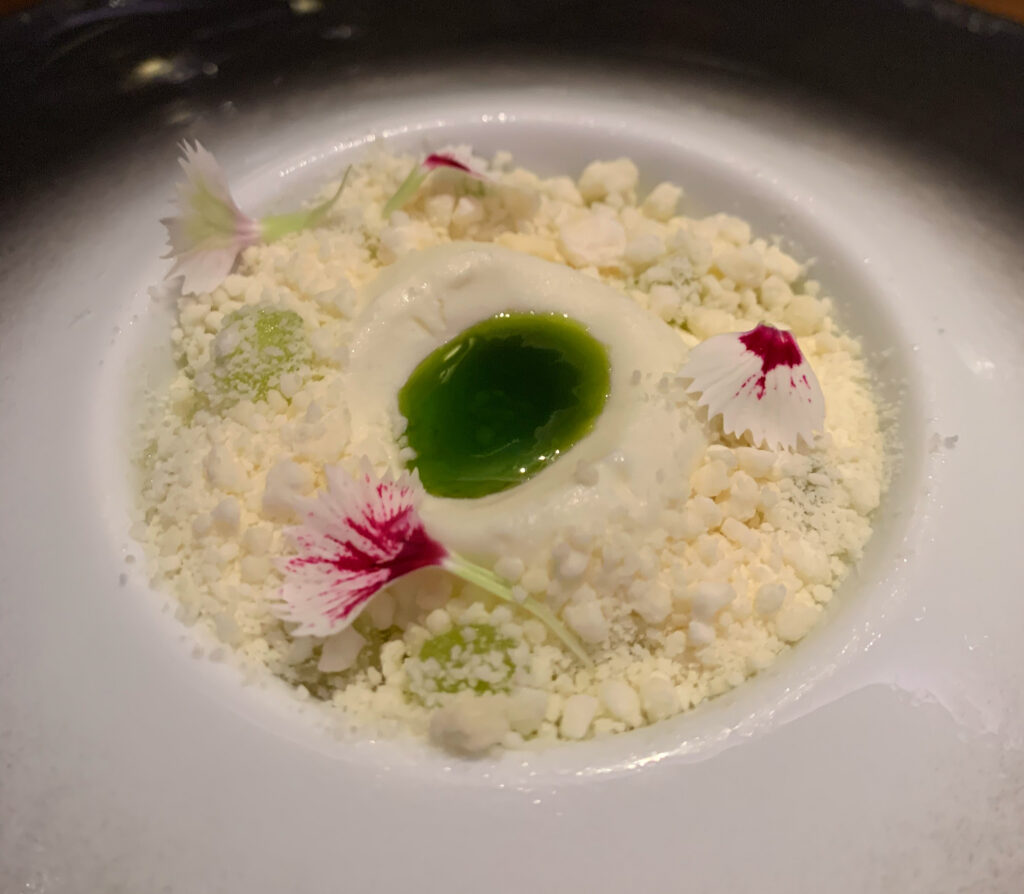
Next, Paternico serves a dessert that centers more conventionally on “Apple.” The fruit is rendered, once more, as a kind of granita that, in this case, boasts a particularly high concentration of flavor and color. This component coats the bottom and sides of the bowl, which is then topped with a scoop of crème fraiche ice cream into which has been poured a reservoir of dill oil. White chocolate, in the form of small pebbles and granules interlaced among the granita, provides the finishing touch.
At face value, this course almost seems to be aiming for the same effect as the “Cactus.” Visually, it looks like it could be a part of the tasting menu at Elske or Smyth. However, first impressions aside, the “Apple” is a stunner. The dish blends a variety of creamy and melting textures together without any trace of crunching ice crystals. No, the components combine on your palate with ease, coating it with a pleasing weight and richness. They then impart a flavor that starts out sweet and sour but veers toward a buttery, anisey finish. With each subsequent bite, the sensation deepens: all of these notes are in perfect balance, and they drive each other toward ever greater intensity until the bowl, now emptied, leaves you to ponder what feels like a never-ending finish. Ultimately, this is not only the menu’s best dessert but—despite drawing on ingredients that you do not find particularly decadent—one of the best desserts in the city. It represents a great achievement for the pastry chef.
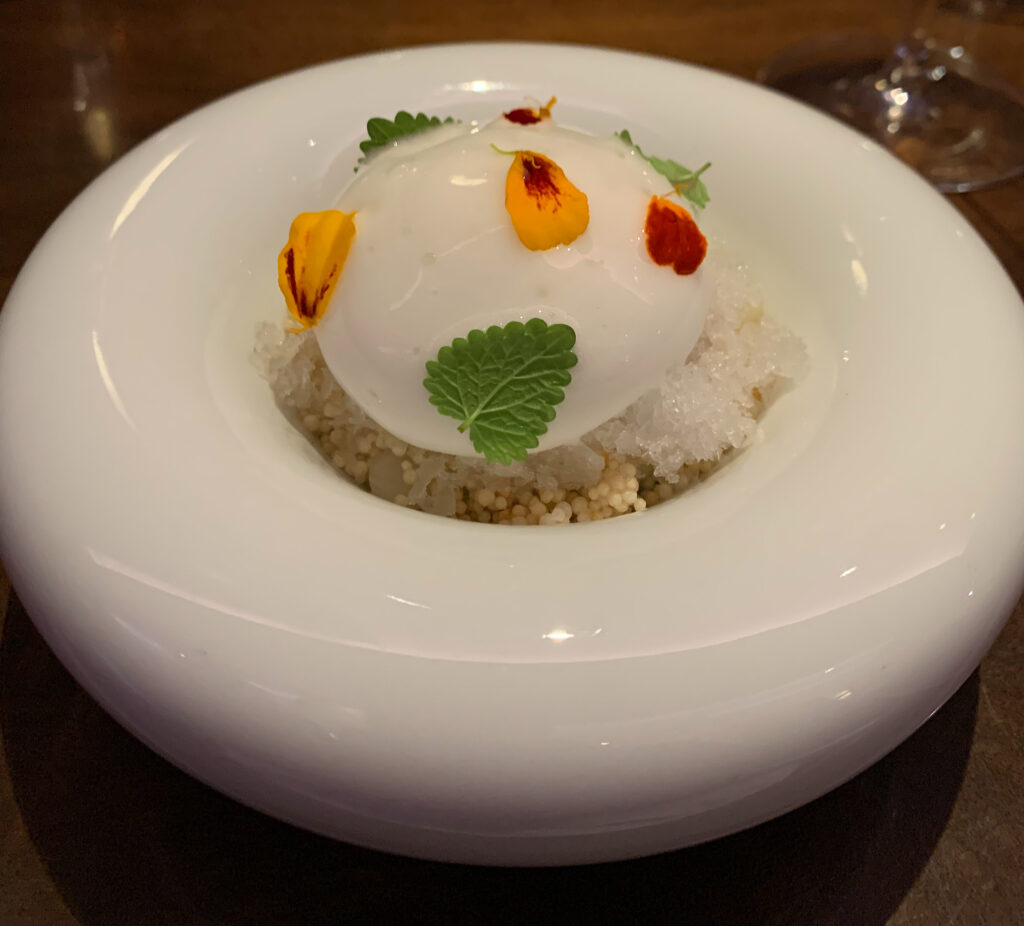
Nearly as impressive as the “Apple” is the “Nori,” yet another frozen dessert (it is still summer after all) that follows. The dish features a scoop of seaweed-flavored ice cream set atop a cucumber sorbet with a scattering of crispy rice pearls at the bottom of the bowl. Granita (this time made from yuzu) once more makes an appearance, along with some leaves of lemon balm.
Though, conceptually, this creation sounds eerily similar to the last two, it offers something unique. Texturally, the creamy ice cream combines with the smooth sorbet and granita elements in the familiar fashion, yet those crispy rice pearls act to provide a clean, pleasing crunch. Similarly, the notes of cucumber and yuzu imbue the dish with a bright, cleansing quality, but the nori contrasts that with its salty, umami undertones. Once everything comes together, you are left with a creamy-crunchy, sweet-savory sensation that is reminiscent of your favorite childhood cereal. This pleasure—again rooted in an expert sense of balance—continues to build with each subsequent bite, sending you eagerly back for more until the bowl is emptied. Compared to the “Apple,” the “Nori” might lack just a little bit of the same depth. Nonetheless, it stands as another testament to Paternico’s talent.
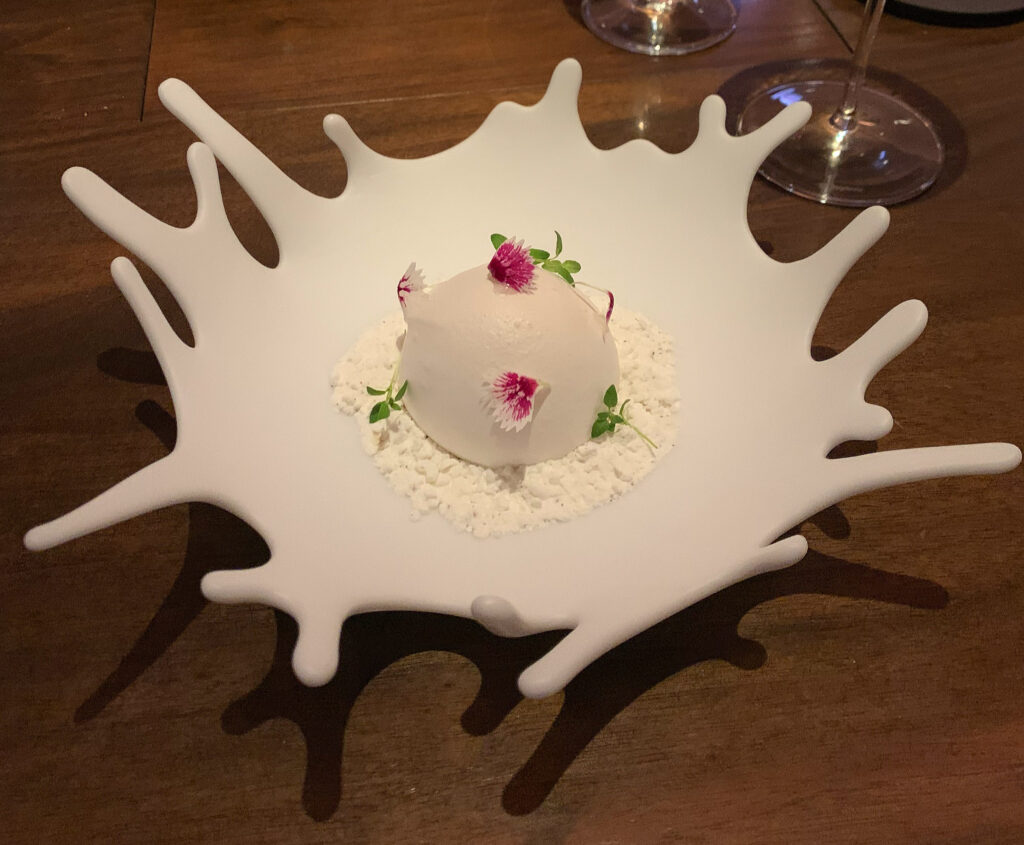
The next of the desserts, titled “Bergamot,” would come to replace the “Nori.” Rather than ice cream, sorbet, or granita, the preparation centers on a perfect orb of pavlova filled with a cream made from the titular fruit and some redcurrant jam. It sits atop a black pepper-flavored mochi cake that comes surrounded by thyme mousse and a black pepper meringue crumble.
Attacking the dish with your spoon, the pavlova’s brittle shell emits a satisfying crunch. The contents spill out over the meringue crumble, allowing you to plunge down through the mochi cake to build a complete bite. Reaching your tongue, the resulting combination is crisp, then creamy, then chewy, and—finally—more finely crisp. The accompanying flavor is predominantly bitter and tangy with some complicating spicy, woodsy notes drawn from the thyme and black pepper. Overall, this is quite an intriguing combination but just not hedonistic enough for you. No doubt, the technique on the pavlova is excellent—you just think the “Bergamot” would make more sense earlier in the dessert sequence (as something more of a palate cleanser) because, at this point, you are beginning to expect a more straightforwardly pleasing sweet.
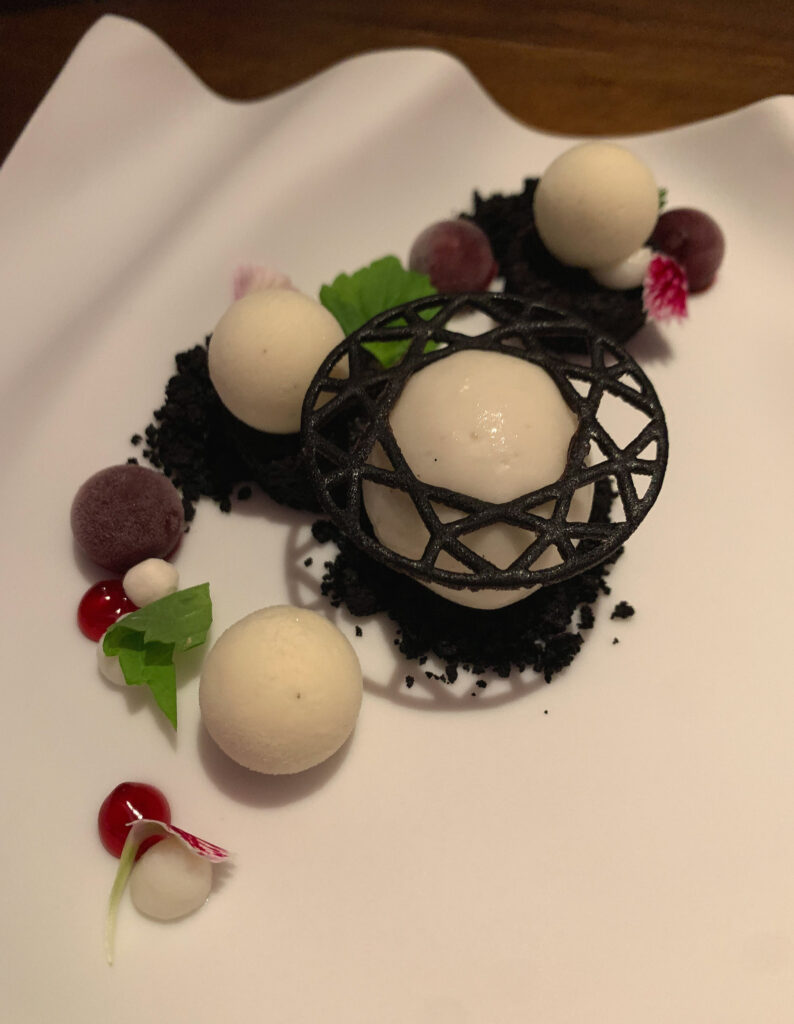
Right on cue, the following course—and the last of the tasting menu—looks to end the night on a more decadent note. “Cocoa,” as the preparation is titled, combines expressions of dark chocolate (via a crumble) and white chocolate (via a semifreddo) with buttermilk (rendered as an ice cream) and globules of a hibiscus-vanilla gelée. The whole presentation is laid out a bit like a garden, with the crumble acting as a “soil” that anchors the balls of ice cream and semifreddo that are joined by the occasional leaf or flower petal. In a manner reminiscent of the “Foie Gras” terrarium, approaching the dish means crashing through this carefully manicured world to arrange a perfect bite.
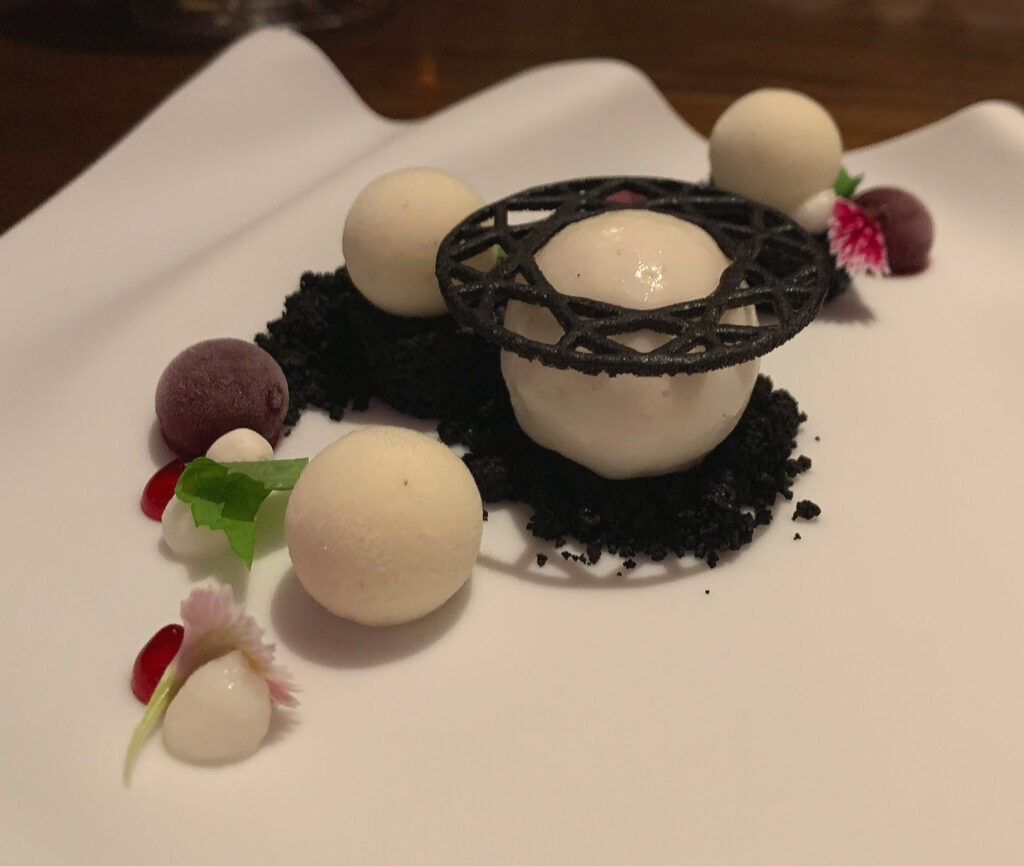
Doing so, you are left with a gradient of textures: the scoop of melting ice cream yielding to the creamier semifreddo, the even gooier gelée, and the crisp crunch of the crumble (a sensation that is also mirrored by a kind of chocolate halo that crowns the frozen buttermilk component). The varying densities of these diverse elements also ensure that their corresponding flavors strike the palate sequentially. The tangy-sweet buttermilk leads into the cream-flavored white chocolate, the fruity (also somewhat smoky) hibiscus-vanilla gelée, and—finally—the powerful, bittersweet notes of the dark chocolate. This progression seems almost like a deconstruction, for it marries a cocoa-less chocolate with some of chocolate’s classic supporting ingredients before subsuming them all into the second, cocoa-forward chocolate. Yet, in effect, the dish is actually an exploration and celebration of cocoa’s complexity—the many divergent notes that make for such a familiar pleasure—with a slow-building intensity that lasts through a satisfying finish. Ultimately, this course may need one or two more elements to really be memorable (you would also excise the hibiscus); however, it makes for the kind of pleasing (if a bit safe) end to the meal you are after.
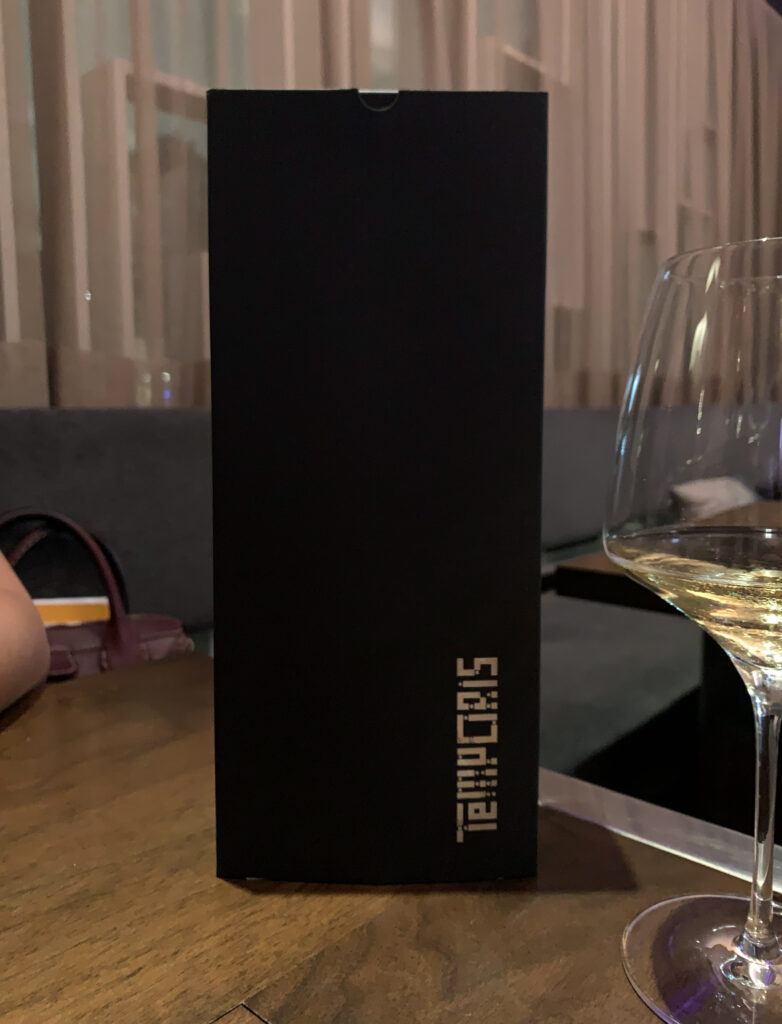
Having reached the conclusion of the tasting menu, you are rewarded with one final flourish. First, the captain comes to the table with a neat, Temporis-branded box for each guest. Sliding it open, you find branded menus (food and pairing), a wrapped chocolate brownie, a pouch of Rare Tea Cellar green tea, and a plastic shot glass. That latter vessel is filled with Persian watercress seeds that have been soaked in a growing medium. An accompanying card invites you to leave the glass by a window for a week—checking the moisture every few days—to grow microgreens of your own. Now, it may be tempting to speculate just what percentage of customers actually go through this trouble of cultivating this watercress. But, in an age when fine dining take-home treats have become increasing scarce, this is a unique touch that is true to the restaurant’s identity and, moreover, does not preclude receiving more conventional comestibles like the brownie and tea.
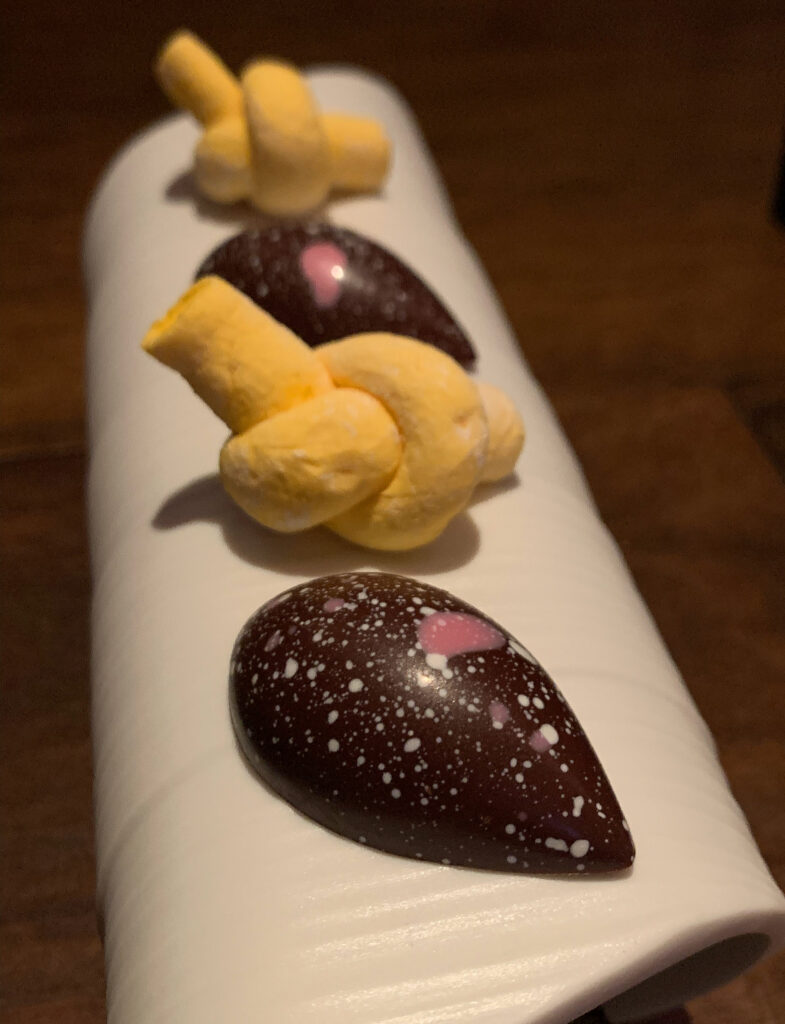
Concurrent with the arrival of this box of goodies, the captain also places a ceramic cylinder on the table that displays Paternico’s “Mignardises.” These have reliably included a mango-vinegar marshmallow “knot” and a kind of chocolate: first flavored with black cardamom then, later, with hōjicha (roasted green tea). The former bite somewhat calls a circus peanut to mind, displaying a powdery exterior with a faint, tart-sweet character on the palate. It is a good—if not superlative—marshmallow that is most impressive when you untie the knot to get a sense of how it was shaped. The latter bite, whether tinged with cardamom or tea, is equally serviceable. The chocolate, in emphasizing intellectual rather than hedonistic appeal, mostly serves to echo the darker qualities of the preceding “Cocoa” course.
Along with these two sets of gifts, you are presented with the check and the assurance that you may take your time in leaving. Alternatively, those who have prepaid for pairings through Tock will simply be reminded that they are free to depart whenever they like. Additional beverages are subject to the same 20% “service charge” (pre-tax) as the tasting menu, yet—upon processing payment—you are presented with a receipt that still includes a tip line. Diners paying fully through Tock are not given this option to provide additional gratuity, so the discrepancy should be kept in mind (even if you commend the restaurant for not concocting some reason—like charging for water or utilizing deposits—to put a tip line in front of every customer).
With everything settled and your take-home items in tow, you retrace those few steps that separate you from the host stand. Jorge, more often than not, is already waiting there to chat about your experience and bid you goodbye. Otherwise, Bonetti might engage the party for a moment so that the chef can finish what he’s doing and make an appearance.
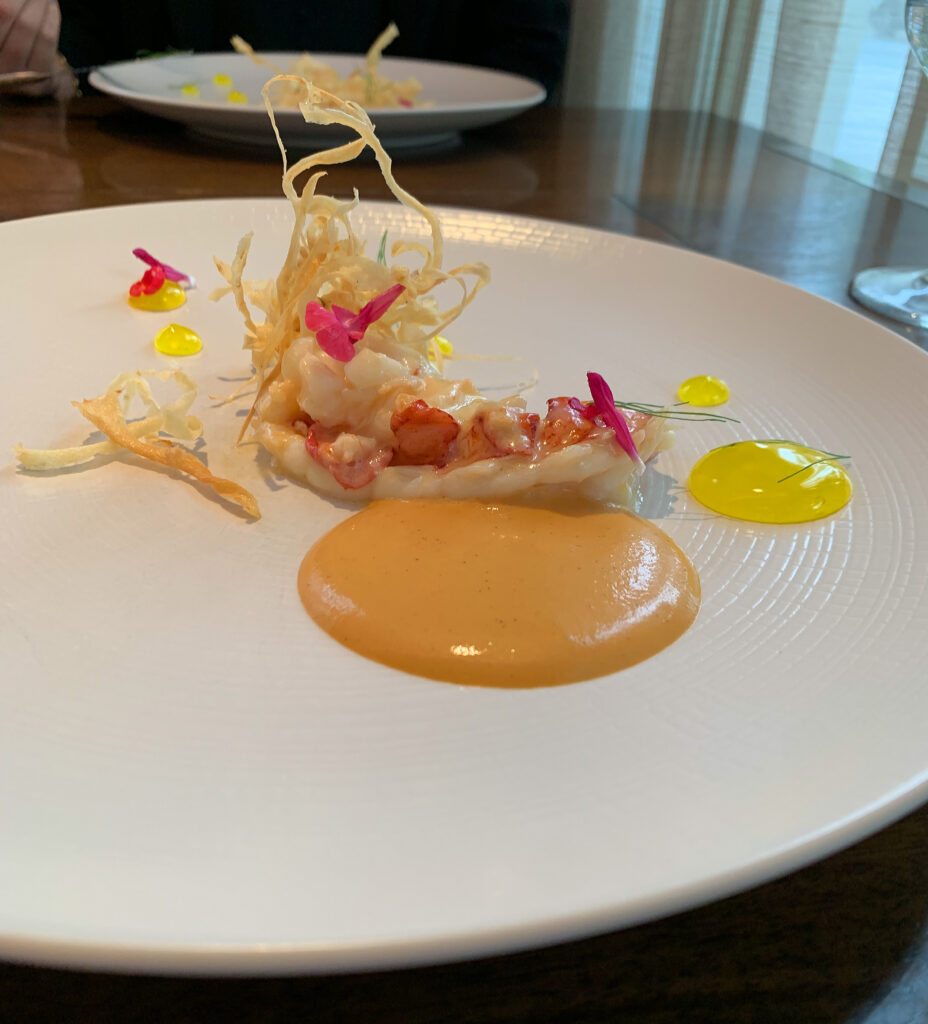
Temporis, perhaps more than any other avant-garde tasting menu in town (at least at the one-Michelin-star level), leaves you with a crystal-clear memory of what you have eaten. Of course, countless details are destined to be forgotten the moment they leave the server’s lips. Some of the kitchen’s more advanced techniques, too, remain impenetrable for those not in the trade. However, you simply cannot forget the concentration of flavor that distinguished dishes like the “Corn,” “Lobster,” “Iberico,” and “Apple” this evening.
Thus, talking to Jorge, it is hard not to gush. His menu, no doubt, has its weak points—the “Uni-Caviar Tart,” the “Foie Gras,” the “Dungeness Crab,” and a couple repetitive desserts—yet these are not clearly flawed or disagreeable creations. Almost all of them still make you think (only really being guilty of not rising to the same heights as the restaurant’s best dishes), and they tend to escape attention by the time you have your audience with the chef.
So, it feels natural to enthuse about the tenderness of the pork or the deep truffle flavor imbued in the baby corn. The peak-end rule ensures that these memories remain the most salient, and Jorge’s presence—humbly, patiently listening as if he expects criticism just as much as praise—provokes affection. He already visited your table at least once during the course of the meal. Now he stands before you, having dazzled your palate more than few times, with a quiet dignity free of even the slightest conceit. This, here, is the master craftsman you feel you can get to know. This, here, is the anti-celebrity chef: always behind his stove, always engaging the guest, making food that’s pretty but never as a substitute for substance.
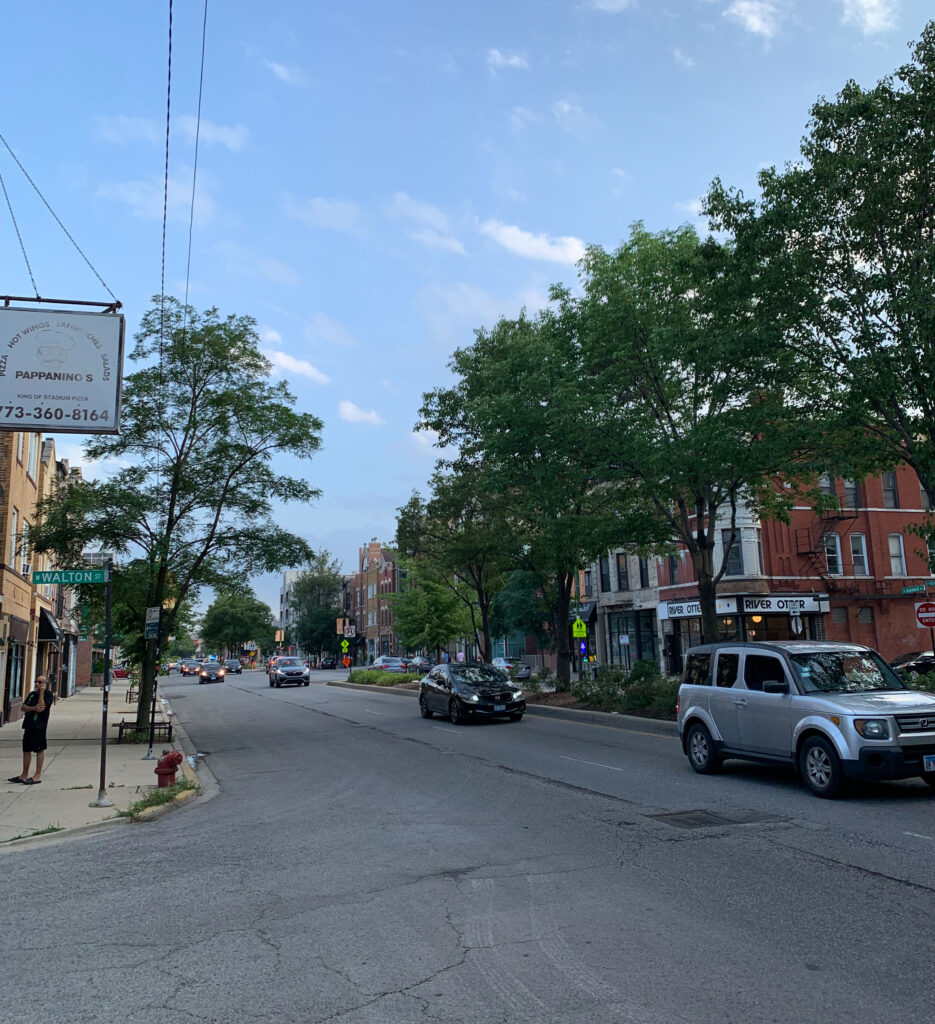
With a final few parting words, you pass through the vestibule, then the door, and find yourself back on that subdued stretch of Ashland Avenue. The “peak” of the restaurant’s best dishes joins with the “end” of the chef encounter to cement a positive impression. Temporis, being separated from the outside world by nothing more than a curtain, leaves you feeling that you have uncovered a neighborhood gem. But will it ever be known as an institution?
In truth, Bibendum’s recommendation most likely brought you here. Michelin might be the only reason, nearly seven years after opening, that you even know the restaurant exists. “Middle age” is rarely glamorous after all, yet the team makes up for it with their own dose of personality and a distinct culinary perspective.
Temporis is “contemporary American” with all its intricacy and none of the pretense. It offers abstract-looking plates in a sleek-looking space—an almost trite formula that could describe countless pricey concepts across the country—but leavens both elements with a sense of familiarity. You speak not only of Jorge’s forceful, nostalgic approach to flavoring, but of a small, close-knit team that is free from the stink of any suffocating corporate culture—that feels every bit as though they are still a group of friends helping a pop-up come to life.
These are aspects of a restaurant’s identity that are almost impossible to communicate to the public. That lack of corporate-enforced precision—faceless, uncanny hospitality in the Alinea/Ever mold—may even represent a subversion of what some diners associate with “excellence.” So, Temporis is left competing on the same playing field as every other concept: posting pretty pictures on social media (and reposting those from guests) while the depth of the experience remains unknown. The restaurant is reduced to its Michelin star and its price tag, becoming just one of at least a dozen interchangeable options that fit into the calculus of the discerning consumer.
There, Temporis seems destined to suffer. It sells one of the most expensive Michelin-starred tasting menus but lands in that undefinable “contemporary American” genre and lacks any easily digestible branding. Distinguishing factors like the hydroponic garden, the “hidden cubbyhole” in the table, and the fancy LED lighting have all receded into the background. Even the name of the restaurant—that idea of “the passage of time”—hardly remains relevant.
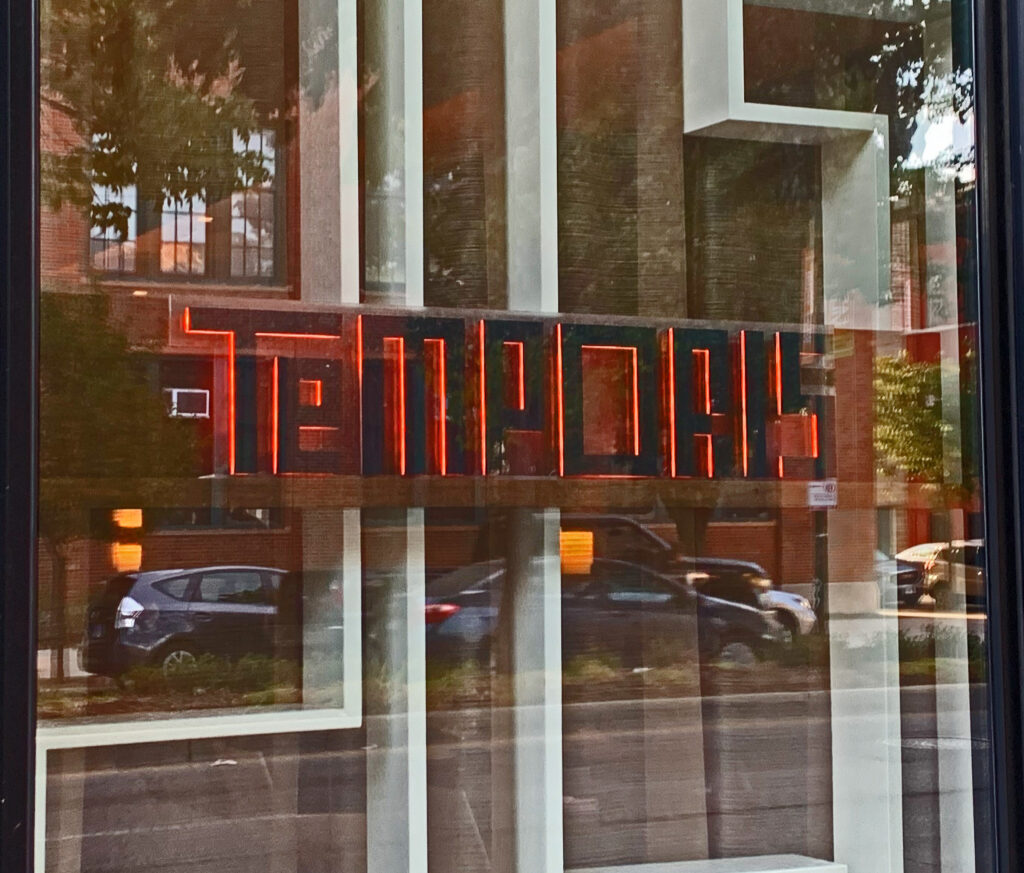
The only real “influencer bait” Temporis has to offer—lacking any particularly photogenic atmosphere or easy categorization into some category of trendy ethnic cuisine—is the actual design of its food. Jorge’s cooking, as you have mentioned, calls his time at Grace to mind. It represents a $215 counterpoint to the $325 menu at Ever and offers a vision of molecular gastronomy that is a bit more luxe than Schwa ($165-$195) or EL Ideas ($185) while still remaining more grounded than Alinea ($315-$495). But how about North Pond ($125), which is now under the command of an ex-Grace chef and can boast what is arguably the city’s finest setting? And Esmé ($235-$265), which bases each of its rotating tasting menus on a distinct artistic collaboration?
Yes, the list of “contemporary American” restaurants in Chicago with a molecular gastronomy bent (or, you might say, a direct Alinea/Grace lineage) is short but consequential. You might even throw Smyth ($285) and Oriole ($295) into the mix (though you think their cuisines have more in common with each other than those “smoke and mirrors” three-Michelin-star properties). The point, being charitable, is that Temporis must distinguish itself from four direct competitors within its genre. At least two of these (North Pond and Esmé) have unique, identifiable selling points while EL Ideas and Schwa benefit somewhat from their unconventional approaches. Temporis finds itself seeming more traditional by comparison (Les Nomades?) despite the technical overlap with Grace. This is actually a great selling point (if, admittedly, more of a subtle one). For, at what point do conspicuous consumers simply decide to spend an additional $100 and experience this kind of food at one of its more famous fountainheads?
As a pricier one-Michelin-star concept within the “contemporary American” genre, Temporis not only satisfies expectations but actually excels. Despite the lack of brand narrative, the restaurant feels slick and is filled with warm interactions (including and especially with the chef himself). Further, the range of wine options for entry-level and devoted drinkers alike is highly appealing, marrying quality and value in a way you must admire. Sure, the selection could be expanded upon further—and ordering the “Grand Reserve Pairing” (instead of bottles) felt like a mistake—but this is generally a rewarding place to imbibe.
Jorge’s food, first and foremost, fits the bill visually. It misses that extra layer of precision and novelty—for better or worse—that characterizes Duffy’s work at Ever. However, it encapsulates some of the earlier Grace style and does so in a minimalist “contemporary American” environment that facilitates seeing it applied (versus, say, César Murillo reflecting a more naturalistic side of that style at North Pond). Temporis has clearly invested in the right kind of plateware for the job, and the chef wields his various foams, gelées, and puffed elements in a confident, painterly manner. The resulting compositions are not only pretty, but tactile and engaging when it comes time to dig in.
More substantively, the cuisine at Temporis ticks all the totemic luxury boxes by utilizing caviar, uni, foie gras, crab, truffle, lobster, ibérico, and wagyu across the menu (alongside other prized morsels of razor clam, turbot, duck, and the like). This is a laundry list of the ingredients some diners might expect to see when spending $215. Their presence alone is enough to signal luxury (and communicate it later to one’s social media followers). Personally, you find that playing to these expectations saps a chef’s creativity, and some of these items (the caviar, uni, foie gras, and crab) were not utilized all that effectively.
Nonetheless, Jorge’s culinary style ensures that these ingredients still feel, in some way, fresh. This involves the aforementioned foams, gelées, and puffed elements with a particular emphasis on tangy, fruity, and herbaceous accompanying flavors. These kinds of combinations, iterated course after course, run the risk of exhausting your palate. But the chef smartly offers generous portions of each plate’s star component, allowing its texture and natural character to form a baseline that effectively contrasts these bold notes. Thus, the “Fluke” and “Tomato,” despite their pronounced acid, still felt balanced.
Just when this style, applied over and over, threatens to seem predictable and one-note, Jorge displays an extra dimension to his cooking. His “Corn,” “Lobster,” and “Iberico” each approach their star ingredient worshipfully, pursuing a purity of texture and depth of flavor that transcends the fruity, herbaceous convention to dial in on total decadence. In this manner, there is a clear transition from the menu’s light, bright openers to more satiating, deeply pleasing middle and ending savory courses. And, because of this, you can abide by the chef’s use of all these luxury ingredients: he does not feature them in a thoughtless, hands-off fashion as symbols of “fine dining” but aims to blow you away. Yes, Jorge marries the Grace techniques and style with an understanding of the eye-rolling pleasure—the profound satiation that a superlative expression of something familiar yields—consumers seek at this level.
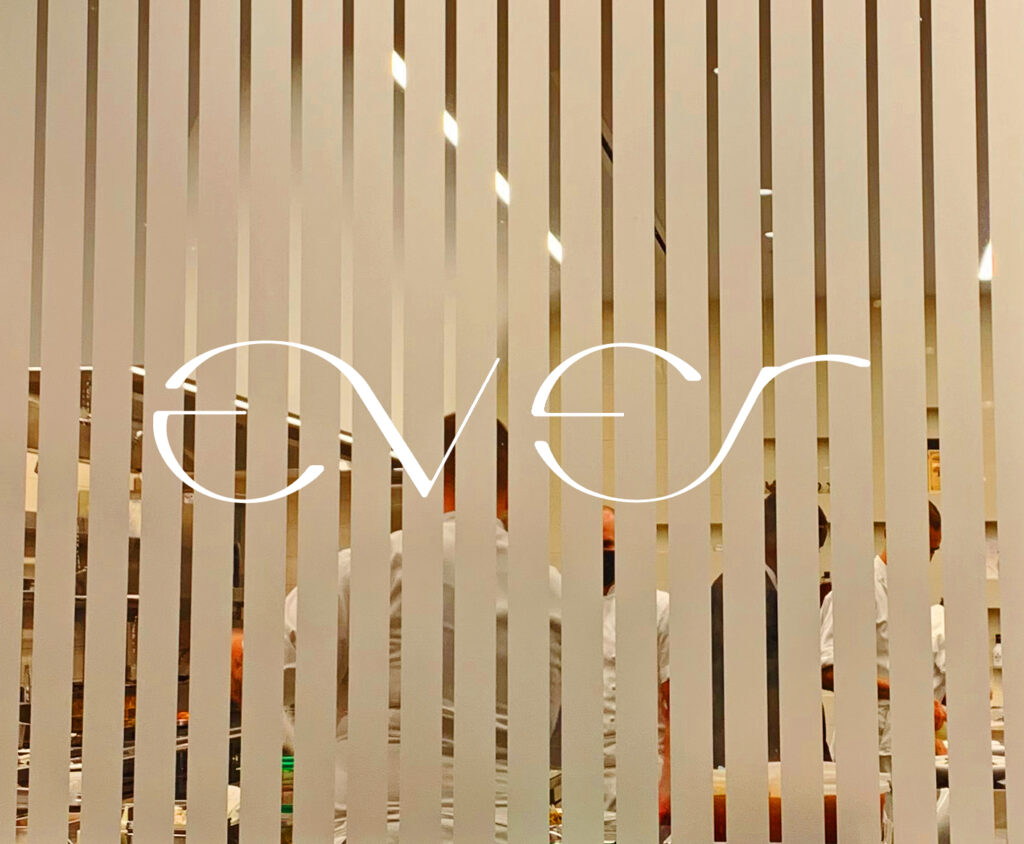
For this reason (and based on your extensive experience dining at Ever), you think Jorge—today—executes Duffy’s cuisine more effectively than Duffy himself. To be fair, Temporis may lack the same trappings of novelty and polish, but it operates with an essential degree of restraint. It serves food that the mainstream Chicago customer can ultimately still recognize and enjoy rather than getting lost, up its own ass, serving tortured, looks-better-than-it-tastes cuisine geared toward international palates and Michelin inspectors. You think this difference is especially stark when comparing how the two chefs approach their principal proteins.
Turning to dessert, Paternico can really be proud of the “Apple” creation even if some of her other dishes do not quite rise to the same level of being memorable. Nevertheless, the pastry chef’s compositions clearly match Jorge’s plates both visually and in the balance of flavors they pursue. This synergy helps to affirm a distinct and cohesive Temporis style (even if you would like to see the hedonism of the “Corn,” “Lobster,” and “Iberico” translated into dessert). Some sort of bread course, too, would also certainly be nice, but it is not quite clear where such an offering would fit. (Ever, for what it’s worth, deploys multiple small loaves throughout the meal to great effect.)
You also must praise Temporis’s pacing, with the kitchen serving 11 courses in exactly two hours (door to door) when allowed to operate at full steam. Surely, in this aspect, the restaurant benefits from its 20-seat format; however, this is still a testament to Jorge’s command of his recipes and sense of timing. The team would, just as easily, let you sit for three hours while enjoying your meal. But any diner who finds that tasting menus leave them feeling hungry knows that sharp pacing dramatically improves your perception of dainty, imaginative fare. It transforms the dire exercise of waiting 20 or 30 minutes between a few meager bites into a flowing experience where each subsequent course surprises you at just the right time.
The counterpoint to the impressive pacing, if you are being particularly critical, is that Jorge’s menu did not change all that much over the 45-day period comprising your visits. In essence, the “Iberico” replaced the “Duck Breast,” and the “Bergamot” replaced the “Nori.” Given the high quality of the former dish, which you sampled on the very first day it was offered, there is perhaps some benefit to the chef taking his time and serving only fully-formed ideas. It ensures the strongest preparations have a chance to please the greatest number of guests, rewarding people who come through the door rather than treating them as guinea pigs. To be clear, you prize dynamism highly—and Jorge has a repertoire of older dishes he can draw upon to reward regular customers—but a restaurant fighting for relevance can be excused for putting its best foot forward rather than expecting first-time diners to appreciate the flux of ceaseless experimentation.
And, in the final analysis, that’s what it comes back to: the pain of “middle age” and the fight for self-definition—redefinition—after the departure of two chefs and a pandemic. The “contemporary American” (also referred to as “progressive American” by the restaurant) genre promises plenty of freedom under a label that—however hard to define—the public is more inclined to find palatable. Temporis has already transformed from a Les Nomades-inflected newcomer into a serial Michelin star winner whose cuisine takes its cue more from Grace. Along the way, distinguishing elements like the hydroponic garden, “hidden cubbyholes” in the table, and changing LED lighting have given way to an experience that is more classically focused on fine wine and food.
This shift, by and large, is a positive thing. Jorge’s food has the abstract, minimalist aesthetic necessary to snare consumers who have been exposed to molecular gastronomy’s more infamous practitioners. The desire to sample that kind of cuisine (filtered through some personal value equation) gets people to buy the ticket, and they find in the chef’s menu a sense of artistry that does not compromise on achieving deep satisfaction. They find, alongside that, a rewarding beverage program and personable service staged in a sleek, intimate setting. It all amounts to a surprisingly traditional expression of fine dining—according with touchstones of ingredient recognizability, portion sizing, and flavor composition—invigorated by some measured flashes of modern “molecular” technique.
Yet it is hard to communicate these subtleties to those who have not experienced the restaurant firsthand. Temporis—beyond the simple facts of ratings and price—is judged in a visual domaine. There, its cuisine is well-equipped to catch viewers’ eyes, but it must, today, contend with a constant deluge of food content. It must compete with concepts that have packaged their tasting menus, from the ground up, to go viral. It must fight to be heard amid a sea of brands that have built strong, streamlined identities on the basis of cultural influences that find, in this atomized society, readymade audiences. Further complicating matters, you would even argue there is an entrenched demographic (maybe even a growing one) that would disparage this kind of “tweezer food” as running contrary to notions of “authenticity” that are now so prized.
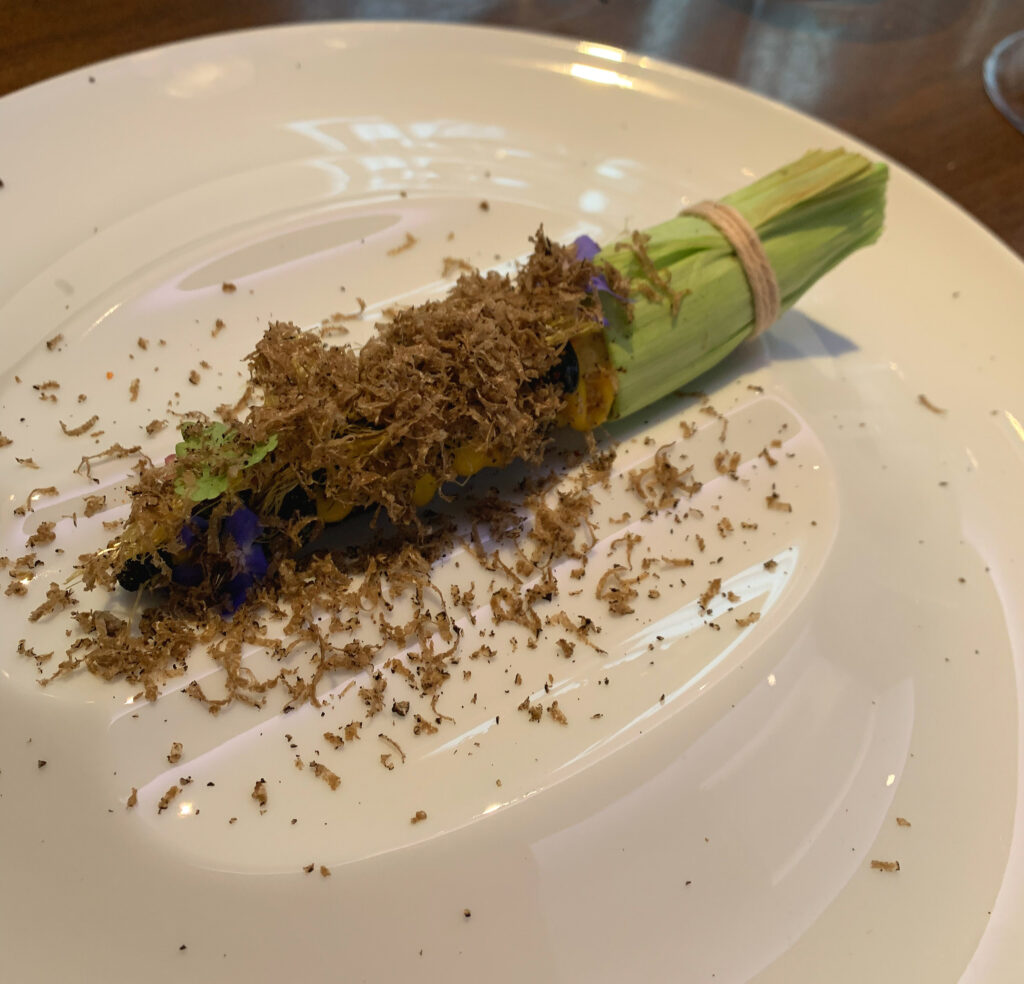
Ironically, Jorge’s mastery of flavor in dishes like the “Corn” and “Iberico” would likely make these skeptics into believers. But, in this purely visual domain, intensity of flavor cannot be adequately communicated. The viewer scrolls on in disgust, or, at best, they are enticed and begin some further investigation of Temporis’s value proposition. There, still, it is hard for any sense of the deeper, visceral quality to come through.
Building on the foundation that Temporis already has in place, you are confident that Jorge and Paternico, with enough time and support, can fulfill the potential hinted at by their best preparations. They can raise each course to the level of the “Corn,” “Lobster,” “Iberico,” or “Apple” and deliver an experience that leaves customers clamoring to come back—to shout from the rooftops that this “contemporary American” restaurant, relative to all others, is batting 1000.
But this process can only be fueled by robust patronage, which empowers further experimentation and growth. Otherwise, the restaurant finds itself in a defensive posture: clinging to its hits and looking to make them more accessible (via offerings like the abridged five-course menu) rather than charging forward toward newer, greater recipes.
To be fair, you like the shortened $135 menu, yet it remains a stopgap. Beyond continuing to put in the work, day by day, to refine its recipes, Temporis must reclaim some kind of clear identity or narrative to really shine. This would serve to complement the natural visual appeal of Jorge’s food by orienting consumers’ understanding of the restaurant around a simple, digestible idea that is more specific than “contemporary” or “progressive” American cuisine. It would get more people through the door, allowing them to sense the depth of quality that cannot easily be communicated through social media.
North Pond has its surrounding natural setting, Esmé has its artist collaborations, Valhalla has its food hall chef’s counter, EL Ideas has the BYOB “dinner party” feel, and Schwa—infamously—takes that same idea still one step further. Meanwhile, Alinea, Ever, Oriole, and Smyth can each make a real claim at being “the best” (even if the ultimate truth of such a claim is a lot harder to untangle).
Where does Temporis fit among these peers in the same genre? It has its hydroponic garden, which may have been novel at the time of opening but no longer seems so now that nearly every fine dining restaurant grows its own microgreens. There’s also the “Grand Reserve Pairing,” which marks Temporis as a wine destination but did not measure up (however good the rest of the program is) to your expectations.
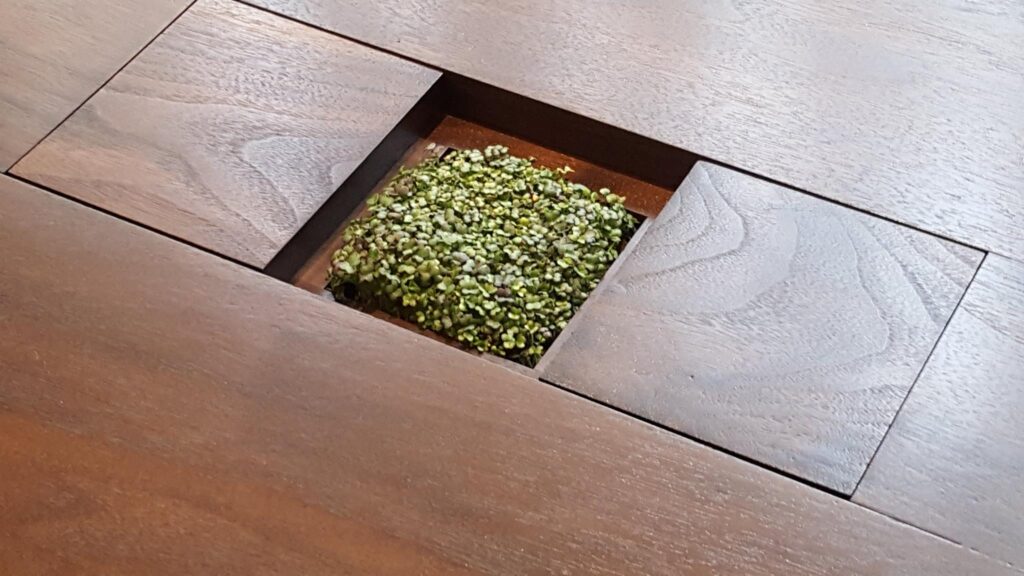
Neither of these markers of identity are enough to move the needle. Nor do you think restoring the use of those “hidden cubbyholes” in the tables is necessarily a silver bullet. Still, they form an element in the restaurant’s design that already exists, one that might no longer serve its original purpose (housing microgreens) but can at least form a vessel for something surprising and unique. Does Temporis want to be known as the restaurant that hides food in the center of the table? No, maybe that’s gimmicky, but at least it’s distinctive. And, more generally, there might be a way to use these compartments as part of presentations that construct some kind of signature, viral appeal.
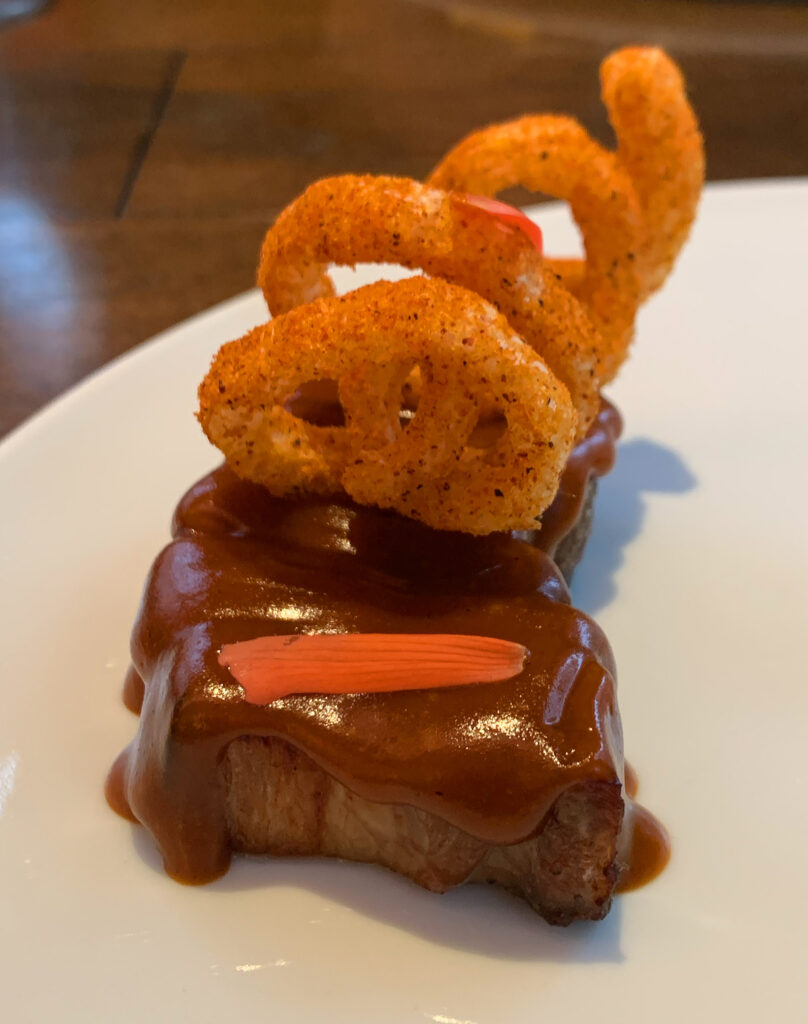
Otherwise, you still find yourself coming back to the “Corn” (with its elote inspiration) and the “Iberico” (with its Dr. Pepper / American barbecue influence). These courses were not only deeply satisfying and nostalgic but embraced a high/low juxtaposition that naturally grounds Jorge’s abstract, minimalist visual style. No doubt, molecular gastronomy has been applied to comfort, “junk,” and street foods for decades. Yet, how many Chicago diners were around to taste the food at Trio and during the early days of Alinea? And, wouldn’t they—along with a new generation of budding gastronomes—like to see these kinds of nostalgias expressed, once more, through another chef’s lens?
Embracing these influences might place Temporis in more direct competition with EL Ideas and Schwa, where this kind of culinary “slumming” has lived on. However, Jorge’s visual style is still rather singular, and adapting it to more humble and beloved forms could be the key to finding some subversive, viral appeal.
These ideas do not quite amount to a narrative—and just what narrative does the “contemporary American” genre really allow for other than the chef exhibiting their full range of influences? Nevertheless, they represent possible angles to exploit in order bridge the gap between mere exposure (via social media) to Temporis’s food and some comprehension of what exactly makes the restaurant unique.
Any deeper sense of meaning—the kind that makes a fine dining experience transcendent—can only come from the chef obsessively pursuing their own proclivities. Still, fleshing out these kinds of organizing principles and putting them in the diner’s mind can actually empower greater creativity by better managing expectations. They would help to carve out the restaurant’s niche and shield it from cutthroat comparisons to the newer or cheaper or more differentiated tasting menus in town. They would provide a platform on which the concept could thrive for another seven years without relying so heavily on Michelin’s good word.
For, Temporis is an admirable, mature restaurant that just needs more love and attention to reach its full potential. Fostering that support, when all the opening limelight has worn off, still proves to be one of the industry’s hardest battles. And yet, the team here is up for the fight should Chicagoans given them the chance. You undoubtedly felt rewarded for doing so.




